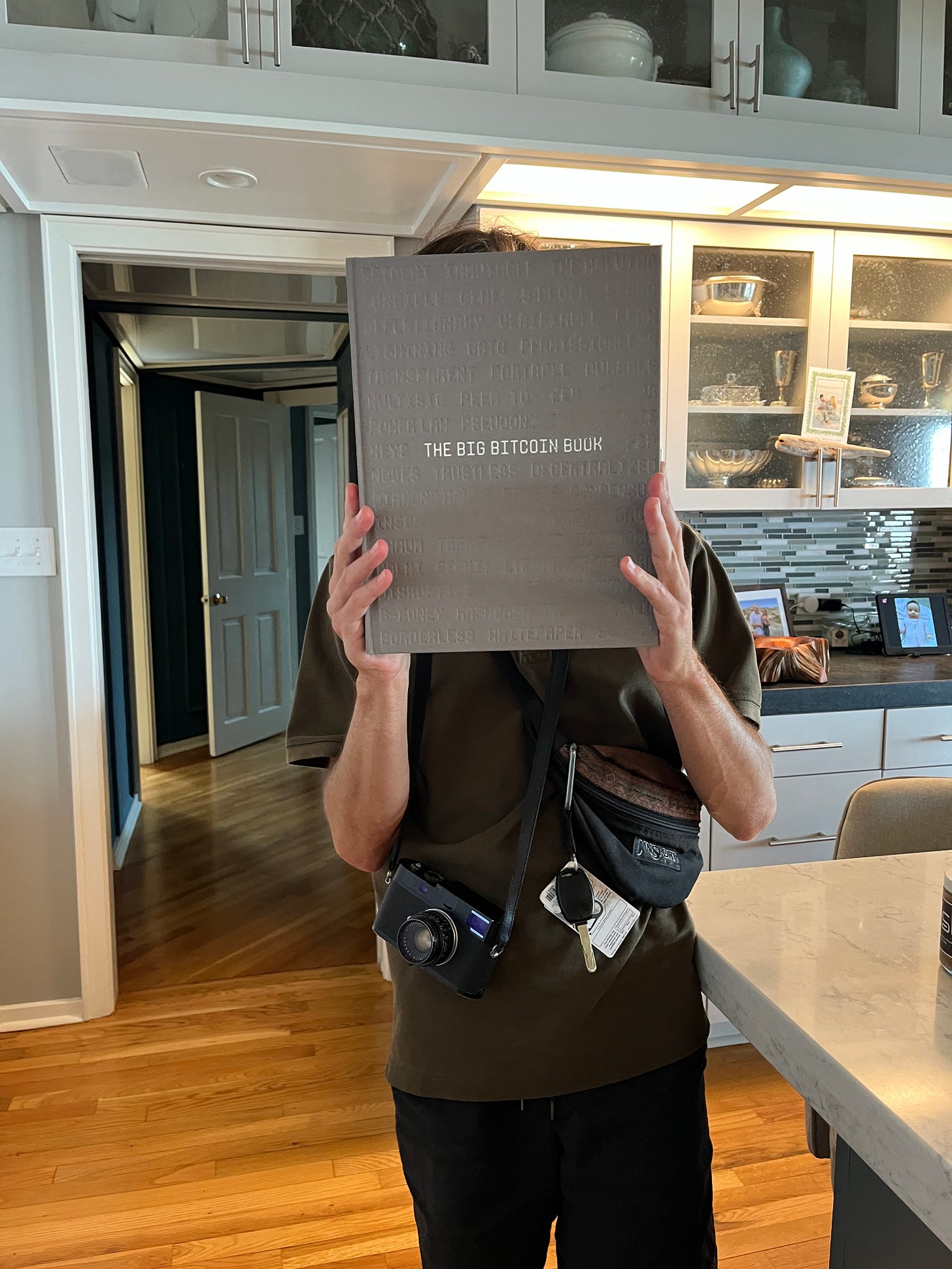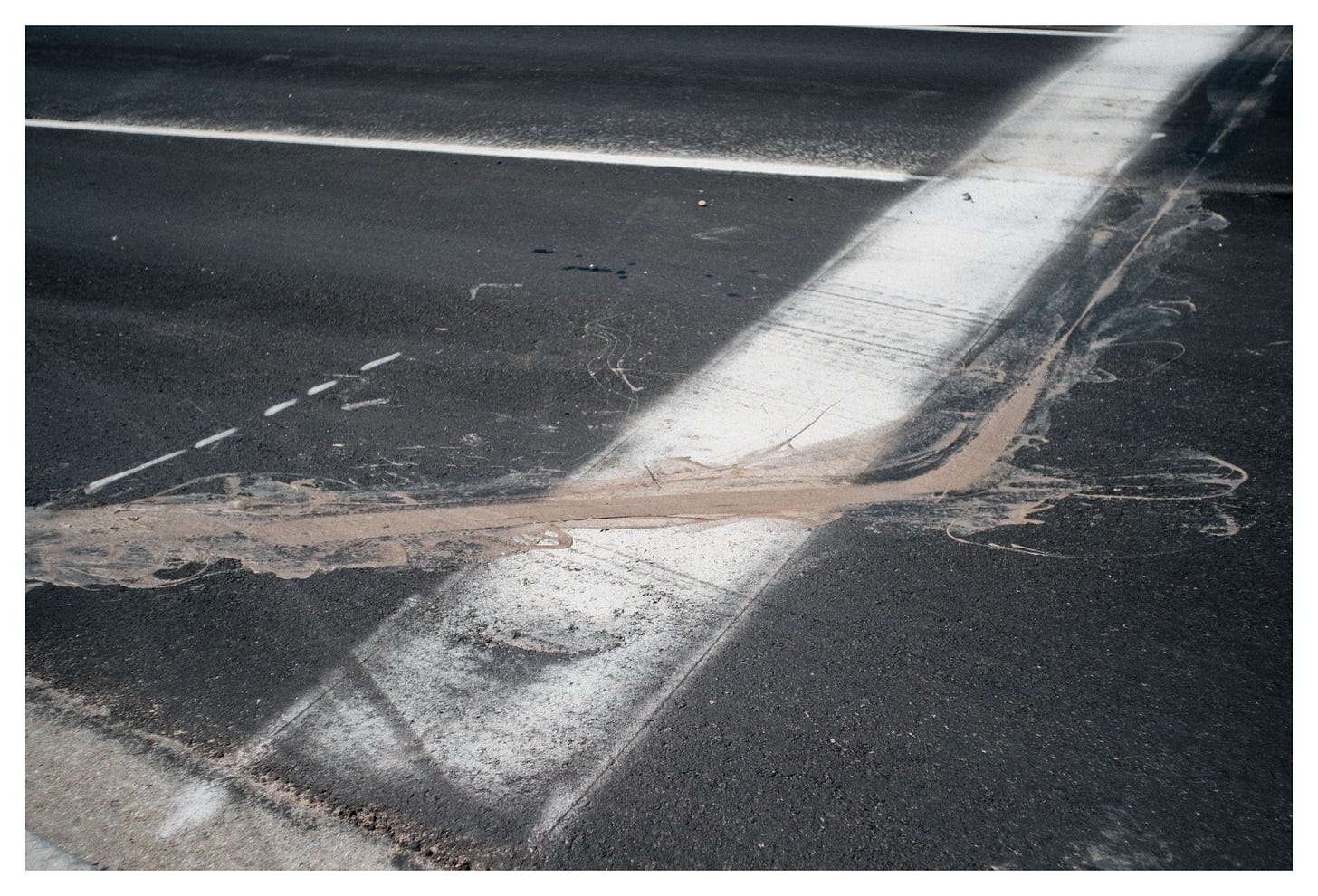-
 @ cae03c48:2a7d6671
2025-05-28 19:00:53
@ cae03c48:2a7d6671
2025-05-28 19:00:53Bitcoin Magazine
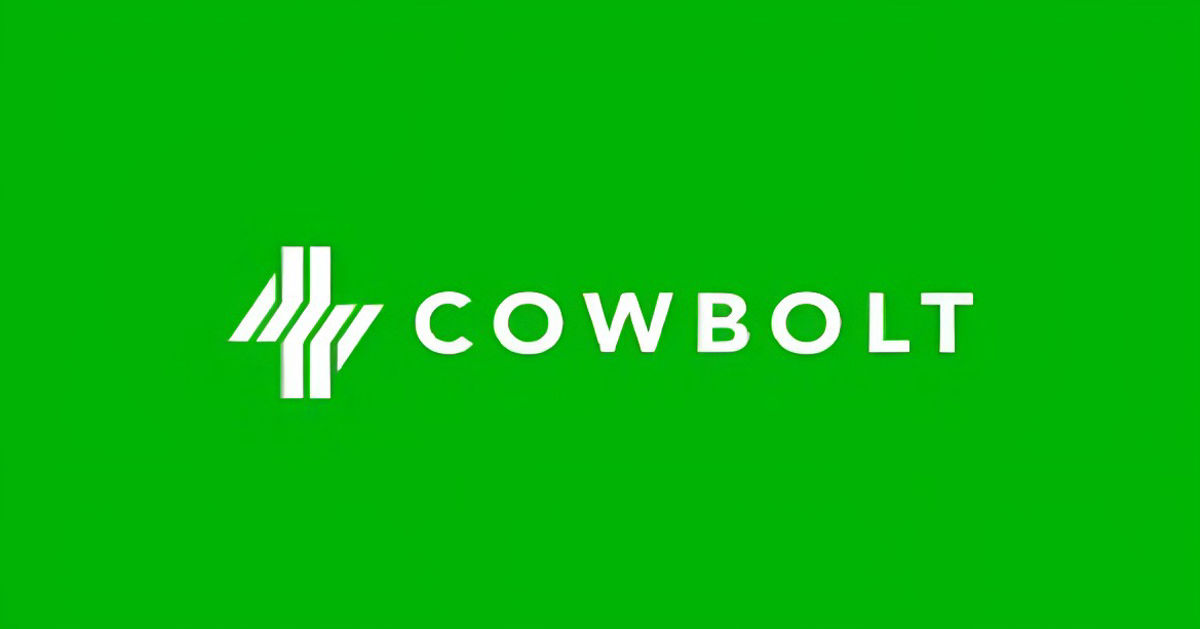
Cowbolt Announces Their Mission to Make Bitcoin Familiar to EverybodyToday at the Bitcoin Conference in Las Vegas, Cowbolt, an app that lets you split expense payments and settle in bitcoin, will launch their mission: turn peer-to-peer payments into a Bitcoin onramp, starting with family and friends.

Cowbolt will let their clients split costs and settle instantly using Bitcoin and USDT, with no middlemen, no bank friction and with self-custody. They will try to convert everyday transactions into Bitcoin adoption.
“We believe the most powerful onramp to Bitcoin isn’t an exchange — it’s people,” said the co-founder of Cowbolt Daniel Ekström. “That’s why we built Cowbolt. For friends, not hedge funds.”
What Cowbolt will bring to the table:
- Split and settle.
- Keep your keys.
- Fast and trusted.
- Works across borders.
The app is already being used for remittances, group travel, and day-to-day payments. It’s designed to be like a modern fintech app and will be available for iOS and Android.
“Building Airbnb taught me that when design is simple and gets out of the way, people do amazing things,” stated the ex-Creative Director at Airbnb & co-founder Cowbolt Tony Högqvist. “That’s the point here too. Not to store bitcoin in an ETF, but to use it between people. Effortlessly. Among teams, friends, families — every day.”

This post Cowbolt Announces Their Mission to Make Bitcoin Familiar to Everybody first appeared on Bitcoin Magazine and is written by Oscar Zarraga Perez.
-
 @ 26769dac:498e333b
2025-05-28 18:56:30
@ 26769dac:498e333b
2025-05-28 18:56:30I am here too\ In the same space like you
In the same situation I'm in\ It's a matter of positioning
I cannot leave this place I'm in\ It was brought about\ By what's been happening
So please don't look at me\ For what I can or cannot do for you\ But look at what is happening for me\ And what is happening for you
Let's communicate\ Not orchestrate
Because there's something I wish to do\ And there's a place I wish to go to
And I'm sure that there is too\ In your heart a fire\ Known by only you
So let us listen, look and see\ For what's true for you\ And what's true for me
That we may act upon what's here\ In order for us both to take a step\ In the direction we wish to steer
-
 @ cae03c48:2a7d6671
2025-05-28 18:01:12
@ cae03c48:2a7d6671
2025-05-28 18:01:12Bitcoin Magazine

White House Executive Director Bo Hines Declares U.S. The Future Global Crypto SuperpowerIn a session at the Bitcoin 2025 Conference this morning titled “_Making America the Global Bitcoin Superpower“_, Bo Hines, White House Executive Director, Tyler Williams, from the US Treasury Department, and moderator Miles Jennings made one thing clear: the United States is going all-in on Bitcoin—and fast.
JUST IN:
 President Trump's Executive Director said "Bitcoin is the golden standard."
President Trump's Executive Director said "Bitcoin is the golden standard." "We're not gonna sell any Bitcoin that we possible have in the US government, period."
 pic.twitter.com/F6Dv2nUk9b
pic.twitter.com/F6Dv2nUk9b— Bitcoin Magazine (@BitcoinMagazine) May 27, 2025
“We are well on our way to becoming the bitcoin superpower of the world,” said Bo Hines. “This is something that is not partisan. This is a revolution in our financial system.”
Moderator Miles Jennings pointed to key regulatory steps currently in motion. “If the bill becomes law (and I hope it does) we will have quite an active role. The connective tissue between the legacy financial system and bitcoin, stablecoins, and everything else will really be paved with stablecoin legislation,” Jennings said.
Hines emphasized that, “Updating the payment rails is necessary and we are well on our way to achieving that.” He also noted that upcoming market structure legislation will define how intermediaries like exchanges and brokers are regulated and how digital assets are classified—either as securities or commodities.
“We want folks to innovate here,” Hines stressed. “We can’t be fearful of them walking into the SEC and getting a Wells notice before they get on the elevator.” He added that U.S. regulators are now encouraging crypto innovators to return: “Our message to folks who have gone offshore is: welcome home_._”
Williams highlighted that any new laws must reflect the unique architecture of decentralized finance. “Traditional markets are based on a principal-agent model,” he explained. “But crypto moves us toward a principal-to-principal structure.”
He noted that after regulatory support for the ETP marketplace, institutional Bitcoin adoption surged—and believes the same would happen again under stablecoin and market structure legislation.
The most bullish comment of the morning came from Hines: “Bitcoin is truly the golden standard… This is an asset that we should be harnessing on behalf of the American people. We want as much as we can possibly get.”
“We are going big on digital assets,” added Tyler. “You will certainly see the United States stepping out as the bitcoin superpower of the world,” Hines concluded.
You can watch the full panel discussion and the rest of the Bitcoin 2025 Conference Industry Day below:
https://www.youtube.com/live/3e3KE40r_WM?si=LCZcZeKbxi_iTk62This post White House Executive Director Bo Hines Declares U.S. The Future Global Crypto Superpower first appeared on Bitcoin Magazine and is written by Jenna Montgomery.
-
 @ 6a6be47b:3e74e3e1
2025-05-28 17:37:11
@ 6a6be47b:3e74e3e1
2025-05-28 17:37:11Hi frens! 🌞
How was your day? Mine was pretty great! Not to brag—I just try to see things in a positive light. Even when a day is “meh” or downright awful, I look for at least one good thing in it. Sometimes, let’s be real, there isn’t even one. Some days, weeks, or even months can just be tough. But even that shall pass.
✨ So, let’s try to focus on at least one good thing around us, or within us. Who knows—maybe a little magic can happen…
🎨 Today, I made time for some drawing on Procreate—yaaay! If you caught yesterday’s discussion, you know I drew a butterfly 🦋. Maybe with today’s drawing, you’ll be able to guess my next blog entry 👀
Today’s subject: Cytisus scoparius, better known as “Scotch broom” (or Scots broom).
🔍 I used to mix it up with gorse, but there are some telltale differences:
“Broom is similar to common gorse in size, shape and flower colour, but it lacks the spines and has short, flattened leaves and larger flowers.” — The Wildlife Trusts
⭐️Fun fact: I actually painted a gorse not too long ago for my Beltane post.
🚨 A word of caution though—don’t get too close! Scotch broom is harmful if eaten, so keep an eye out for your pets when you’re out and about, according to rhs.org.uk
🌼 I love spotting these bright yellow blooms by the highway or just outside town. That color is chef’s kiss—it really brightens up any drive!
💐That’s all for today. I’m super excited to hear what you think!
Take care and godspeed, my frens! 🚀✨
https://stacker.news/items/991324
-
 @ c1e6505c:02b3157e
2025-05-28 17:36:03
@ c1e6505c:02b3157e
2025-05-28 17:36:03I recently acquired a new lens:
1959 Leica Summaron F2.8 35mm LTM.
1959 Leica Summaron 35mm f2.8 LTM mounted on my Fujifilm Xpro2 with LTM adapter made by Urth.
Technically, it was a trade. I helped a fellow Bitcoiner set up their Sparrow Wallet, Nostr stuff, and troubleshoot a few wallet issues, and in return, they gave me the lens.
It all started at a local Bitcoin meetup I went to about a week ago - my second time attending. I recognized a few faces from last time, but also saw some new ones. These meetups are refreshing - it’s rare to speak a common language about something like Bitcoin or Nostr. Most people still don’t get it. But they will.
Technology moves forward. Networks grow. Old cells die off.
During the meetup, someone noticed I had my Leica M262 with me and struck up a conversation. Said they had some old Leica lenses and gear at home, and wanted to show me.
Bitcoin and photography in one conversation? I’m down.
A day or so later, they sent me a photo of one of the lenses: a vintage Summaron LTM 35mm f/2.8 from 1959. I’d never seen or heard of one before. They asked if I could help them set up Sparrow and a Bitcoin node. In exchange, they’d give me the lens. Sounded like a good deal to me. Helping plebs with their setups feels like a duty anyway. I said, of course.
They invited me over - a pretty trusting move, which I appreciated. They had some great Bitcoin memorabilia: Fred Krueger’s The Big Bitcoin Book (even if the guy’s turned full shitcoiner), and some FTX sunglasses from Bitcoin 2022. Probably future collector’s items, lol.


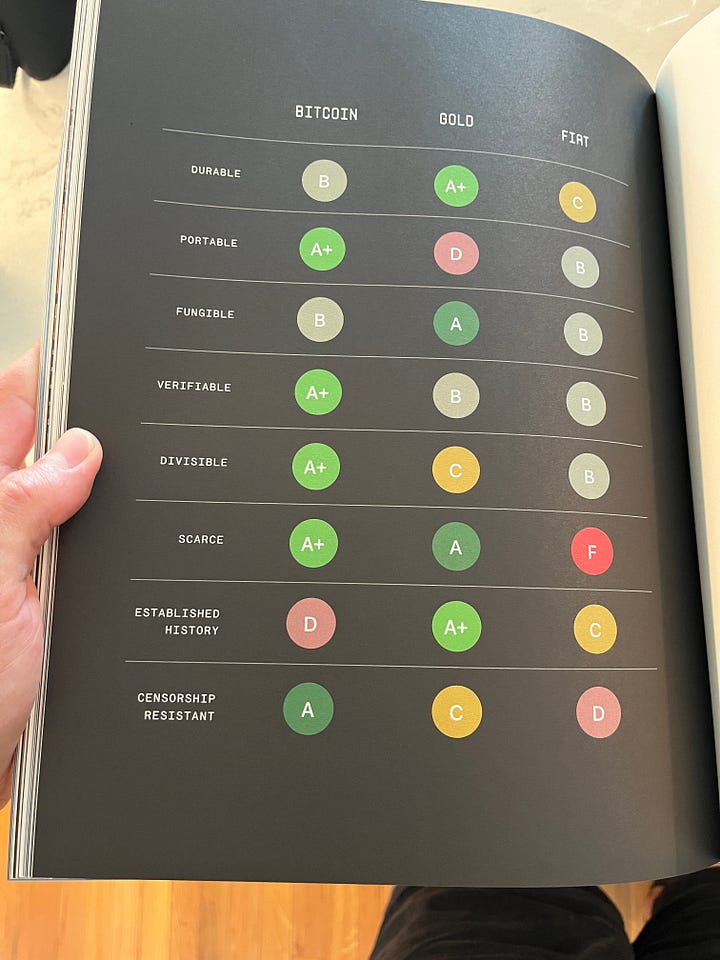
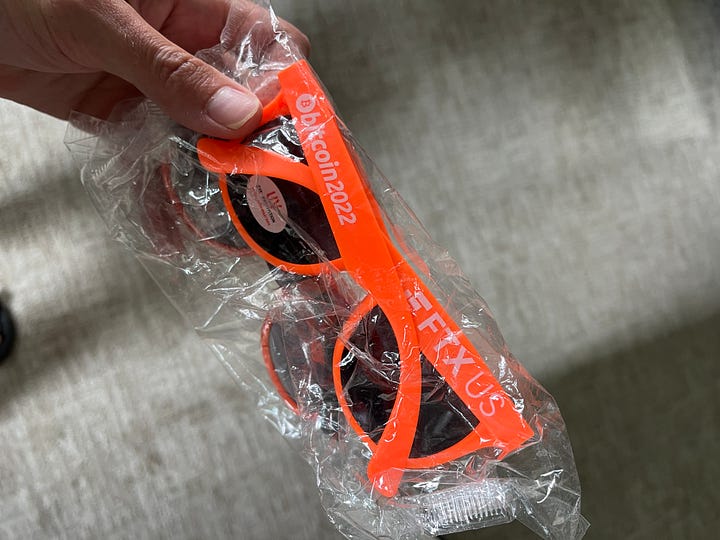
We headed upstairs to work on setting up Sparrow Wallet on their Windows machine. I verified the software download first (which you should always do), then helped them create a new wallet using their Ledger Flex. They also had an older Ledger Nano X. The Flex setup was easy, but the Nano X gave us trouble. It turns out Ledger allows multiple wallets for the same asset, which can show up differently depending on how they’re configured. In Sparrow, only one wallet showed—none of the others.
I believe it had to do with the derivation path from the Ledger. If anyone knows a fix, let me know.
After a few hours of troubleshooting, I told them I couldn’t really recommend Ledger. The UX is a mess. They’d already heard similar things from other plebs too.
I suggested switching to the Blockstream Jade. It’s a solid Bitcoin-only device from a trustworthy team. That’s what you want in a hardware wallet.
But back to the lens…
Since it’s an LTM (Leica Thread Mount), I couldn’t mount it directly on my M262. Luckily, I remembered I had an Urth adapter that fits my Fujifilm X-Pro2. I don’t use the X-Pro2 much these days—it’s mostly been sidelined by the M262 - but this was the perfect excuse to bring it out again.
To test the lens, I shot everything wide open at f/2.8. Nothing crazy fast, but it’s the best way to see a lens’s character. And this one definitely has character. There’s a subtle softness and a kind of motion blur effect around the edges when wide open. At first, I wasn’t sure how I felt about it, but the more I shot, the more I liked it. It reminds me of Winogrand’s work in Winogrand Color - those messy, shifting edges that make the frame feel alive. It also helps soften the digital-ness of the camera sensor.
The focus throw is short and snappy - much tighter than my Summicron V3 35mm f/2. I really like how fast it is to use. The closest focusing distance is about 3.5 feet, so it’s not ideal for close-ups. And with the Urth adapter on the X-Pro2, the focal length ends up closer to 40mm.
The only thing that threw me off was the infinity lock. When the focus hits infinity, it physically locks - you have to press a small tab to unlock it. I’ve seen others complain about it, so I guess it’s just one of those old lens quirks. I’m getting used to it.
All the photos here were taken around where I live in South Carolina. Some during bike rides to the river for a swim, others while walking through the marshlands.
I try to make work wherever I am. You should be able to.
It’s about the light, the rhythm, the play - and having the motivation to actually go out and shoot.
Lens rating: 7.9/10
I mainly shoot with a Leica M262, and edit in Lightroom + Dehancer
Use “PictureRoom” for 10% off Dehancer Film
If you’ve made it this far, thank you for taking the time to view my work - consider becoming a paid subscriber.
Also, please contact me if you would like to purchase any of my prints.
Follow me on Nostr:
npub1c8n9qhqzm2x3kzjm84kmdcvm96ezmn257r5xxphv3gsnjq4nz4lqelne96
-
 @ 9ca447d2:fbf5a36d
2025-05-28 17:01:11
@ 9ca447d2:fbf5a36d
2025-05-28 17:01:11Panama City may be the next Latin American city to adopt bitcoin, after El Salvador.
Panama City Mayor Mayer Mizrachi has got the bitcoin world excited after hinting that the city might have a bitcoin reserve. The speculation started on May 16 when Mizrachi posted a simple but powerful message on X:
Two words. That’s it. What makes it special is that it came after a high-profile meeting with Max Keiser and Stacy Herbert, two key figures behind El Salvador’s bitcoin strategy.
Keiser is an advisor to El Salvador’s President Nayib Bukele and Herbert leads the country’s Bitcoin Office.
El Salvador became the first country to adopt bitcoin as legal tender back in 2021. Since then, it has been building a national bitcoin reserve, currently holding 6,179 BTC worth around $640 million. It’s also using geothermal energy to power bitcoin mining in an eco-friendly way.

El Salvador’s bitcoin treasury — Bitcoin.gob.sv
Mizrachi’s meeting with Keiser and Herbert was about how Panama could do the same. While the details of the conversation are private, Keiser shared on social media that the two countries will play a big role in the future of Bitcoin.
“Bitcoin is transforming Central America,” Keiser wrote. “El Salvador’s geothermal & Panama’s hydro-electric will power the Bitcoin revolution.”

Max Keiser on X
Panama with its hydroelectric power could be a hub for green bitcoin mining.
Mizrachi has not announced a bitcoin reserve plan nor submitted a proposal to the National Assembly. But his post and public appearances suggest it’s being considered.
He will be speaking at the upcoming Bitcoin 2025 Conference in Las Vegas just days after his social media post. Many expect he will share more about Panama City’s bitcoin plans during his talk.
If Mizrachi pushes for a bitcoin reserve, he will need to work with national lawmakers to pass new legislation. So far, there is no evidence of that.
Even without a bitcoin reserve, Panama City is already going big on digital assets.
In April 2025, the city council approved a measure to allow residents to pay taxes, fees, fines and permits with digital currencies. Supported tokens are bitcoin (BTC), ethereum (ETH), USD Coin (USDC) and Tether (USDT).
To comply with financial laws, the city has partnered with a bank that instantly converts these digital assets into U.S. dollars. According to Mizrachi, this way it’s easier for residents to use digital assets and the city’s financial operations will be transparent and legal.
Another part of the meeting with El Salvador’s advisors was education.
Stacy Herbert confirmed that Panama City will be integrating El Salvador’s financial literacy book, “What is Money?” into their digital library system. The goal is to help students, teachers and the general public understand bitcoin and digital currencies in modern finance.
This is a trend in Latin America where countries are looking for alternatives to traditional banking systems. Inflation, economic instability and the rise of decentralized finance are forcing governments to look into new financial tools.
-
 @ cae03c48:2a7d6671
2025-05-28 16:00:58
@ cae03c48:2a7d6671
2025-05-28 16:00:58Bitcoin Magazine
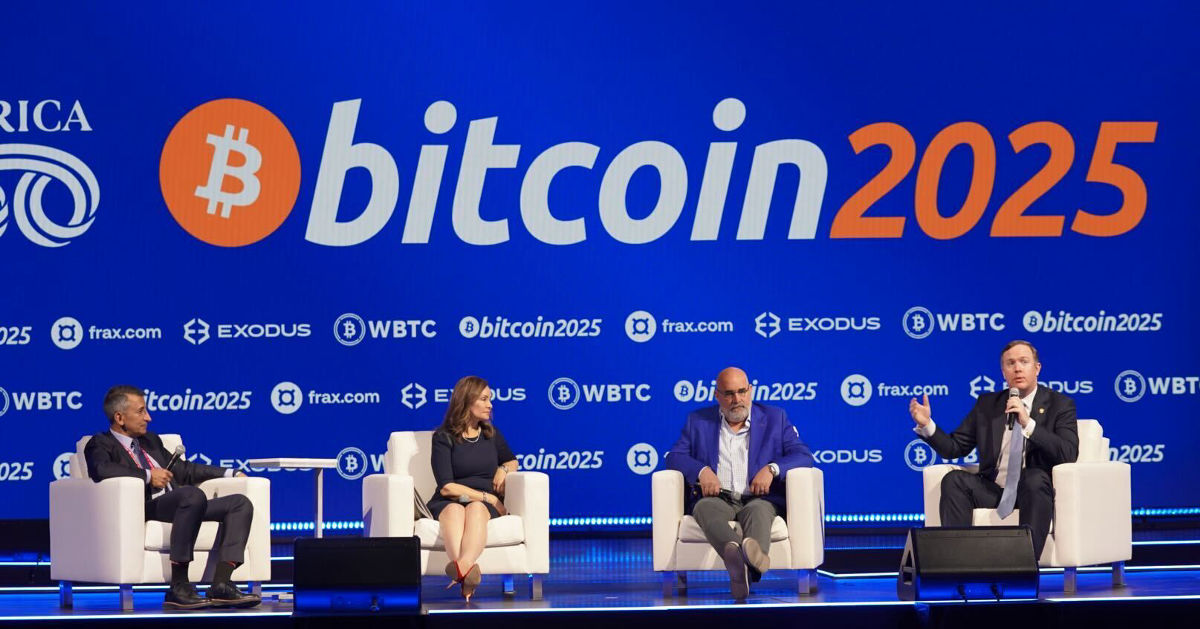
Bitcoin Is Here To Stay, Says Former US Treasurer Rosie RiosAt the 2025 Bitcoin Conference in Las Vegas, the Co-Manager of President Trump’s 2024 Campaign Chris LaCivita, Congressman Brian T. Jack, the Chief Policy Officer of Coinbase Faryar Shirzad and Former US Treasurer Rosie Rios at the Nakamoto stage discussed the 250th birthday of the United States, Bitcoin, freedom, and crypto.
Rosie Rios emphasized that consumer behavior is very hard to change unless there is a shock to the system. She said she is amazed by the momentum of the level of change that has happened during these four months in terms of giving that green light to innovation to actually happen.
“You are gonna hear me say a lot, the train has left the station. Bitcoin is here to stay. Blockchain is here to stay,” said Rios.
JUST IN:
 Former Treasurer of the United States Rosie Rios says, “#Bitcoin is here to stay.”
Former Treasurer of the United States Rosie Rios says, “#Bitcoin is here to stay.” “The train has left the station.”
 pic.twitter.com/M4noy7DPha
pic.twitter.com/M4noy7DPha— Bitcoin Magazine (@BitcoinMagazine) May 27, 2025
“It’s about freedom and what crypto represents on a national scale,” said Chris LaCivita. “This country was founded on the entrepreneurial spirit of Americans and we are on the forefront of establishing and formulating the future of currency.”

Jack mentioned that earlier this year, they started to use a congressional tool called the Congressional Review Act that will enable them to repeal any regulation Joe Biden’s administration put on any sector during his last months in office.
“One of the first laws that Donald Trump signed into law was the repeal of a very niche but interesting issue for some folks in the room,” stated Jack. “It was a policy that the CFPB thrust upon the industry in December that really helped them regulate, if you will, or over regulate payment processors. So a lot of the payment processors that process bitcoin, process crypto, they were going to be under these incredible burdens by CFPB.”
“The eyes of the world are watching,” commented Rosie. “We are setting the tone for what happens not just in our history but for the future and for all of us this is the American dream. This is about the values of which our country was founded.”
“For Bitcoin and Blockchain in general whoever creates that dominant digital infrastructure will set the tone for the whole global financial system and it starts here literally at this conference with this leadership with this President moving forward,” stated Rosie Rios closing the panel.
This post Bitcoin Is Here To Stay, Says Former US Treasurer Rosie Rios first appeared on Bitcoin Magazine and is written by Oscar Zarraga Perez.
-
 @ da8b7de1:c0164aee
2025-05-28 15:42:22
@ da8b7de1:c0164aee
2025-05-28 15:42:22Nemzetközi nukleáris energetikai hírek
Új amerikai kis moduláris reaktor engedélykérelem
A Tennessee Valley Authority (TVA) benyújtotta az Egyesült Államok Nukleáris Szabályozó Hatóságához (NRC) az engedélykérelmet egy GE Vernova Hitachi Nuclear Energy BWRX-300 kis moduláris reaktor (SMR) megépítésére a Clinch River telephelyen. Ez jelentős lépés az új, fejlett nukleáris technológiák bevezetésében az Egyesült Államokban, és jól mutatja, hogy az SMR-ek egyre fontosabb, rugalmas és skálázható tisztaenergia-megoldássá válnak[world-nuclear-news.org].
Amerikai elnöki rendeletek a nukleáris bővítés felgyorsítására
Donald Trump amerikai elnök négy elnöki rendeletet írt alá, amelyek célja a reaktorengedélyezési folyamatok gyorsítása, a hazai urántermelés növelése és a fejlett nukleáris technológiák bevezetésének felgyorsítása. Az új irányelvek ambiciózus célokat tűznek ki, például az amerikai nukleáris kapacitás megnégyszerezését 2050-re, az NRC számára az engedélyezési idő 18 hónapra csökkentését, valamint szövetségi területek kijelölését új nukleáris létesítmények számára. Ezeket a rendeleteket az „amerikai nukleáris reneszánsz” alapjának szánják, különös hangsúlyt fektetve az AI-ipar energiaigényeinek kielégítésére és a hazai gyártás újjáélesztésére[nucnet.org].
Iparági optimizmus és globális befektetési trendek
Az iparági vezetők egészséges és optimista kilátásokról számolnak be a nukleáris energia terén, kiemelve olyan aktív projekteket, mint a TerraPower Wyomingban, az X-energy és a Dow együttműködése, valamint a Westinghouse tevékenysége Lengyelországban. Különösen nagy az érdeklődés a magánbefektetések iránt a magas dúsítású, alacsony dúsítású urán (HALEU) előállítása terén, illetve annak lehetősége iránt, hogy a Világbank elkezdjen nukleáris projekteket finanszírozni, ami szélesebb körű nemzetközi befektetéseket is elindíthat[ans.org].
Nemzetközi fejlemények és ellátási lánc felkészültsége
Számos ország halad előre a nukleáris fejlesztésekkel: - Kína tíz új reaktort hagyott jóvá. - India szabályozó hatósága engedélyezte egy új, négyblokkos telephely létesítését Rádzsasztánban. - Belgium konzultációt indított egy innovatív, ólom-hűtésű kis moduláris reaktor terveiről. - Brazília várhatóan Oroszországgal közösen fejleszt SMR-projektet. - Csehország új nukleáris szerződéseket köt, a külső politikai nyomás ellenére is.
A globális nukleáris ellátási láncot arra ösztönzik, hogy készüljön fel a gyors növekedésre, kiemelve a helyi és nemzetközi együttműködés fontosságát a növekvő igények kielégítésére[world-nuclear-news.org].
Úszó atomerőművek és tengeri innovációk
Az úszó atomerőművek továbbra is az innováció középpontjában állnak: - Oroszország Akademik Lomonosov nevű úszó atomerőműve elérte az első milliárd kilowattóra termelést. - Az Egyesült Királyságban a Core Power egy amerikai központú tengeri nukleáris programot fejleszt, melynek célja úszó reaktorok telepítése amerikai kikötőkben a 2030-as évek közepére. - A dán Seaborg Technologies (új nevén Saltfoss Energy) kompakt olvadt só reaktor technológián dolgozik, amelyet szintén a 2030-as évekre terveznek bevezetni. - A Westinghouse és a Core Power együttműködik egy úszó atomerőmű fejlesztésén az eVinci mikroreaktorral[world-nuclear-news.org].
Érintettek bevonása és társadalmi bizalom
A Nemzetközi Atomenergia-ügynökség (IAEA) kiemeli az érintettek bevonásának fontosságát a nukleáris energia jövője szempontjából. Folyamatban lévő konferenciáján olyan témákat tárgyalnak, mint a nukleáris energia szerepe az ipari dekarbonizációban, a nyilvános meghallgatások értéke a projektek átláthatósága érdekében, valamint a társadalmi bizalom és a szabályozói megfelelés legjobb gyakorlatai, különösen az új technológiák, például az SMR-ek bevezetése során[iaea.org].
Források: - world-nuclear-news.org - nucnet.org - iaea.org - ans.org
-
 @ 91117f2b:111207d6
2025-05-28 15:32:35
@ 91117f2b:111207d6
2025-05-28 15:32:35
When Nigerians and Americans collide as nigerians call it (jam). Hilarity ensues: Some humerus observations:
FOOD FIGHTS Americans: pizza(sauce and cheese flying everywhere). Pie: (especially creamed-filled or fruit pies 🥧 tacos: (crunchy shells and soft fillings make for a messy fight). Nigerians 🇳🇬 :you call that a meal? Where is the pounded yam(white any molded, heavy and soft most suitable for mess😁
Americans 🇺🇸 :you mean you eat fufu with your hands? That's adventurous.
DANCE BATTLE NIGERIANS 🇳🇬 : Azonto, poco Lee shaku Shakur. AMERICANS 🇺🇸 : Gangnam style
MUSIC PREFERENCES Nigerians 🇳🇬 : afrobeats all day Americans 🇺🇸 :country road, take me home.
Despite this differences both cultures share a love for food, good music and laughter. Who knows maybe one day, we will see a 🇳🇬 -America 🇺🇸 fusion cruisine Jollof burger and suya tacos? 🍴😂
FESTIVAL AND CELEBRATION
Nigerians 🇳🇬 : colorful cultural festival like oshogbo,eyo, esun. Americans 🇺🇸 :independence day, Halloween Thanksgiving, diverse cultural celebration.
If Nigerians were to try halloween we would be referred to as winch. (witch).
This differences highlight the unique aspects of each culture, showcasing the beauty of diversity and understanding of understanding and appreciation.
COMMUNICATION STYLE Americans: uh hi what's your name? Nigerians: watin be your name?
Let's dive deeper GREETINGS
Americans: hey "what's up?
Nigerians: how is your family, your parents, siblings. Oya greet them for me " Nigerians love to make sure all of the family members have been asked about 🙌
FAMILY GATHERING Americans:"just me, my parents and my cat" Nigerians: "come, and meet my 50 cousins"
RELATIONSHIP In America 🇺🇸 it is normal for teenagers to be in a relationship, you can see a boy or girl alone in a room and the parent won't say shit. IN Nigeria 🇳🇬 as a teenager if you are caught with a girl or boy alone in a room, just pray to survive the night especially if your parents are warriors (they don't mess around).
IN America 🇺🇸 if a teenager tells his parents "mom dad I love him or her and I will leave the house if you don't allow us to be" the parent will allow them. IN Nigeria 🇳🇬, Tell them you are in love with your lover, and if they don't allow you to be together you will leave the house their response will be shocking even to you 😂😂 the child.
Americans 🇺🇸 : they do some activities like kiss or grab whereby a guy or girl choose between to kiss or to grab a stranger in the ass. Nigerians 🇳🇬 : if you are are caught in the street, you can will be referred to as oscroh (prostitute) and will be chased away.
Americans has more liberty but in Nigeria you are always watched by your parent, parents friends or anyone at all.
But the two countries has been a lot of things in common
-
 @ 5d4b6c8d:8a1c1ee3
2025-05-28 12:37:30
@ 5d4b6c8d:8a1c1ee3
2025-05-28 12:37:30https://rumble.com/embed/v6rp3fh/?pub=4e023h
I know some of our stackers are follicly challenged, so I thought I'd pass along this video.
Have any of you tried topical onion juice for hair regrowth?
I'll eat more onion and rosemary and get more Sun, just to be safe.
https://stacker.news/items/991118
-
 @ 9e9085e9:2056af17
2025-05-28 15:21:58
@ 9e9085e9:2056af17
2025-05-28 15:21:58Part 3: Features That Can Drive User Engagement
Growing the Yakihonne Community – What’s Next?
To attract more users and keep engagement high, Yakihonne could expand with the following features:
- Gamification & Milestones
Badges, activity points, and rewards to motivate interaction.
- Smart Content Discovery
Trending topics, hashtag feeds, and AI-curated (but private) suggestions.
- Community Tools
Verified groups, decentralized moderation, and event features.
- Rich Profile Customization
Bio, themes, badges, and follower highlights.
- Lightning Micro-Tipping
Enable users to send instant tips for posts or engagement.
- Cross-Device Compatibility
Smooth use across mobile, web, and desktop.
- Developer Ecosystem
Open APIs to allow third-party apps and tools to thrive.
Yakihonne #Yakihonne #Yakihonne #Nostr #Nostr #YoungDfx
-
 @ 99e7936f:d5d2197c
2025-05-28 14:55:40
@ 99e7936f:d5d2197c
2025-05-28 14:55:40“Dieser Beitrag wurde mit dem Pareto-Client geschrieben.”
Wo bleibt die Rettung?
Wenn man bei einem Notfall auf den Rettungswagen wartet, dann fühlen sich Minuten wie Stunden an. Die Nerven sind bis zum Anschlag gespannt, alle Sinne sind geschärft.
Die Natur hat das so eingerichtet, damit man aufmerksam und gut geschützt ist vor weiteren Verletzungen.
Bei Trauma ist das auch so, nur dass dieser Zustand gefühlt ein halbes Leben andauert. Das klingt brutal, ist aber in etwa so. Da ein menschlicher Körper das nicht gut aushalten kann, sendet er dem Gehirn die Information: “ Bitte mach etwas zur Entlastung, ich kann mit dem Dauerstress nicht gut umgehen. Ich habe ständig das Gefühl, dass etwas Schlimmes passiert und ich mich verteidigen muss.“ Das Gehirn überlegt sich dann eine Lösung, um auch selber endlich wieder Ruhe zu haben. In der Regel wird der traumatische Inhalt verdrängt, vergessen, abgewandelt, abgeschwächt oder als Schwarz-Weiß-Film wieder gegeben, also ohne Gefühl (re)präsentiert. Man kann dann von den traumatischen Erlebnissen erzählen, ohne ein einziges Gefühl zu haben. Das wirkt souverän, als habe man das Trauma verarbeitet, das Gegenteil ist der Fall. Manche Menschen reden sogar über Gefühle, empfinden diese aber nicht. Gefühle werden imitiert oder inszeniert. Wenn man selber fühlen kann, spürt man diesen feinen Unterschied als Zuhörer sofort. Jedenfalls ist alles das Traumafolge bzw. die Lösung, die uns das Gehirn nach Trauma anbietet. Entweder ist der ganze Inhalt samt Emotion weg, oder der Inhalt ist noch da, aber die Emotion dazu fehlt. Es gibt Menschen, die so tief traumatisiert sind, dass sie eine ganz andere Geschichte von sich selbst erzählen, als die, die eigentlich stattgefunden hat. Ich weiß, dass das gruselig klingt. Aber das ist eine Realität. Und es ist vermutlich gut so. Die Natur macht alles, um ein Menschenleben zu retten, und wenn es um den Preis des psychologischen Vergessens ist. Manche Erinnerungen sind offensichtlich nicht mit dem Leben vereinbar, deswegen werden sie für immer abgespalten. Mittlerweile habe ich persönlich viel Respekt vor Menschen, die sich an nichts mehr „erinnern“ können, da ich gelernt habe, dass sie am schlimmsten traumatisiert sind. Diese Einstellung hatte ich nicht immer.
Jedenfalls verhält es sich nach meiner Beobachtung und auch nach meinen eigenen Erfahrungen so, dass man sich ganz oft erst dann vollständig UND in Farbe an traumatische Erlebnisse erinnert, wenn die Zeit dafür reif ist. Man könnte auch sagen, wenn die Seele bereit ist, die verlorenen Seelenanteile wieder zuzulassen. Sie sind nie weg, denn eine unsichtbare Schnur verbindet uns immer mit dem, was passiert ist. Also, wenn dieser Moment, in dem Du Deine Seelenanteile wieder begrüßen darfst, kommt, dann ist das wie ein riesiges Geschenk, auch wenn sich das zu Beginn nicht so anfühlt. Es fühlt sich dann eher so an, wie wenn man auf den Rettungswagen wartet, aber es ist definitiv ein Geschenk, genau wie eine Geburt ein Geschenk ist. Und eine Geburt ist ja auch nicht immer leicht.
Also, je mehr Gefühl beim Erinnern von traumatischen Inhalten spürbar ist, desto besser kann Traumabearbeitung gelingen. (Heiße den Schmerz willkommen, wenn er in Dein Leben kommt.) Ich persönlich hatte lange Wehen, bevor mein Trauma dann schlagartig aktiviert wurde. Das war, bildlich gesprochen, eine Hausgeburt, die ich allein vollbracht habe, weil der Rettungswagen dermaßen Verspätung hatte. Aber das Kind hat sich dennoch gut entwickelt. Ich habe zuvor lange von meinem Trauma „nur“ geredet. Ich habe rationalisiert, wie man in der Fachsprache sagt. Mir war meine frühe Verletzung bewusst, aber ich hatte kein Gefühl zu dem, was ich erlebt hatte. Als das Gefühl da war, verstand ich, dass es sinnvoll war, es solange nicht gefühlt haben zu können, denn es war ein überwältigender Schmerz. Die Natur macht instinktiv ein gutes Timing für die Wiederkehr des Gefühls. Sie sucht sich eine Zeit im Leben aus, wo man einen guten Stand hat, stabil ist, eine Umgebung hat, die einen zumindest für eine Weile halten und auffangen kann. Denn die Natur möchte schließlich, dass man auch die Wiederkehr des Gefühls überlebt.
Genauso schmerzhaft wie der Verlust des Gefühls war, genauso schmerzhaft ist seine Wiederkehr.
Der Schmerz ist quasi der Erste und der Letzte. Er macht das Licht aus, und später macht er das Licht oder den Farbfilm wieder an. Der Schmerz ist viel besser als sein Ruf.
Ich erzähle hier lediglich meine Erfahrungen und Beobachtungen, auch wenn ich allgemein formuliere. Das kann sich bei anderen Menschen auch anders verhalten. Aber ich finde den Erfahrungsaustausch über dieses Thema wichtig, WEIL es unterschiedlich sein kann und jeder auf einem anderen Level von Traumabearbeitung steht. Ein Problem bei Traumabearbeitung ist, dass jeder ein anderes Trauma erlebt hat, dass jeder einen anderen Nährboden hatte, auf den das Trauma fiel, und dass es verschiedene Stadien gibt, bis es dann endlich und hoffentlich soweit ist, dass das Trauma wieder vollständig in die eigene Psyche integriert werden kann und man wieder „ganz“ bzw. „neu und etwas anders“ ist. Und meine Erfahrung ist, dass man auf das Tempo dieses Prozesses leider keinen Einfluss hat, auch wenn es hierzu, wie ich finde, viele falsche Verkehrsdurchsagen gibt. Die Natur ist da verschlossen wie eine Auster, sie lässt sich nicht ins Handwerk pfuschen. Als ich das verstand, hat sich mein Wunsch, Menschen zu helfen, schlagartig verändert. Ich verstand, dass ICH das nicht machen kann, dass die Natur das selber macht. Und das ist eine gute Nachricht, denn die Natur kann das am besten und ist ein super zuverlässiger Partner.
Wir brauchen keinen Rettungswagen. Der Schmerz ist die Rettung.
Das Thema „Trauma“ birgt so viel positiven Erkenntnisgewinn über das Wunder des Lebens.
Aber zurück zum Thema. Wenn man, so wie ich, ein halbes Leben in einem Schwarz-Weiß-Film verbracht hat, dann die Hausgeburt ohne Rettungswagen durchgestanden hat und das Kind irgendwann anfängt, neugierige Fragen zu stellen, dann ist man im Zugzwang. In dieser Situation bin ich heute. Deswegen schreibe ich. Mein neues ICH fragt mich immer öfter, warum ich so viele Dinge tue, die ich eigentlich gar nicht mehr tun will. Kinder fragen einen auch manchmal ganz unverblümt, ob man den Hansi denn lieb hat oder ob man gerne im Büro arbeitet. Wenn man den Hansi nicht lieb hat und nicht gerne im Büro arbeitet, dann muss man schlucken und eine kindgerechte Antwort formulieren. Genauso wenig wie Kinder als kompetenter 20-jähriger auf die Welt kommen, genau so wenig ist man nach geglückter Traumabearbeitung „geheilt“. Es wird nichts schlagartig besser. Das ist auch so eine falsche Verkehrsdurchsage. Man lebt ja noch im alten Leben, was nun Schritt für Schritt verändert werden darf. ABER man ist glückliche Mutter. Mutter sein, ist nicht immer leicht, habe ich mir sagen lassen. Mütter lieben ihre Kinder. Im Idealfall machen sie sich keine Gedanken darüber, was aus ihrem Kind mal werden soll. Sie vertrauen einfach darauf, DASS aus ihrem Kind ein glücklicher Mensch wird und buttern deshalb so viel Liebe in das Kind hinein, wie in den wenigen Jahren, die das Kind ein Kind ist, möglich ist. So ähnlich geht es mir heute auch. Ich bin stolz auf mein neues ICH und lobe es, so oft ich kann. Jede Mutter lobt ihre Butter. Das ist wichtig, denn das Leben bietet ständig Herausforderungen, an denen man bekanntlich wachsen darf. Ich gehe jeden Tag mit meinem „Kind“ spazieren, und wir sehen viel. Wir sehen andere Menschen mit Trauma, wir hören zu, welches Trauma der andere erlebt hat und auf welchem Level er ist. Wir hören das Gefühl heraus, welches mitschwingt. Wir sehen Menschen in ihrem Schwarz-Weiß-Film. Und wir sehen Menschen, die scheinbar mit jeder Situation souverän umgehen können. Am meisten interessieren „uns“ zur Zeit solche Menschen, die ehrlich zugeben, dass sie Wehen haben, dass der Schmerz sich in immer kürzeren Abständen meldet. (Die verlorenen Seelenanteile ziehen an der unsichtbaren Schnur.) Mit diesen Leuten kann ich im Moment am besten. Das hört sich komisch an. Aber ich will damit zum Ausdruck bringen, dass ich mit diesen Menschen mittlerweile am meisten resoniere. Sie sprechen meine Sprache. Sie empfinden Gefühle, und sprechen über diese. Das ist für mich die schönste Sprache.
Wer in diesen Tagen wahrhaftig Schmerz empfindet, und nicht nur als Lippenbekenntnis, sondern echten üblen Schmerz über die enttäuschte Liebe oder über die Verhältnisse in dieser Welt, der ist mir sympathisch, der ist mir nah. Denn ich weiß, dass so ein fühlender Mensch auch bald eine Niederkunft erleben wird, die ihn verändert, die ihn anders auf diese Welt schauen lässt.
Der Schmerz bringt uns die Verwandlung. Der Schmerz bringt die verlorenen Seelenanteile zurück. Der Schmerz ist der Hüter des Lebens. Der Schmerz bringt Dir Deine volle Sensibilität für andere Menschen zurück. Alles, was Du bei Dir nicht fühlen kannst, kannst Du bei anderen nicht fühlen. Der Schmerz beendet das. Er macht das Licht an und gibt dem Film wieder Farbe.
Heiße den Schmerz willkommen, wenn er in Dein Leben kommt. Tu das, nicht etwa weil Du gern leidest, nein tu das, weil Du Dich liebst, weil Du bewusst darauf achten möchtest, was Dir wirklich gut tut und Freude macht. Ein Mensch oder ein Job, der Dir Schmerz bereitet, den gilt es loszulassen. Und wenn Du Schmerz im Gesicht Deines Gegenübers siehst, dann frage Dich ehrlich, was Dein Anteil daran ist, dass der andere leidet. Wir sind nicht für jedes Leid auf dieser Welt verantwortlich, das möchte ich hier auch betonen. Und die Schuld-Nummer zieht bei mir schon lange nicht mehr. Aber ich nehme immer besser wahr, wenn mein eigenes Verhalten nicht angemessen, nicht authentisch ist, von überholten Glaubensmustern geprägt ist. Ich kann das erkennen und korrigieren. Ich kann das heute selber erkennen, weil der Schmerz mich das gelehrt hat, mich geöffnet hat. Der Schmerz lehrt uns ganz viel. Der Schmerz ist der Hüter des Lebens. Er trifft einen hart, macht aber weich.
Heiße den Schmerz willkommen, denn er ist die Rettung.
“Dieser Beitrag wurde mit dem Pareto-Client geschrieben.”
Onboarding bei Nostr: Nostr
Easy onboarding via **Start.**\ \ Das Pareto-Team baut den “Marktplatz der Ideen” und hat dabei schon viel erreicht. \ team@pareto.space \ https://pareto.space \ https://geyser.fund/project/pareto?hero=1c1b8e487090
\ \ Newsletter per Mail (Die Friedenstaube)\ hier abonnieren\ \ In Telegram lesen -> hier unsere Kanäle\ https://t.me/pareto_artikel \ https://t.me/friedenstaube_artikel \ \ Als Feed in einem Feed-Reader \ https://pareto.space/atom/feed.xml \ https://pareto.space/atom/de_feed.xml \ https://pareto.space/atom/en_feed.xml
-
 @ 005bc4de:ef11e1a2
2025-05-28 09:05:10
@ 005bc4de:ef11e1a2
2025-05-28 09:05:10
BIP-2,100,000,000,000,000,000
So, you're telling me...
- 21 million bitcoins is out, and...
- 2.1 quadrillion sats is in, except that...
- sats are out, so...
- 2.1 quadrillion bitcoins is in, except that...
- there are actually millisats, but...
- millisats are out, so...
- millibitcoins are in, so now...
- there are 2.1 quintillion millibitcoins, except that...
- millibitcoins are the basic base unit of bitcoin, so...
- millibitcoins are out, and now...
- 2.1 quintillion bitcoins are in

-
 @ 52b4a076:e7fad8bd
2025-04-28 00:48:57
@ 52b4a076:e7fad8bd
2025-04-28 00:48:57I have been recently building NFDB, a new relay DB. This post is meant as a short overview.
Regular relays have challenges
Current relay software have significant challenges, which I have experienced when hosting Nostr.land: - Scalability is only supported by adding full replicas, which does not scale to large relays. - Most relays use slow databases and are not optimized for large scale usage. - Search is near-impossible to implement on standard relays. - Privacy features such as NIP-42 are lacking. - Regular DB maintenance tasks on normal relays require extended downtime. - Fault-tolerance is implemented, if any, using a load balancer, which is limited. - Personalization and advanced filtering is not possible. - Local caching is not supported.
NFDB: A scalable database for large relays
NFDB is a new database meant for medium-large scale relays, built on FoundationDB that provides: - Near-unlimited scalability - Extended fault tolerance - Instant loading - Better search - Better personalization - and more.
Search
NFDB has extended search capabilities including: - Semantic search: Search for meaning, not words. - Interest-based search: Highlight content you care about. - Multi-faceted queries: Easily filter by topic, author group, keywords, and more at the same time. - Wide support for event kinds, including users, articles, etc.
Personalization
NFDB allows significant personalization: - Customized algorithms: Be your own algorithm. - Spam filtering: Filter content to your WoT, and use advanced spam filters. - Topic mutes: Mute topics, not keywords. - Media filtering: With Nostr.build, you will be able to filter NSFW and other content - Low data mode: Block notes that use high amounts of cellular data. - and more
Other
NFDB has support for many other features such as: - NIP-42: Protect your privacy with private drafts and DMs - Microrelays: Easily deploy your own personal microrelay - Containers: Dedicated, fast storage for discoverability events such as relay lists
Calcite: A local microrelay database
Calcite is a lightweight, local version of NFDB that is meant for microrelays and caching, meant for thousands of personal microrelays.
Calcite HA is an additional layer that allows live migration and relay failover in under 30 seconds, providing higher availability compared to current relays with greater simplicity. Calcite HA is enabled in all Calcite deployments.
For zero-downtime, NFDB is recommended.
Noswhere SmartCache
Relays are fixed in one location, but users can be anywhere.
Noswhere SmartCache is a CDN for relays that dynamically caches data on edge servers closest to you, allowing: - Multiple regions around the world - Improved throughput and performance - Faster loading times
routerd
routerdis a custom load-balancer optimized for Nostr relays, integrated with SmartCache.routerdis specifically integrated with NFDB and Calcite HA to provide fast failover and high performance.Ending notes
NFDB is planned to be deployed to Nostr.land in the coming weeks.
A lot more is to come. 👀️️️️️️
-
 @ 58537364:705b4b85
2025-05-28 08:25:55
@ 58537364:705b4b85
2025-05-28 08:25:55ถ้าอยากแล้วไม่หลง มันก็อยากด้วยปัญญา ความอยากอย่างนี้ท่านเรียกว่า เป็นบารมีของตน แต่ไม่ใช่ทุกคนนะที่มีปัญญา
บางคนไม่อยากจะให้มันอยาก เพราะเข้าใจว่า การมาปฏิบัติก็เพื่อระงับความอยาก ความจริงน่ะ ถ้าหากว่าไม่มีความอยาก ก็ไม่มีข้อปฏิบัติ ไม่รู้ว่าจะทำอะไร ลองพิจารณาดูก็ได้
ทุกคน แม้องค์พระพุทธเจ้าของเราก็ตาม ที่ท่านออกมาปฏิบัติ ก็เพื่อจะให้บรรเทากิเลสทั้งหลายนั้น
แต่ว่ามันต้องอยากทำ อยากปฏิบัติ อยากให้มันสงบ และก็ไม่อยากให้มันวุ่นวาย ทั้งสองอย่างนี้ มันเป็นอุปสรรคทั้งนั้น ถ้าเราไม่มีปัญญา ไม่มีความฉลาดในการกระทำอย่างนั้น เพราะว่ามันปนกันอยู่ อยากทั้งสองอย่างนี้มันมีราคาเท่า ๆ กัน
อยากจะพ้นทุกข์มันเป็นกิเลส สำหรับคนไม่มีปัญญา อยากด้วยความโง่ ไม่อยากมันก็เป็นกิเลส เพราะไม่อยากอันนั้นมันประกอบด้วยความโง่เหมือนกัน คือทั้งอยาก ไม่อยาก ปัญญาก็ไม่มี ทั้งสองอย่างนี้ มันเป็นกามสุขัลลิกานุโยโค กับอัตตกิลมถานุโยโค ซึ่งพระพุทธองค์ของเรา ขณะที่พระองค์กำลังทรงปฏิบัติอยู่นั้น ท่านก็หลงใหลในอย่างนี้ ไม่รู้ว่าจะทำอย่างไร ท่านหาอุบายหลายประการ กว่าจะพบของสองสิ่งนี้
ทุกวันนี้เราทั้งหลายก็เหมือนกัน ทุกสิ่งทั้งสองอย่างนี้มันกวนอยู่ เราจึงเข้าสู่ทางไม่ได้ก็เพราะอันนี้ ความเป็นจริงนี้ทุกคนที่มาปฏิบัติ ก็เป็นปุถุชนมาทั้งนั้น ปุถุชนก็เต็มไปด้วยความอยาก ความอยากที่ไม่มีปัญญา อยากด้วยความหลง ไม่อยากมันก็มีโทษเหมือนกัน “ไม่อยาก” มันก็เป็นตัณหา “อยาก” มันก็เป็นตัณหาอีกเหมือนกัน
ทีนี้ นักปฏิบัติยังไม่รู้เรื่องว่า จะเอายังไงกัน เดินไปข้างหน้าก็ไม่ถูก เดินกลับไปข้างหลังก็ไม่ถูก จะหยุดก็หยุดไม่ได้เพราะมันยังอยากอยู่ มันยังหลงอยู่ มีแต่ความอยาก แต่ปัญญาไม่มี มันอยากด้วยความหลง มันก็เป็นตัณหา ถึงแม้ไม่อยาก มันก็เป็นความหลง มันก็เป็นตัณหาเหมือนกันเพราะอะไร? เพราะมันขาดปัญญา
ความเป็นจริงนั้น ธรรมะมันอยู่ตรงนั้นแหละ ตรงความอยากกับความไม่อยากนั่นแหละ แต่เราไม่มีปัญญา ก็พยายามไม่ให้อยากบ้าง เดี๋ยวก็อยากบ้าง อยากให้เป็นอย่างนั้น ไม่อยากให้เป็นอย่างนี้ ความจริงทั้งสองอย่างนี้ หรือทั้งคู่นี้มันตัวเดียวกันทั้งนั้น ไม่ใช่คนละตัว แต่เราไม่รู้เรื่องของมัน
พระพุทธเจ้าของเรา และสาวกทั้งหลายของพระองค์นั้นท่านก็อยากเหมือนกัน แต่ “อยาก” ของท่านนั้น เป็นเพียงอาการของจิตเฉย ๆ หรือ “ไม่อยาก” ของท่าน ก็เป็นเพียงอาการของจิตเฉย ๆ อีกเหมือนกัน มันวูบเดียวเท่านั้น ก็หายไปแล้ว
ดังนั้น ความอยากหรือไม่อยากนี้ มันมีอยู่ตลอดเวลาแต่สำหรับผู้มีปัญญานั้น “อยาก” ก็ไม่มีอุปาทาน “ไม่อยาก” ก็ไม่มีอุปาทาน เป็น “สักแต่ว่า” อยากหรือไม่อยากเท่านั้น ถ้าพูดตามความจริงแล้ว มันก็เป็นแต่ "อาการของจิต" อาการของจิตมันเป็นของมันอย่างนั้นเอง ถ้าเรามาตะครุบมันอยู่ใกล้ ๆ นี่มันก็เห็นชัด
ดังนั้นจึงว่า การพิจารณานั้น ไม่ใช่รู้ไปที่อื่น มันรู้ตรงนี้แหละ เหมือนชาวประมงที่ออกไปทอดแหนั่นแหละ ทอดแหออกไปถูกปลาตัวใหญ่ เจ้าของผู้ทอดแหจะคิดอย่างไร? ก็กลัว กลัวปลาจะออกจากแหไปเสีย เมื่อเป็นเช่นนั้น ใจมันก็ดิ้นรนขึ้นระวังมาก บังคับมาก ตะครุบไปตะครุบมาอยู่นั่นแหละ ประเดี๋ยวปลามันก็ออกจากแหไปเสีย เพราะไปตะครุบมันแรงเกินไป
อย่างนั้นโบราณท่านพูดถึงเรื่องอันนี้ ท่านว่าค่อย ๆ ทำมัน แต่อย่าไปห่างจากมัน นี่คือปฏิปทาของเรา ค่อย ๆ คลำมันไปเรื่อย ๆ อย่างนั้นแหละ
อย่าปล่อยมัน หรือไม่อยากรู้มัน ต้องรู้ ต้องรู้เรื่องของมัน พยายามทำมันไปเรื่อย ๆ ให้เป็นปฏิปทา ขี้เกียจเราก็ทำไม่ขี้เกียจเราก็ทำ เรียกว่าการทำการปฏิบัติ ต้องทำไปเรื่อยๆอย่างนี้
ถ้าหากว่าเราขยัน ขยันเพราะความเชื่อ มันมีศรัทธาแต่ปัญญาไม่มี ถ้าเป็นอย่างนี้ ขยันไป ๆ แล้วมันก็ไม่เกิดผลอะไรขึ้นมากมาย ขยันไปนาน ๆ เข้า แต่มันไม่ถูกทาง มันก็ไม่สงบระงับ ทีนี้ก็จะเกิดความคิดว่า เรานี้บุญน้อยหรือวาสนาน้อย หรือคิดไปว่ามนุษย์ในโลกนี้คงทำไม่ได้หรอก แล้วก็เลยหยุดเลิกทำเลิกปฏิบัติ
ถ้าเกิดความคิดอย่างนี้เมื่อใด ขอให้ระวังให้มาก ให้มีขันติ ความอดทน ให้ทำไปเรื่อย ๆ เหมือนกับเราจับปลาตัวใหญ่ ก็ให้ค่อย ๆ คลำมันไปเรื่อย ๆ ปลามันก็จะไม่ดิ้นแรงค่อย ๆทำไปเรื่อย ๆ ไม่หยุด ไม่ช้าปลาก็จะหมดกำลัง มันก็จับง่าย จับให้ถนัดมือเลย ถ้าเรารีบจนเกินไป ปลามันก็จะหนีดิ้นออกจากแหเท่านั้น
ดังนั้น การปฏิบัตินี้ ถ้าเราพิจารณาตามพื้นเหตุของเรา เช่นว่า เราไม่มีความรู้ในปริยัติ ไม่มีความรู้ในอะไรอื่น ที่จะให้การปฏิบัติมันเกิดผลขึ้น ก็ดูความรู้ที่เป็นพื้นเพเดิมของเรานั่นแหละอันนั้นก็คือ “ธรรมชาติของจิต” นี่เอง มันมีของมันอยู่แล้ว เราจะไปเรียนรู้มัน มันก็มีอยู่ หรือเราจะไม่ไปเรียนรู้มัน มันก็มีอยู่
อย่างที่ท่านพูดว่า พระพุทธเจ้าจะบังเกิดขึ้นก็ตาม หรือไม่บังเกิดขึ้นก็ตาม ธรรมะก็คงมีอยู่อย่างนั้น มันเป็นของมันอยู่อย่างนั้น ไม่พลิกแพลงไปไหน มันเป็นสัจจธรรม
เราไม่เข้าใจสัจจธรรม ก็ไม่รู้ว่าสัจจธรรมเป็นอย่างไร นี้เรียกว่า การพิจารณาในความรู้ของผู้ปฏิบัติที่ไม่มีพื้นปริยัติ
ขอให้ดูจิต พยายามอ่านจิตของเจ้าของ พยายามพูดกับจิตของเจ้าของ มันจึงจะรู้เรื่องของจิต ค่อย ๆ ทำไป ถ้ายังไม่ถึงที่ของมัน มันก็ไปอยู่อย่างนั้น
ครูบาอาจารย์บางท่านบอกว่า ทำไปเรื่อย ๆ อย่าหยุด บางทีเรามาคิด “เออ ทำไปเรื่อย ๆ ถ้าไม่รู้เรื่องของมัน ถ้าทำไม่ถูกที่มัน มันจะรู้อะไร” อย่างนี้เป็นต้น ก็ต้องไปเรื่อย ๆ ก่อน แล้วมันก็จะเกิดความรู้สึกนึกคิดขึ้นในสิ่งที่เราพากเพียรทำนั้น
มันเหมือนกันกับบุรุษที่ไปสีไฟ ได้ฟังท่านบอกว่า เอาไม้ไผ่สองอันมาสีกันเข้าไปเถอะ แล้วจะมีไฟเกิดขึ้น บุรุษนั้นก็จับไม้ไผ่เข้าสองอัน สีกันเข้า แต่ใจร้อน สีไปได้หน่อย ก็อยากให้มันเป็นไฟ ใจก็เร่งอยู่เรื่อย ให้เป็นไฟเร็วๆ แต่ไฟก็ไม่เกิดสักที บุรุษนั้นก็เกิดความขี้เกียจ แล้วก็หยุดพัก แล้วจึงลองสีอีกนิด แล้วก็หยุดพัก ความร้อนที่พอมีอยู่บ้าง ก็หายไปล่ะซิ เพราะความร้อนมันไม่ติดต่อกัน
ถ้าทำไปเรื่อยๆอย่างนี้ เหนื่อยก็หยุด มีแต่เหนื่อยอย่างเดียวก็พอได้ แต่มีขี้เกียจปนเข้าด้วย เลยไปกันใหญ่ แล้วบุรุษนั้นก็หาว่าไฟไม่มี ไม่เอาไฟ ก็ทิ้ง เลิก ไม่สีอีก แล้วก็ไปเที่ยวประกาศว่า ไฟไม่มี ทำอย่างนี้ไม่ได้ ไม่มีไฟหรอก เขาได้ลองทำแล้ว
ก็จริงเหมือนกันที่ได้ทำแล้ว แต่ทำยังไม่ถึงจุดของมันคือความร้อนยังไม่สมดุลกัน ไฟมันก็เกิดขึ้นไม่ได้ ทั้งที่ความจริงไฟมันก็มีอยู่ อย่างนี้ก็เกิดความท้อแท้ขึ้นในใจของผู้ปฏิบัตินั้น ก็ละอันนี้ไปทำอันโน้นเรื่อยไป อันนี้ฉันใดก็ฉันนั้น
การปฏิบัตินั้น ปฏิบัติทางกายทางใจทั้งสองอย่าง มันต้องพร้อมกัน เพราะอะไร? เพราะพื้นเพมันเป็นคนมีกิเลสทั้งนั้น พระพุทธเจ้าก่อนที่จะเป็นพระพุทธเจ้า ท่านก็มีกิเลสแต่ท่านมีปัญญามากหลาย พระอรหันต์ก็เหมือนกัน เมื่อยังเป็นปุถุชนอยู่ ก็เหมือนกับเรา
เมื่อความอยากเกิดขึ้นมา เราก็ไม่รู้จัก เมื่อความไม่อยากเกิดขึ้นมา เราก็ไม่รู้จัก บางทีก็ร้อนใจ บางทีก็ดีใจ ถ้าใจเราไม่อยาก ก็ดีใจแบบหนึ่ง และวุ่นวายอีกแบบหนึ่ง ถ้าใจเราอยาก มันก็วุ่นวายอย่างหนึ่ง และดีใจอย่างหนึ่ง มันประสมประเสกันอยู่อย่างนี้
อันนี้คือปฏิปทาของผู้ปฏิบัติเรา
[อ่านใจธรรมชาติ] หลวงปู่ชา สุภัทโท หนังสือ หมวด: โพธิญาณ

-
 @ cae03c48:2a7d6671
2025-05-28 19:00:54
@ cae03c48:2a7d6671
2025-05-28 19:00:54Bitcoin Magazine

Bitcoin Enters a New Era: Industry Leaders Predict Trillions in Institutional InflowsAt the 2025 Bitcoin Conference in Las Vegas, the Founder and CEO of Kelly Intelligence Kevin Kelly, the Chief Executive Officer of Bitwise Asset Management Hunter Horsley, the CEO of BitGo Mike Belshe and the Advisor of WBTC Justin Sun talked about the future of financial products in the globe.
Hunter Horsley started the panel by saying that we are entering a new chapter in 2025 with the change in the regulatory circumstances.
“In the US wealth managers manage between 30 and 60 trillion dollars,” said Horsley. “If wealth managers wind up allocating 1% to the space on behalf of their clients, helping their clients access the opportunities here that are hundreds and billions of dollars.”
JUST IN:
 $12 billion Bitwise CEO Hunter Horsley says if wealth managers allocate 1% to #Bitcoin, “that's hundreds of billions of dollars.”
$12 billion Bitwise CEO Hunter Horsley says if wealth managers allocate 1% to #Bitcoin, “that's hundreds of billions of dollars.”  pic.twitter.com/4OhoBjwDYR
pic.twitter.com/4OhoBjwDYR— Bitcoin Magazine (@BitcoinMagazine) May 27, 2025
Justin Sun emphasized the importance of integrating Bitcoin into decentralized finance (DeFi) platforms:
“Raw Bitcoin is a way to get your Bitcoin into a smart contract platform,” said Sun. “You can use your Bitcoin as collateral you borrow like stablecoin, you borrow other major crypto currencies tokens and also of course generate yield on the Bitcoin you are holding because Bitcoin is a proof of network.”
“Any transaction you can see in the blockchain and all the reserve addresses is available on the Blockchain. It’s safe and transparent and at the same time is smart,” stated Sun.
Mike Belshe elaborated on the foundational elements that make a stablecoin successful, particularly when Bitcoin is used in that context.
“What makes a good stablecoin whether you are talking about dollars or Bitcoin, it’s the liquidity that you have on the market around the world,” stated Belshe.
Horsley continued by addressing that we’ll see more companies adopting this and hundreds of thousands of Bitcoin being put onto more balance sheets.
“Corporations are buying Bitcoin,” commented Horsley. “It’s an extraordinary theme of this year. As of the first quarter of this year, 79 publicly traded companies had put Bitcoin on their balance sheet. Over 600k Bitcoin and there is only 21 million Bitcoin. It’s a lot of Bitcoin”
Justin Sun closed the panel by stating, “the progress we are making here in the United States really matters because as we all further encourage people around the world to get into the Bitcoin industry.”
“Once Bitcoin passes this kind of stage and gets institution adoption in the United States will accelerate that option globally,” said Sun.
This post Bitcoin Enters a New Era: Industry Leaders Predict Trillions in Institutional Inflows first appeared on Bitcoin Magazine and is written by Oscar Zarraga Perez.
-
 @ fd208ee8:0fd927c1
2024-12-26 07:02:59
@ fd208ee8:0fd927c1
2024-12-26 07:02:59I just read this, and found it enlightening.
Jung... notes that intelligence can be seen as problem solving at an everyday level..., whereas creativity may represent problem solving for less common issues
Other studies have used metaphor creation as a creativity measure instead of divergent thinking and a spectrum of CHC components instead of just g and have found much higher relationships between creativity and intelligence than past studies
https://www.mdpi.com/2079-3200/3/3/59
I'm unusually intelligent (Who isn't?), but I'm much more creative, than intelligent, and I think that confuses people. The ability to apply intelligence, to solve completely novel problems, on the fly, is something IQ tests don't even claim to measure. They just claim a correlation.
Creativity requires taking wild, mental leaps out into nothingness; simply trusting that your brain will land you safely. And this is why I've been at the forefront of massive innovation, over and over, but never got rich off of it.
I'm a starving autist.
Zaps are the first time I've ever made money directly, for solving novel problems. Companies don't do this because there is a span of time between providing a solution and the solution being implemented, and the person building the implementation (or their boss) receives all the credit for the existence of the solution. At best, you can hope to get pawned off with a small bonus.
Nobody can remember who came up with the solution, originally, and that person might not even be there, anymore, and probably never filed a patent, and may have no idea that their idea has even been built. They just run across it, later, in a tech magazine or museum, and say, "Well, will you look at that! Someone actually went and built it! Isn't that nice!"
Universities at least had the idea of cementing novel solutions in academic papers, but that: 1) only works if you're an academic, and at a university, 2) is an incredibly slow process, not appropriate for a truly innovative field, 3) leads to manifestations of perverse incentives and biased research frameworks, coming from 'publish or perish' policies.
But I think long-form notes and zaps solve for this problem. #Alexandria, especially, is being built to cater to this long-suffering class of chronic underachievers. It leaves a written, public, time-stamped record of Clever Ideas We Have Had.
Because they are clever, the ideas. And we have had them.
-
 @ 8d34bd24:414be32b
2025-05-28 13:53:46
@ 8d34bd24:414be32b
2025-05-28 13:53:46These days it can feel like the whole world is out of control. Government officials lie and break the law. People are selfish, act emotionally rather than logically, and push ideologies that are illogical and contrary to reality. Society is divided into groups and people are judged, not for their own character, but based on which group they are placed into. There are wars and rumors of wars. There are worries of pandemics and economic disasters. Depression, psychosis, and despair is rampant even among the youngest among us.
Hope For Believers
As much as things seem to be out of control, they are not out of God’s control. This is what the Bible predicted. No matter how bad things get in the world, those who have put their faith in Jesus, do not need to feel despair.
Why are you in despair, O my soul?\ And why have you become disturbed within me?\ Hope in God, for I shall again praise Him\ For the help of His presence.\ O my God, my soul is in despair within me;\ Therefore I remember You from the land of the Jordan\ And the peaks of Hermon, from Mount Mizar. (Psalm 42:5-6)
When we start to feel despair overcoming us, we need to remember what God has done and what He has promised. We need to praise God for what He has done, what He has promised, and what He will bring to completion. Things may be hard now, but God is still in control, and we know how the story will end. God triumphs. Good is rewarded. Evil is destroyed. We can stand on the foundation of hope because we know the ending. Even though things may be out of our personal control, they are always under God’s control.
The more fiercely the storm rages, the more we need to rest in Jesus and the more we need to put our hope in Him.
O love the Lord, all you His godly ones!\ The Lord preserves the faithful\ And fully recompenses the proud doer.\ **Be strong and let your heart take courage,\ All you who hope in the Lord. (Psalm 31:23-24) {emphasis mine}
We can take courage because God always acts for our long term good. Every hardship we experience here on earth will be recognized as a blessing that grew our faith and prepared us for heaven and God’s presence in eternity.
For I know the plans that I have for you,’ declares the Lord, ‘plans for welfare and not for calamity to give you a future and a hope. (Jeremiah 29:11)
Even the worst things that happen to us, due to the sins of others, have a good purpose in our lives. God is working good through us. Our hope isn’t an empty hope. It isn’t a “I really hope this happens.” It is a “I can hope in the guaranteed promises of God.”
For we do not want you to be unaware, brethren, of our affliction which came to us in Asia, that we were burdened excessively, beyond our strength, so that we despaired even of life; indeed, we had the sentence of death within ourselves so that we would not trust in ourselves, but in God who raises the dead; who delivered us from so great a peril of death, and will deliver us, He on whom we have set our hope. And He will yet deliver us, (2 Corinthians 1:8-10) {emphasis mine}
We may experience situations so bad that they seem hopeless, but with God, nothing is hopeless. The God who raises the dead can raise us out of any situation. The God who spoke the universe into existence can deliver us by a word.
The God of the Bible knows all and loves us completely. He looks at our situation through the lens of eternity. What seems best in the moment is not necessarily what is best for our eternity. Many times He delivers us through hardship rather than out of it. We just need to trust Him and put our hope in Him because He is good.
In the same way God, desiring even more to show to the heirs of the promise the unchangeableness of His purpose, interposed with an oath, so that by two unchangeable things in which it is impossible for God to lie, we who have taken refuge would have strong encouragement to take hold of the hope set before us. This hope we have as an anchor of the soul, a hope both sure and steadfast and one which enters within the veil, where Jesus has entered as a forerunner for us, having become a high priest forever according to the order of Melchizedek. (Hebrews 6:17-20) {emphasis mine}
Read that statement again. “This hope we have as an anchor of the soul, a hope both sure and steadfast.” Are you trusting Jesus as the “anchor of your soul?” Is your hope just a wish or is it a “sure and steadfast” hope based on the promises of God that you know will 100% come true?
And not only this, but we also exult in our tribulations, knowing that tribulation brings about perseverance; and perseverance, proven character; and proven character, hope; and hope does not disappoint, because the love of God has been poured out within our hearts through the Holy Spirit who was given to us. (Romans 5:3-5)
Isn’t it ironic that we need hope to persevere through tribulations, but that persevering through tribulation gives us character and hope? Our faith, trust, and hope grow through hardship. When things are easy, we almost always fall back on trusting in our own power rather than relying on God’s power. If we have put our faith in Jesus, there is no situation in which we should lose hope.
Now may the God of hope fill you with all joy and peace in believing, so that you will abound in hope by the power of the Holy Spirit. (Romans 15:13)
Is your joy and peace based on your circumstances or have you learned to have hope in God so you can experience joy and peace even in the trials?
Many people equate joy and happiness, but I think there is a key distinction. Happiness is a pleasant feeling that comes from pleasant circumstances. Joy is a similar feeling to happiness, but it comes from knowing God and His love. It is not tied to circumstances. When we have truly put our hope in God we can still have joy in and despite the most horrific circumstances.
Blessed be the God and Father of our Lord Jesus Christ, who according to His great mercy has caused us to be born again to a living hope through the resurrection of Jesus Christ from the dead, to obtain an inheritance which is imperishable and undefiled and will not fade away, reserved in heaven for you, (1 Peter 1:3-4) {emphasis mine}
Just as Jesus told the Samaritan woman at the well that He provides living water that wells up inside, so that she need never thirst, in the same way believers have a living hope that wells up in times of need. Our hope is in the Creator of the universe and Savior of the world. No problem is too big for Him. No situation is a surprise to Him. No enemy is too powerful for Him. All of our problems are already solved. We just haven’t necessarily seen the solution yet.
My soul, wait in silence for God only,\ For my hope is from Him.\ He only is my rock and my salvation,\ My stronghold; I shall not be shaken.\ On God my salvation and my glory rest;\ The rock of my strength, my refuge is in God. (Psalm 62:5-7)
Despair For Unbelievers
Although believers never have reason to despair, the same is not true for those who have rejected the Savior, Jesus Christ. In these perilous times, they have a real reason for dread and despair.
Moreover, the Lord will scatter you among all peoples, from one end of the earth to the other end of the earth; and there you shall serve other gods, wood and stone, which you or your fathers have not known. Among those nations you shall find no rest, and there will be no resting place for the sole of your foot; but there the Lord will give you a trembling heart, failing of eyes, and despair of soul. So your life shall hang in doubt before you; and you will be in dread night and day, and shall have no assurance of your life. (Deuteronomy 64-66)
Those who reject the atoning sacrifice of Jesus do not get His protection. They do not get His help. They cannot rest in hope in Him.
Of course, the good news is that they can chose to turn their hearts to Him, confess their sins, and trust in Him up until their moment of death. Sadly many will continue to put off faith until it is too late. Many will choose evil over good and license over submission until God gives them over to their lusts.
And just as they did not see fit to acknowledge God any longer, God gave them over to a depraved mind, to do those things which are not proper, being filled with all unrighteousness, wickedness, greed, evil; full of envy, murder, strife, deceit, malice; they are gossips, slanderers, haters of God, insolent, arrogant, boastful, inventors of evil, disobedient to parents, without understanding, untrustworthy, unloving, unmerciful; and although they know the ordinance of God, that those who practice such things are worthy of death, they not only do the same, but also give hearty approval to those who practice them. (Romans 1:28-32)
If any of you have not yet put your trust in Jesus as Savior and Lord, do not wait. Turn away from evil. Submit to the will of Jesus. Trust Him to take away your sins and cover you with His righteousness.
If any of you know people who are in despair, share the gospel with them. Tell them about the greatness of God. Show them the hope that is within you.
Can Believers Despair?
Are there believers who despair? Yes. Should believers ever despair? Definitely not!
But we have this treasure in earthen vessels, so that the surpassing greatness of the power will be of God and not from ourselves; we are afflicted in every way, but not crushed; perplexed, but not despairing; persecuted, but not forsaken; struck down, but not destroyed; always carrying about in the body the dying of Jesus, so that the life of Jesus also may be manifested in our body. (2 Corinthians 4:7-10)
Jesus is always with believers in all situations guiding and protecting us. Those difficult situations that happen are for our good, even when we can’t see how it could be for good.
Job had more reasons to despair than almost anyone, yet he trusted in God. He didn’t know why he was being put through such loss, but his loss increased his faith in God and was a great example to people throughout history. I also love this cry of his heart.
“Oh that my words were written!\ Oh that they were inscribed in a book!” (Job 19:23)
He may or may not have seen even the partial fulfillment of this cry, but His words are written in the book of Job, in the Holy Scriptures read by Jews and Christians throughout the world and throughout history. Job’s first response to loss was an example to us all. After losing all ten children and all of his wealth, this was his response.
Then Job arose and tore his robe and shaved his head, and he fell to the ground and worshiped. (Job 1:20)
Yes, it is true that he had moments of despair where he cursed his birth, but he then returned to God in faith and hope. After a brief rebuke from God, Job submitted to God’s will.
“Behold, I am insignificant; what can I reply to You?\ I lay my hand on my mouth.\ Once I have spoken, and I will not answer;\ Even twice, and I will add nothing more.” (Job 40:4-5)
After his second rebuke from God, he fully submitted.
Then Job answered the Lord and said,
“I know that You can do all things,\ And that no purpose of Yours can be thwarted.\ ‘Who is this that hides counsel without knowledge?’\ *Therefore I have declared that which I did not understand,\ Things too wonderful for me, which I did not know.\ ‘Hear, now, and I will speak;\ I will ask You, and You instruct me*.’\ I have heard of You by the hearing of the ear;\ But now my eye sees You;\ Therefore I retract,\ And I repent in dust and ashes**.” (Job 42:1-6) {emphasis mine}
Job admitted that he did not understand what God was doing, but that God was right; God was good; and God was Lord. Job was able to have hope knowing that God was in control and working for good.
In the case of Job, he was later blessed with more kids, more wealth, and more respect than he had in the beginning. We won’t all see our blessings here on earth, but all believers will receive blessings from their trials.
May our glorious Savior and God fill you with faith and hope in God, His goodness, His power, and His plan. May we all submit to His good will even when we do not understand and even when every part of our earthly body is crying, “stop!” May God fill you with knowledge of Him, faith in Him, and hope in Him.
Trust Jesus
-
 @ 812cff5a:5c40aeeb
2025-05-28 12:56:32
@ 812cff5a:5c40aeeb
2025-05-28 12:56:32NIP-01 — الشكل الأساسي للأحداث في نُستر
رقم التعريف (NIP): 01
العنوان: الشكل الأساسي للأحداث
الحالة: نهائي
المؤلف: fiatjaf
التاريخ: 2020-12-10
الملخص
هذا المستند يعرّف الشكل القياسي لأي "حدث" يتم تداوله ضمن شبكة نُستر (Nostr).
الهدف من هذا التنسيق هو ضمان إمكانية معالجة وتفسير الأحداث من قبل جميع العملاء والخوادم بطريقة موحّدة.
هيكل الحدث
كل حدث عبارة عن كائن يحتوي على الحقول التالية:
{ "id": <معرّف فريد>, "pubkey": <مفتاح عام للمرسل>, "created_at": <تاريخ الإنشاء كرقم UNIX timestamp>, "kind": <نوع الحدث>, "tags": [<قائمة من الوسوم>], "content": <المحتوى>, "sig": <التوقيع الرقمي> }
شرح الحقول
- id: سلسلة نصية تمثل SHA-256 لمحتوى الحدث.
- pubkey: المفتاح العام للمستخدم (عادةً 32 بايت بصيغة hex).
- created_at: الطابع الزمني للإنشاء (Unix timestamp).
- kind: رقم يحدد نوع الحدث (مثلاً: منشور، متابعة، إعادة نشر).
- tags: قائمة من الوسوم المرتبطة بالحدث (مثلاً: إشارة إلى مستخدم أو حدث).
- content: المحتوى الأساسي للحدث (نص أو بيانات).
- sig: التوقيع الرقمي الذي يثبت أن المرسل هو صاحب المحتوى.
كيفية توليد معرف الحدث
idيتم توليد المعرّف عبر أخذ تمثيل JSON للحدث (بدون الحقول
idوsig) ثم حساب التجزئة باستخدام SHA-256.
توقيع الحدث
يُوقّع المستخدم الحدث باستخدام مفتاحه الخاص.
هذا التوقيع الرقمي يسمح لأي شخص بالتحقق من صحة الحدث باستخدام المفتاح العام.
أنواع الأحداث (kind)
0: ملف التعريف (الاسم، الصورة، النبذة).1: منشور عام نصي.2: إعادة نشر.3: قائمة المتابَعين.4: رسالة مشفّرة خاصة.- أنواع أخرى يمكن إضافتها لاحقًا.
الوسوم (Tags)
الوسوم عبارة عن قوائم (arrays) داخل الحدث لتوفير معلومات إضافية.
مثال:["e", "<معرّف الحدث>"] ["p", "<مفتاح عام لمستخدم>"]"e"تشير إلى حدث."p"تشير إلى مستخدم.
الخلاصة
NIP-01 هو الأساس الهيكلي لتبادل الأحداث عبر نُستر.
من خلال اتباع هذا الشكل، يمكن لجميع التطبيقات والخوادم العمل معاً بسلاسة، وضمان أمن وموثوقية كل حدث. -
 @ 5d4b6c8d:8a1c1ee3
2025-05-28 01:29:24
@ 5d4b6c8d:8a1c1ee3
2025-05-28 01:29:24I finished my Workit step challenge today, but still ate too many snacks and kept eating too late into the evening. I also was just more active in general: chores, errands, playing with the kid and dog, etc.
How did you all do today?
https://stacker.news/items/990849
-
 @ b7274d28:c99628cb
2025-05-28 01:11:43
@ b7274d28:c99628cb
2025-05-28 01:11:43In this second installment of The Android Elite Setup tutorial series, we will cover installing the nostr:npub10r8xl2njyepcw2zwv3a6dyufj4e4ajx86hz6v4ehu4gnpupxxp7stjt2p8 on your #Android device and browsing for apps you may be interested in trying out.
Since the #Zapstore is a direct competitor to the Google Play Store, you're not going to be able to find and install it from there like you may be used to with other apps. Instead, you will need to install it directly from the developer's GitHub page. This is not a complicated process, but it is outside the normal flow of searching on the Play Store, tapping install, and you're done.
Installation
From any web browser on your Android phone, navigate to the Zapstore GitHub Releases page and the most recent version will be listed at the top of the page. The .apk file for you to download and install will be listed in the "Assets."

Tap the .apk to download it, and you should get a notification when the download has completed, with a prompt to open the file.

You will likely be presented with a prompt warning you that your phone currently isn't allowed to install applications from "unknown sources." Anywhere other than the Play Store is considered an "unknown source" by default. However, you can manually allow installation from unknown sources in the settings, which the prompt gives you the option to do.
In the settings page that opens, toggle it to allow installation from this source, and you should be prompted to install the application. If you aren't, simply go to your web browser's downloads and tap on the .apk file again, or go into your file browser app and you should find the .apk in your Downloads folder.

If the application doesn't open automatically after install, you will find it in your app drawer.

Home Page
Right at the top of the home page in the Zapstore is the search bar. You can use it to find a specific app you know is available in the Zapstore.

There are quite a lot of open source apps available, and more being added all the time. Most are added by the Zapstore developer, nostr:npub1wf4pufsucer5va8g9p0rj5dnhvfeh6d8w0g6eayaep5dhps6rsgs43dgh9, but some are added by the app developers themselves, especially Nostr apps. All of the applications we will be installing through the Zapstore have been added by their developers and are cryptographically signed, so you know that what you download is what the developer actually released.
The next section is for app discovery. There are curated app collections to peruse for ideas about what you may want to install. As you can see, all of the other apps we will be installing are listed in nostr:npub1wf4pufsucer5va8g9p0rj5dnhvfeh6d8w0g6eayaep5dhps6rsgs43dgh9's "Nostr" collection.

In future releases of the Zapstore, users will be able to create their own app collections.
The last section of the home page is a chronological list of the latest releases. This includes both new apps added to the Zapstore and recently updated apps. The list of recent releases on its own can be a great resource for discovering apps you may not have heard of before.

Installed Apps
The next page of the app, accessed by the icon in the bottom-center of the screen that looks like a clock with an arrow circling it, shows all apps you have installed that are available in the Zapstore. It's also where you will find apps you have previously installed that are ready to be updated. This page is pretty sparse on my test profile, since I only have the Zapstore itself installed, so here is a look at it on my main profile:

The "Disabled Apps" at the top are usually applications that were installed via the Play Store or some other means, but are also available in the Zapstore. You may be surprised to see that some of the apps you already have installed on your device are also available on the Zapstore. However, to manage their updates though the Zapstore, you would need to uninstall the app and reinstall it from the Zapstore instead. I only recommend doing this for applications that are added to the Zapstore by their developers, or you may encounter a significant delay between a new update being released for the app and when that update is available on the Zapstore.
Tap on one of your apps in the list to see whether the app is added by the developer, or by the Zapstore. This takes you to the application's page, and you may see a warning at the top if the app was not installed through the Zapstore.

Scroll down the page a bit and you will see who signed the release that is available on the Zapstore.

In the case of Primal, even though the developer is on Nostr, they are not signing their own releases to the Zapstore yet. This means there will likely be a delay between Primal releasing an update and that update being available on the Zapstore.
Settings
The last page of the app is the settings page, found by tapping the cog at the bottom right.

Here you can send the Zapstore developer feedback directly (if you are logged in), connect a Lightning wallet using Nostr Wallet Connect, delete your local cache, and view some system information.
We will be adding a connection to our nostr:npub1h2qfjpnxau9k7ja9qkf50043xfpfy8j5v60xsqryef64y44puwnq28w8ch wallet in part 5 of this tutorial series.
For the time being, we are all set with the Zapstore and ready for the next stage of our journey.
Continue to Part 3: Amber Signer. Nostr link: nostr:naddr1qqxnzde5xuengdeexcmnvv3eqgstwf6d9r37nqalwgxmfd9p9gclt3l0yc3jp5zuyhkfqjy6extz3jcrqsqqqa28qy2hwumn8ghj7un9d3shjtnyv9kh2uewd9hj7qg6waehxw309aex2mrp0yhxyunfva58gcn0d36zumn9wss80nug
-
 @ a3c6f928:d45494fb
2025-05-28 12:21:32
@ a3c6f928:d45494fb
2025-05-28 12:21:32In a world that constantly demands our attention, where external achievements are often mistaken for fulfillment, there is a quieter, more powerful path to freedom—the journey within. True freedom is not merely the absence of constraints but the presence of inner peace, purpose, and self-mastery.
What Is Self-Mastery?
Self-mastery is the ability to govern your thoughts, emotions, and actions in alignment with your values and goals. It is about becoming the author of your own story rather than being swept away by the noise and chaos of the external world. With self-mastery comes clarity, direction, and the freedom to live authentically.
The Pillars of Inner Freedom
-
Self-Awareness: Freedom begins with knowing who you are. Understanding your strengths, triggers, and motivations lays the foundation for personal growth.
-
Discipline: Discipline is not restriction—it is the structure that supports your vision. It turns intention into reality.
-
Emotional Intelligence: Learning to manage emotions, rather than being ruled by them, grants the power to respond rather than react.
-
Purpose: A sense of purpose provides direction. When you know what matters most, distractions lose their power.
Why Self-Mastery Matters
Without self-mastery, external freedom can feel hollow. You might have opportunities, resources, and rights, yet still feel trapped—by fear, self-doubt, or the need for validation. Mastering yourself unlocks the kind of freedom that no one can take away: the freedom to be at peace with who you are.
How to Begin the Journey
-
Reflect Daily: Spend time each day in silence or journaling to deepen your awareness.
-
Set Intentions: Start each day with a clear intention to guide your focus.
-
Challenge Yourself: Growth lies just beyond your comfort zone. Embrace discomfort as part of the process.
-
Seek Stillness: Create moments of stillness to listen to your inner voice.
“He who conquers himself is the mightiest warrior.” — Confucius
True freedom starts from within. Master yourself, and you master your life.
-
-
 @ cae03c48:2a7d6671
2025-05-28 12:00:38
@ cae03c48:2a7d6671
2025-05-28 12:00:38Bitcoin Magazine

Bitcoin Enters a New Era: Industry Leaders Predict Trillions in Institutional InflowsAt the 2025 Bitcoin Conference in Las Vegas, the Founder and CEO of Kelly Intelligence Kevin Kelly, the Chief Executive Officer of Bitwise Asset Management Hunter Horsley, the CEO of BitGo Mike Belshe and the Advisor of WBTC Justin Sun talked about the future of financial products in the globe.
Hunter Horsley started the panel by saying that we are entering a new chapter in 2025 with the change in the regulatory circumstances.
“In the US wealth managers manage between 30 and 60 trillion dollars,” said Horsley. “If wealth managers wind up allocating 1% to the space on behalf of their clients, helping their clients access the opportunities here that are hundreds and billions of dollars.”
JUST IN:
 $12 billion Bitwise CEO Hunter Horsley says if wealth managers allocate 1% to #Bitcoin, “that's hundreds of billions of dollars.”
$12 billion Bitwise CEO Hunter Horsley says if wealth managers allocate 1% to #Bitcoin, “that's hundreds of billions of dollars.”  pic.twitter.com/4OhoBjwDYR
pic.twitter.com/4OhoBjwDYR— Bitcoin Magazine (@BitcoinMagazine) May 27, 2025
Justin Sun emphasized the importance of integrating Bitcoin into decentralized finance (DeFi) platforms:
“Raw Bitcoin is a way to get your Bitcoin into a smart contract platform,” said Sun. “You can use your Bitcoin as collateral you borrow like stablecoin, you borrow other major crypto currencies tokens and also of course generate yield on the Bitcoin you are holding because Bitcoin is a proof of network.”
“Any transaction you can see in the blockchain and all the reserve addresses is available on the Blockchain. It’s safe and transparent and at the same time is smart,” stated Sun.
Mike Belshe elaborated on the foundational elements that make a stablecoin successful, particularly when Bitcoin is used in that context.
“What makes a good stablecoin whether you are talking about dollars or Bitcoin, it’s the liquidity that you have on the market around the world,” stated Belshe.
Horsley continued by addressing that we’ll see more companies adopting this and hundreds of thousands of Bitcoin being put onto more balance sheets.
“Corporations are buying Bitcoin,” commented Horsley. “It’s an extraordinary theme of this year. As of the first quarter of this year, 79 publicly traded companies had put Bitcoin on their balance sheet. Over 600k Bitcoin and there is only 21 million Bitcoin. It’s a lot of Bitcoin”
Justin Sun closed the panel by stating, “the progress we are making here in the United States really matters because as we all further encourage people around the world to get into the Bitcoin industry.”
“Once Bitcoin passes this kind of stage and gets institution adoption in the United States will accelerate that option globally,” said Sun.
This post Bitcoin Enters a New Era: Industry Leaders Predict Trillions in Institutional Inflows first appeared on Bitcoin Magazine and is written by Oscar Zarraga Perez.
-
 @ b7274d28:c99628cb
2025-05-28 00:59:49
@ b7274d28:c99628cb
2025-05-28 00:59:49Your identity is important to you, right? While impersonation can be seen in some senses as a form of flattery, we all would prefer to be the only person capable of representing ourselves online, unless we intentionally delegate that privilege to someone else and maintain the ability to revoke it.
Amber does all of that for you in the context of #Nostr. It minimizes the possibility of your private key being compromized by acting as the only app with access to it, while all other Nostr apps send requests to Amber when they need something signed. This even allows you to give someone temporary authority to post as you without giving them your private key, and you retain the authority to revoke their permissions at any time.
nostr:npub1w4uswmv6lu9yel005l3qgheysmr7tk9uvwluddznju3nuxalevvs2d0jr5 has provided Android users with an incredibly powerful tool in Amber, and he continues to improve its functionality and ease of use. Indeed, there is not currently a comparative app available for iOS users. For the time being, this superpower is exclusive to Android.
Installation
Open up the Zapstore app that you installed in the previous stage of this tutorial series.
Very likely, Amber will be listed in the app collection section of the home page. If it is not, just search for "Amber" in the search bar.

Opening the app's page in the Zapstore shows that the release is signed by the developer. You can also see who has added this app to one of their collections and who has supported this app with sats by zapping the release.

Tap "Install" and you will be prompted to confirm you are sure you want to install Amber.

Helpfully, you are informed that several other users follow this developer on Nostr. If you have been on Nostr a while, you will likely recognize these gentlemen as other Nostr developers, one of them being the original creator of the protocol.
You can choose to never have Zapstore ask for confirmation again with apps developed by nostr:npub1w4uswmv6lu9yel005l3qgheysmr7tk9uvwluddznju3nuxalevvs2d0jr5, and since we have another of his apps to install later in this tutorial series, I recommend you toggle this on. Then tap on "Trust greenart7c3 and install app."
Just like when you installed the Zapstore from their GitHub, you will be prompted to allow the Zapstore to install apps, since Android considers it an "unknown source."

Once you toggle this on and use the back button to get back to the Zapstore, Amber will begin downloading and then present a prompt to install the app. Once installed, you will see a prompt that installation was a success and you can now open the app.

From here, how you proceed will depend on whether you need to set up a new Nostr identity or use Amber with an existing private key you already have set up. The next section will cover setting up a new Nostr identity with Amber. Skip to the section titled "Existing Nostrich" if you already have an nsec that you would like to use with Amber.
New Nostrich
Upon opening the application, you will be presented with the option to use an existing private key or create a new Nostr account. Nostr doesn't really have "accounts" in the traditional sense of the term. Accounts are a relic of permissioned systems. What you have on Nostr are keys, but Amber uses the "account" term because it is a more familiar concept, though it is technically inaccurate.

Choose "Create a new Nostr account" and you will be presented with a screen telling you that your Nostr account is ready. Yes, it was really that easy. No email, no real name, no date of birth, and no annoying capcha. Just "Create a new account" and you're done.

The app presents you with your public key. This is like an address that can be used to find your posts on Nostr. It is 100% unique to you, and no one else can post a note that lists this npub as the author, because they won't have the corresponding private key. You don't need to remember your npub, though. You'll be able to readily copy it from any Nostr app you use whenever you need it.
You will also be prompted to add a nickname. This is just for use within Amber, since you can set up multiple profiles within the app. You can use anything you want here, as it is just so you can tell which profile is which when switching between them in Amber.
Once you've set your nickname, tap on "Continue."
The next screen will ask you what Amber's default signing policy should be.

The default is to approve basic actions, referring to things that are common for Nostr clients to request a signature for, like following another user, liking a post, making a new post, or replying. If you are more concerned about what Amber might be signing for on your behalf, you can tell it to require manual approval for each app.
Once you've made your decision, tap "Finish." You will also be able to change this selection in the app settings at any time.
With this setup out of the way, you are now presented with the main "Applications" page of the app.

At the top, you have a notification encouraging you to create a backup. Let's get that taken care of now by tapping on the notification and skipping down to the heading titled "Backing Up Your Identity" in this tutorial.
Existing Nostrich
Upon opening the application, you will be presented with the option to use your private key or create a new Nostr account. Choose the former.

The next screen will require you to paste your private key.

You will need to obtain this from whatever Nostr app you used to create your profile, or any other Nostr app that you pasted your nsec into in the past. Typically you can find it in the app settings and there will be a section mentioning your keys where you can copy your nsec. For instance, in Primal go to Settings > Keys > Copy private key, and on Amethyst open the side panel by tapping on your profile picture in the top-left, then Backup Keys > Copy my secret key.
After pasting your nsec into Amber, tap "Next."

Amber will give you a couple options for a default signing policy. The default is to approve basic actions, referring to things that are common for Nostr clients to request a signature for, like following another user, liking a post, making a new post, or replying. If you are more concerned about what Amber might be signing for on your behalf, you can tell it to require manual approval for each app.
Once you've made your decision, tap "Finish." You will also be able to change this selection in the app settings at any time.

With this setup out of the way, you are now presented with the main "Applications" page of the app. You have nothing here yet, since you haven't used Amber to log into any Nostr apps, but this will be where all of the apps you have connected with Amber will be listed, in the order of the most recently used at the top.
Before we go and use Amber to log into an app, though, let's make sure we've created a backup of our private key. You pasted your nsec into Amber, so you could just save that somewhere safe, but Amber gives you a few other options as well. To find them, you'll need to tap the cog icon at the bottom of the screen to access the settings, then select "Backup Keys."


Backing Up Your Identity

You'll notice that Amber has a few different options for backing up your private key that it can generate.
First, it can give you seed words, just like a Bitcoin seed. If you choose that option, you'll be presented with 12 words you can record somewhere safe. To recover your Nostr private key, you just have to type those words into a compatible application, such as Amber.
The next option is to just copy the secret/private key in its standard form as an "nsec." This is the least secure way to store it, but is also the most convenient, since it is simple to paste into another signer application. If you want to be able to log in on a desktop web app, the browser extension Nostr signers won't necessarily support entering your 12 word seed phrase, but they absolutely will support pasting in your nsec.
You can also display a QR code of your private key. This can be scanned by Amber signer on another device for easily transferring your private key to other devices you want to use it on. Say you have an Android tablet in addition to your phone, for instance. Just make sure you only use this function where you can be certain that no one will be able to get a photograph of that QR code. Once someone else has your nsec, there is no way to recover it. You have to start all over on Nostr. Not a big deal at this point in your journey if you just created a Nostr account, but if you have been using Nostr for a while and have built up a decent amount of reputation, it could be much more costly to start over again.
The next options are a bit more secure, because they require a password that will be used to encrypt your private key. This has some distinct advantages, and a couple disadvantages to be aware of. Using a password to encrypt your private key will give you what is called an ncryptsec, and if this is leaked somehow, whoever has it will not necessarily have access to post as you on Nostr, the way they would if your nsec had been leaked. At least, not so long as they don't also have your password. This means you can store your ncryptsec in multiple locations without much fear that it will be compromised, so long as the password you used to encrypt it was a strong and unique one, and it isn't stored in the same location. Some Nostr apps support an ncryptsec for login directly, meaning that you have the option to paste in your ncryptsec and then just log in with the password you used to encrypt it from there on out. However, now you will need to keep track of both your ncryptsec and your password, storing both of them safely and separately. Additionally, most Nostr clients and signer applications do not support using an ncryptsec, so you will need to convert it back to a standard nsec (or copy the nsec from Amber) to use those apps.
The QR option using an ncryptsec is actually quite useful, though, and I would go this route when trying to set up Amber on additional devices, since anyone possibly getting a picture of the QR code is still not going to be able to do anything with it, unless they also get the password you used to encrypt it.
All of the above options will require you to enter the PIN you set up for your device, or biometric authentication, just as an additional precaution before displaying your private key to you.
As for what "store it in a safe place" looks like, I highly recommend a self-hosted password manager, such as Vaultwarden+Bitwarden or KeePass. If you really want to get wild, you can store it on a hardware signing device, or on a steel seed plate.
Additional Settings

Amber has some additional settings you may want to take advantage of. First off, if you don't want just anyone who has access to your phone to be able to approve signing requests, you can go into the Security settings add a PIN or enable biometrics for signing requests. If you enable the PIN, it will be separate from the PIN you use to access your phone, so you can let someone else use your phone, like your child who is always begging to play a mobile game you have installed, without worrying that they might have access to your Nostr key to post on Amethyst.
Amber also has some relay settings. First are the "Active relays" which are used for signing requests sent to Amber remotely from Nostr web apps. This is what enables you to use Amber on your phone to log into Nostr applications on your desktop web browser, such as Jumble.social, Coracle.social, or Nostrudel.ninja, eliminating your need to use any other application to store your nsec whatsoever. You can leave this relay as the default, or you can add other relays you want to use for signing requests. Just be aware, not all relays will accept the notes that are used for Nostr signing requests, so make sure that the relay you want to use does so. In fact, Amber will make sure of this for you when you type in the relay address.
The next type of relays that you can configure in Amber are the "Default profile relays." These are used for reading your profile information. If you already had a Nostr identity that you imported to Amber, you probably noticed it loaded your profile picture and display name, setting the latter as your nickname in Amber. These relays are where Amber got that information from. The defaults are relay.nostr.band and purplepag.es. The reason for this is because they are aggregators that look for Nostr profiles that have been saved to other relays on the network and pull them in. Therefore, no matter what other relay you may save your profile to, Amber will likely be able to find it on one of those two relays as well. If you have a relay you know you will be saving your Nostr profiles to, you may want to add it to this list.
You can also set up Amber to be paired with Orbot for signing over Tor using relays that are only accessible via the Tor network. That is an advanced feature, though, and well beyond the scope of this tutorial.
Finally, you can update the default signing policy. Maybe after using Amber for a while, you've decided that the choice you made before was too strict or too lenient. You can change it to suit your needs.
Zapstore Login
Now that you are all set up with Amber, let's get you signed into your first Nostr app by going back to the Zapstore.

From the app's home screen, tap on the user icon in the upper left of the screen. This will open a side panel with not much on it except the option to "sign in." Go ahead and tap on it.
You will be presented with the option to either sign in with Amber, or to paste your npub. However, if you do the latter, you will only have read access, meaning you cannot zap any of the app releases. There are other features planned for the Zapstore that may also require you to be signed in with write access, so go ahead and choose to log in with Amber.

Your phone should automatically switch to Amber to approve the sign-in request.

You can choose to only approve basic actions for Zapstore, require it to manually approve every time, or you can tell it that you "fully trust this application." Only choose the latter option with apps you have used for a while and they have never asked you to sign for anything suspicious. For the time being, I suggest you use the "Approve basic actions" option and tap "Grant Permissions."
Your phone will switch back to the Zapstore and will show that you are now signed in. Congratulations! From here on out, logging into most Nostr applications will be as easy as tapping on "Log in with Amber" and approving the request.

If you set up a new profile, it will just show a truncated version of your npub rather than the nickname you set up earlier. That's fine. You'll have an opportunity to update your Nostr profile in the next tutorial in this series and ensure that it is spread far and wide in the network, so the Zapstore will easily find it.
That concludes the tutorial for Amber. While we have not covered using Amber to log into Nostr web apps, that is outside the scope of this series, and I will cover it in an upcoming tutorial regarding using Amber's remote signer options in detail.
Since you're already hanging out in the Zapstore, you may as well stick around, because we will be using it right out the gate in the next part of this series: Amethyst Installation and Setup. (Coming Soon)
-
 @ a4992688:88fd660f
2025-05-28 00:58:09
@ a4992688:88fd660f
2025-05-28 00:58:09Retail Isn't Coming Back
(and they might be gone for good)
Written by nostr:nprofile1qqs2fxfx3z6yns4a6mafcwdgsrtluf747h37nl2vglt9mqj93r7kvrcwm69jy
It's been just a matter of days since Bitcoin has broken a new all-time high in US dollars and yet, things are extremely quiet on the ground level... Your friends aren't texting to find out if now is a good time to buy, the normies at work haven't brought it up to you, and Coinbase isn't even in the top 100 overall apps in the Google Play App Store. As of now, it sits at #164.
In fact, according to Google search trends, worldwide interest in Bitcoin is lower today while setting new all-time highs above $110,000 than it was at the pits of the 2022 bear market when FTX was blowing up and Bitcoin crashed to below $16,000.
the mempool also paints a quiet picture. It’s mostly empty. Just a few blocks’ worth of transactions waiting to confirm, most paying 1–4 sats/vB. In fact, over the last 144 blocks (about 24 hours), the average fee per transaction has hovered below 1,500 sats, roughly $1.50.
This is far from the behavior found on-chain during previous all-time highs. It reflects an underutilized network predominantly being used by its original power users. Meanwhile, the hash rate climbs relentlessly, month after month, setting record after record. Miners are expending more energy than ever, but fee pressure is nowhere to be found.
🕵️♂️ Is Retail In The Room with Us Now?
The typical signs of retail investor enthusiasm, such as increased Google searches, higher Coinbase app downloads, and a congested mempool all remain subdued. This raises the question: Is the current rally predominantly driven by institutional investors, with retail participation lagging behind?
Since the approval of spot Bitcoin ETFs in January 2024, these financial instruments have accumulated nearly 1.21 million bitcoin, with total assets under management exceeding $132 billion (or, 5.75%+ of 21M total BTC). Initially, retail investors were the primary contributors to these inflows, accounting for approximately 80% of the total assets under management as of October 2024. However, more recent trends indicate a shift, with institutional investors, including hedge funds and asset managers, increasing their stakes in Bitcoin ETFs.
Institutional exposure more than doubled from Q3 to Q4 of 2024 according to SEC 13-F filings, whereas assets under management for all non-institutional ETF holders grew by 62%. While retail is responsible for approximately 73.7% of AUM in the ETFs, a small number of institutions represent more than a 26% of the ETF inflows as of the end of 2024.
🥴 PTSD - Portfolio Trauma & Speculative Disillusionment
For many retail investors, the scars from the 2021–2022 crypto cycle run deep. They bought into the hype near Bitcoin's previous all-time high of $69,000, only to watch their investments plummet to $15,000. The collapse of major platforms like Terra, Celsius, and FTX didn't just erase wealth—it shattered trust.
This collective trauma has left many retail investors wary. They've seen the cycle before: rapid gains followed by devastating losses. The excitement that once drew them into the market has been replaced by caution and skepticism. Even as Bitcoin reaches new heights, the enthusiasm that characterized previous bull runs is noticeably absent.
By all measurable metrics, retail investors appear increasingly reluctant to step outside the comfort of traditional financial rails to gain Bitcoin exposure. In response to past losses and a heightened desire for security, many are now turning to regulated investment vehicles like spot Bitcoin ETFs, offered by institutions such as BlackRock and Fidelity. These products provide a familiar, low-friction on-ramp by eliminating the need for self-custody, avoiding the risks of phishing and exchange hacks, and sidestepping the complexities of managing wallets or navigating volatile crypto platforms. This behavioral shift helps explain why we’re not seeing a surge in mempool congestion, on-chain activity, or crypto exchange downloads. Retail isn’t gone per se... they are however predominantly choosing to interact with Bitcoin from a "safe" distance, inside the walled garden of TradFi.
🧙♂️ Pay No Attention to the Custodian Behind the Curtain
Retail might look like it's back, but it isn't. Not really. They've been rerouted. Herded away from the open network and into the controlled comfort of traditional finance, where Bitcoin is boxed up, regulated, and sold as a familiar financial product.
Spot ETFs from firms like BlackRock offer the illusion of exposure without any of the responsibility or freedom that comes with actually owning Bitcoin. There are no private keys, no ability to withdraw, no direct access to the asset. Most of the Bitcoin that backs those shares sits in Coinbase Custody, inaccessible from the investor’s point of view. Retail can watch the price move, but they can't move a single sat.
They can't send it to family. They can't use Lightning. They can't participate in a fork or vote with their coins. Their holdings are locked inside a financial product, subject to tax surveillance and government oversight, with none of the borderless, censorship-resistant qualities that make Bitcoin what it is.
This isn’t Bitcoin as a tool for sovereignty. It’s Bitcoin as a stock proxy, tucked neatly into retirement accounts and brokerage dashboards. Retail hasn't returned to Bitcoin. They've returned to a synthetic version of it. One that looks clean, feels safe, and doesn’t ask them to think too hard.
The crowd is back, but not on the chain. They've returned to price, not protocol.
🔍Missing: Retail. Last Seen 2021.
If this bull run feels quieter than the last one, it’s because it is. Retail investors, once the lifeblood of Bitcoin mania, are largely absent from the on-chain activity. Their presence isn’t being felt where it used to be.
The reasons are stacking up. Regulatory pressure has increased globally, with new tax reporting rules, stricter KYC requirements, and fewer accessible exchanges making direct participation more frustrating than exciting. At the same time, the opportunity cost has shifted. T-bills are yielding 5 percent, and the stock market is deep in an AI-driven rally that feels new and full of upside. Compared to that, Bitcoin’s core narratives like digital gold or inflation protection no longer feel urgent or unique.
Institutions are now leading through ETFs and futures, smoothing out volatility and removing many of the sudden moves that once drew in retail traders. On-chain user experience still falls behind modern apps, Lightning remains niche, and energy concerns continue to shape public perception. More importantly, the cost of everyday life has gone up. Rent is up. Groceries are expensive. People are stretched thin. Student loans have resumed and homeownership is out of reach for many.
Until those conditions shift, retail is unlikely to return in any meaningful way. It is not that they have given up on Bitcoin. They are simply trying to keep up with everything else.
The chart below illustrates that the number of active Bitcoin addresses has declined by approximately 42% since its peak in 2021.
🧲 What Pulls Them Back In?
Retail hasn’t disappeared. It’s just not on-chain. They’re watching the charts, buying the proxies, and dipping into Bitcoin exposure through familiar vehicles like ETFs and high-beta stocks. MSTR, MSTY, SQ, MARA, and RIOT have become stand-ins for the real thing. For many, that feels close enough. They haven’t sworn off Bitcoin entirely, but they also haven’t found a reason to return to the protocol itself. Price alone isn’t doing it. If Bitcoin is going to recapture retail attention on-chain, it needs more than speculation. It needs to be usable, intuitive, and culturally relevant. Until then, the crowd will stay inside the walled garden, content with price exposure. The question now is what pulls them back into the open network.
🛠️ Make it Frictionless, or Forget it
Retail won’t return until exploring Bitcoin feels rewarding, not risky. Right now, engaging directly with the network still feels technical, intimidating, and easy to get wrong. The average person doesn’t want to learn about seed phrases, fee markets, or signing messages. They just want it to work, and ideally in one tap.
Self-custody, while powerful, still comes with a learning curve that scares most users off. One typo can lose everything. One phishing link can wipe a life’s savings. When compared to the ease of buying a Bitcoin ETF inside a brokerage app, it becomes obvious why most people choose comfort over control.
Lightning wallets have improved, but mainstream usability is still far off. Many users struggle with basic concepts like payment channels and inbound liquidity. App store reviews often reflect confusion and frustration. More importantly, Lightning still raises serious questions in a high-fee environment. Opening or closing a channel can become expensive when the base layer gets congested. This undermines Lightning’s value as a low-cost, instant settlement layer. If fees are unpredictable, it becomes harder to trust that Lightning will be there when users actually need it.
Apps like Nostr are beginning to pave the way with native Lightning features like zaps, where users can send sats as tips or signals within a social feed. It’s the kind of simple, purpose-driven interaction that could eventually normalize Lightning in everyday use. But for now, it remains niche, with limited reach beyond early adopters and Bitcoin-native circles. The pieces are falling into place, but mainstream readiness is still a long way off.
To pull retail back in, Bitcoin has to compete on usability, not just principle. That means seedless recovery. Wallets that back up automatically. Tap-to-pay Lightning. Default privacy. Smarter fee estimation. The average user should not have to study Bitcoin to use it, just like they don’t need to understand TCP/IP to send an email.
Until the experience becomes effortless, Bitcoin on-chain will remain the domain of power users and diehards. Everyone else will keep choosing exposure over participation, because for now, the friction outweighs the freedom.
🔥 Give Them a Reason to Care Again
Speculation brought retail in. Survival might bring them back. But between those extremes, there needs to be a reason to engage that feels meaningful in everyday life. For most people, Bitcoin still doesn’t offer that. It’s not woven into anything they do. It’s not a tool they reach for. It’s just a number in a ticker—or now, in an ETF.
The core narratives that once drove adoption have lost their urgency. “Digital gold” sounds more like a sales pitch than a breakthrough. “Inflation hedge” didn’t hold up during inflation. “Opt out of the banking system” is hard to relate to when your paycheck hits a checking account and your bills are on autopay. These messages worked when people were curious or scared. But in a world focused on AI, passive income, and stable yields, Bitcoin feels like a cold, hard asset with no warm story.
Retail doesn’t just need new slogans. They need a new reason. A killer app. A cultural hook. Something that connects the protocol to their daily life. That could come from anywhere—remittances, peer-to-peer media, AI payments, creator tools, censorship resistance, even gaming. We’re starting to see glimpses. Nostr’s Lightning zaps, for example, show how sats could flow through social interactions. It's lightweight, casual, and fits into habits people already have. But even that is still early and relatively isolated from the mainstream.
Of course, it’s possible that price alone brings them back. A violent move toward $200,000 or higher could generate headlines, social buzz, and another wave of opportunistic buying. But even in that scenario, most people still won't touch the protocol. They’ll chase exposure, not interaction. They’ll buy tickers, not UTXOs.
Retail will come back when Bitcoin stops being an idea they watch and starts being a tool they use. Until then, attention might spike, but engagement will remain shallow.
🏠 Bitcoin Needs a Homebase
Bitcoin is everywhere, but it feels like it’s nowhere. There's no single place where the culture lives. No town square. No digital front porch where holders, builders, speculators, artists, and newcomers all cross paths. And that absence is being felt.
In past cycles, Twitter served as a kind of home for Bitcoin discussion. But now the conversation is fractured. Memes, developer talk, Lightning experiments, and exchange drama are scattered across Telegram groups, Nostr relays, GitHub repos, Reddit threads, and gated newsletters. There’s no central venue that brings it all together. What once felt like a movement now feels more like a loose network of subcultures.
This isn’t just a cultural gap. It’s a usability gap. Without a shared space or interface, discovering Bitcoin's tools, communities, or use cases becomes a fragmented and overwhelming experience. For newcomers especially, it turns exploration into a scavenger hunt. There’s no hub where someone can casually browse peer-to-peer markets, tip someone over Lightning, try a game, test a wallet, or ask basic questions without feeling out of place.
Importantly, this homebase shouldn’t be a corporate platform or single point of failure. It should reflect the values of the network itself—open, decentralized, secure, and resistant to censorship. A sovereign space, not another walled garden. Something that anyone can plug into, build on top of, or access freely without needing permission or credentials. Not a headquarters, but a commons.
Bitcoin doesn’t need a leader, but it could use a center of gravity. A place where its many threads can be visible, accessible, and in conversation with each other. Until it feels like something you can step into, most people won’t feel like they’re truly part of it.
🧵 Final Thoughts
Retail didn’t disappear. It checked out. After wild volatility, failed platforms, and busted narratives, most people aren't rushing back into the Bitcoin Network as we know it. They’ve opted for safety. For simplicity. For familiar rails like ETFs, proxy stocks, and apps that feel intuitive and risk-free.
Bitcoin, meanwhile, has matured in price but not necessarily in presence. The protocol is stronger than ever, but the culture feels scattered. The use cases feel theoretical. The experience still feels fragile. And for most, that's just not enough.
Maybe retail comes back with the next crisis. Maybe it takes a breakout product. Or maybe it doesn’t happen for years. No one knows what the catalyst will be, or if there even has to be one. But what’s clear is that Bitcoin’s next chapter won’t be won by price alone. It will be shaped by the tools we build, the stories we tell, and the places we create for people to show up.
One thing I know for sure: if retail returns, it won’t be for long unless we’ve built something that gives them a real reason to stay.
-
 @ 10846a37:73b5f923
2025-05-28 11:41:30
@ 10846a37:73b5f923
2025-05-28 11:41:30A 80win tem se destacado como uma das plataformas de entretenimento online mais completas do momento. Com um ambiente moderno, intuitivo e pensado especialmente para o público brasileiro, a plataforma oferece uma experiência única que une tecnologia, segurança e uma vasta seleção de jogos. Seja você um iniciante curioso ou um jogador experiente, a 80win proporciona diversão para todos os perfis.
Interface Amigável e Acesso Rápido Ao acessar a 80win, o que chama a atenção de imediato é o design leve e fácil de navegar. A plataforma foi projetada para que os usuários encontrem tudo o que precisam com poucos cliques. Desde o cadastro, que pode ser feito em minutos, até a escolha dos jogos, tudo é prático e acessível.
Além disso, a 80win está otimizada para dispositivos móveis, o que significa que você pode jogar onde estiver, sem comprometer a qualidade gráfica ou o desempenho. O site funciona perfeitamente em smartphones, tablets e computadores, garantindo flexibilidade total para o usuário.
Diversidade de Jogos Para Todos os Gostos A seleção de jogos da 80winé um dos seus grandes diferenciais. A plataforma reúne uma enorme variedade de opções, desde jogos de cartas clássicos como pôquer e bacará, até roletas virtuais e jogos temáticos com gráficos impressionantes e trilhas sonoras envolventes.
Para os fãs de jogos com elementos de sorte, a plataforma oferece slots (caça-níqueis) com temas variados, bônus atrativos e efeitos visuais de última geração. Esses jogos são atualizados com frequência, garantindo que sempre haja novidades para explorar.
Já quem prefere jogos que exigem mais estratégia e raciocínio rápido também encontra ótimas opções. Os modos multiplayer permitem interações com outros jogadores em tempo real, trazendo uma camada extra de emoção e competitividade.
Segurança e Suporte de Qualidade A 80win preza pela segurança dos seus usuários. A plataforma utiliza tecnologia de criptografia avançada para proteger todos os dados e transações, garantindo que suas informações pessoais e financeiras estejam sempre seguras.
Além disso, o suporte ao cliente é outro ponto forte. A equipe da 80win está disponível todos os dias para tirar dúvidas, resolver problemas técnicos e auxiliar em qualquer situação. O atendimento pode ser feito via chat ao vivo ou e-mail, com respostas rápidas e eficazes.
Experiência do Jogador: Diversão com Responsabilidade Na 80win, a experiência do jogador vai além dos jogos em si. A plataforma oferece promoções regulares, bônus de boas-vindas e programas de fidelidade que recompensam os usuários mais ativos. Tudo isso contribui para uma jornada mais dinâmica e envolvente.
Outro ponto importante é o incentivo ao jogo responsável. A 80win disponibiliza ferramentas para controle de tempo e gastos, permitindo que cada jogador tenha controle sobre sua própria experiência e jogue de forma consciente.
Conclusão A 80win é muito mais do que uma simples plataforma de jogos online. É um ambiente completo, seguro e divertido, onde a variedade de opções e a qualidade dos serviços colocam o jogador em primeiro lugar. Se você está em busca de uma experiência empolgante, interativa e acessível, a 80win é a escolha certa para explorar o mundo do entretenimento digital com total confiança.
-
 @ 10846a37:73b5f923
2025-05-28 11:41:06
@ 10846a37:73b5f923
2025-05-28 11:41:06O cenário de entretenimento online no Brasil está cada vez mais aquecido, e uma plataforma que tem chamado a atenção dos jogadores é a 888f. Com uma proposta moderna, segura e repleta de funcionalidades, o site oferece uma experiência diferenciada para quem busca diversão e oportunidade de ganhos em um ambiente digital bem estruturado.
Introdução à Plataforma 888f A 888f se destaca como uma plataforma inovadora voltada para o público brasileiro, oferecendo uma navegação simples e intuitiva, com suporte completo em português e atendimento dedicado. Desde o primeiro acesso, os usuários são recebidos com um layout limpo, organizado e responsivo, que se adapta perfeitamente a qualquer dispositivo – seja computador, tablet ou smartphone.
Um dos principais atrativos da 888fé a facilidade de cadastro e uso. Em poucos minutos, é possível criar uma conta e começar a explorar todas as opções de jogos disponíveis. A plataforma também oferece diversas formas de pagamento, incluindo métodos populares como Pix, transferências bancárias e carteiras digitais, sempre com foco na agilidade e segurança das transações.
Jogos Variados para Todos os Estilos A variedade de jogos é um dos grandes diferenciais da 888f. O site reúne títulos dos principais fornecedores do mercado, garantindo gráficos de alta qualidade, mecânicas envolventes e jogabilidade fluida. Os usuários encontram desde os clássicos jogos de cartas, como poker e blackjack, até opções modernas de roletas, slots interativos e outros formatos com recursos inovadores.
Os famosos "jogos ao vivo" também estão presentes, oferecendo uma imersão ainda maior para quem busca adrenalina e interação em tempo real. Nesses jogos, o jogador participa de partidas com apresentadores reais, transmitidas por vídeo em alta definição, criando uma sensação de estar dentro de uma sala física sem sair de casa.
Além disso, há jogos de aposta rápida e instantânea, que são perfeitos para quem deseja jogar de maneira dinâmica e divertida, com resultados em poucos segundos. Cada jogo é desenvolvido com tecnologia de ponta, garantindo aleatoriedade justa e transparência nas rodadas.
Experiência do Jogador em Primeiro Lugar A 888f prioriza a satisfação e segurança dos seus usuários. Por isso, investe constantemente em tecnologia de proteção de dados e oferece um ambiente de jogo responsável, com ferramentas de controle de tempo e gastos para promover uma experiência equilibrada e consciente.
O atendimento ao cliente também é um destaque. A equipe de suporte está disponível 24 horas por dia, todos os dias da semana, pronta para ajudar com qualquer dúvida ou problema. Os canais de contato incluem chat ao vivo, e-mail e atendimento via WhatsApp, sempre com resposta rápida e cordial.
Outro ponto importante é o sistema de recompensas. A 888f oferece promoções regulares, bônus de boas-vindas e programas de fidelidade que beneficiam os jogadores mais ativos. Tudo isso contribui para uma jornada envolvente e repleta de vantagens.
Conclusão A 888f surge como uma excelente opção para quem procura entretenimento digital de qualidade no Brasil. Com uma plataforma segura, jogos diversos e suporte de excelência, ela conquista cada vez mais espaço entre os jogadores que buscam diversão com responsabilidade e conforto. Seja você um iniciante ou um usuário experiente, a 888f oferece tudo o que é necessário para uma experiência online completa e gratificante.
-
 @ 005bc4de:ef11e1a2
2025-05-28 16:24:41
@ 005bc4de:ef11e1a2
2025-05-28 16:24:41
Two days ago I put this out: https://peakd.com/hive-124838/@crrdlx/hostr-snaps-9i13ooa7ufp
 Post: https://peakd.com/hive-124838/@crrdlx/hostr-snaps-9i13ooa7ufp
Post: https://peakd.com/hive-124838/@crrdlx/hostr-snaps-9i13ooa7ufpOne of the comments said it "...looks like some sort of game as well." That was enough to tickle my curiosity and get me thinking. The round tomatoes and how they nestled into the grooves of the tiles reminded me of Chinese checkers. The grid brought Hex to mind (the game John Nash played) and I wondered if a square-grid version might be viable. A little searching revealed Hex is a "Connection game" and there are several. The one called Tak seemed really interesting and simple. I like interesting and I really like simple.
So, a square grid connection game wouldn't be new, however, you can't play Tak with tomatoes. Tak requires stacking "stones" or standing them on edge, that would be very, very tricky with tomatoes.
I looked around and happened to have some dried corn kernels and dry beans. I drew out a 5 x 5 grid of dots, lined up five corn kernels on one side in a "home row" and 5 beans on the other. We used to play a game where two sides of Army men met after a series of moves. In that game, we rolled dice to have a "combat" and see who would win the little battle. I wanted something like that in my game, some type of combat or conquest, somehow. So, I started messing around, moving kernels and beans, and totally just set out to make this game up on the fly. This is what I got...
Rules
The objective, like Hex or Tak, is to connect one side (your home row) to your opponent's side. The connection to the other side can be a straight line, or it CAN include a diagonal road. Any of the roads below would be a win for team bean (B).

- One side makes a move by sliding one corn/bean one spot forward.
- Then, take turns making moves.
- Movement can only be one spot forward/back or sideways (NSEW). You cannot move diagonally.
- Opponents CAN occupy, or "squat", on the same spot at once. If so, the spot is being "co-squatted" (they're like two people standing in the same sidewalk tile at the same time).
- However, while opponents occupy the same spot, a "combat" might ensue. A corn/bean can "attack" by moving yet another adjoining corn or bean onto the co-squatted spot. A conquest is made by outnumbering a spot 2-to-1. For instance, if a spot is being occupied by both a bean and corn, and then a second corn moves in, the two corns conquer the one bean. The bean is immediately removed. The bean player then places that conquered bean into any empty spot on his or her home row. That placement constitutes the bean player's turn. So, after the bean is placed on the home row, the corn player makes the next move.
- Play continues until someone completes a road from their home row across to their opponent's home row. (Again, a diagonal road is okay for the win.)
- The losing player got Succotashed.
Game name
As to the name, initially I wanted a tomato-ish name. But, I was using corn and beans. So, I'm naming this game "Succotash" after the corn, bean, and vegetable recipe. I considered calling it the "Texas Caviar Game" because it has tomatoes in it, but playing Succotash just sounds better. Plus, putting tomatoes in succotash sounds yummy.
Simple
A big goal here was to keep it simple. To that end, all that's needed is (a) a paper with a 5 x 5 grid drawn on it, and, (b) 5 pieces of something and 5 pieces of something else. Obviously I used corn kernels and beans, but it could easily be shells/legos, pennies/paperclips, nuts/stones, or whatever.
Initially, I had a "storehouse" of extra corn kernels and storehouse of extra beans (seen in the images). My thinking was that they would replace the corn or beans that get conquered by opponents. Upon playing the game, it was apparent that a storehouse is totally unnecessary. Once captured, the same corn/bean can just be the one that's placed back onto the home row. Five of each is fine.
Also, I'm sure the grid could easily be expanded to whatever size you wish. I played an opponent with the 5 x 5 grid, and that seemed a good size for a five minute or so game.
Why not sit down face-to-face with someone for a minute and give Succotash a try? If you do, I'd love to hear how it went.

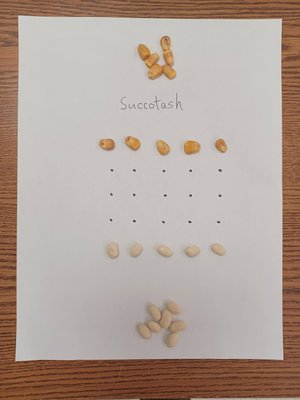
-
 @ 10846a37:73b5f923
2025-05-28 11:40:41
@ 10846a37:73b5f923
2025-05-28 11:40:41O universo dos jogos online ganha um novo patamar com a chegada da plataforma 30win, um ambiente moderno, seguro e totalmente pensado para oferecer entretenimento de qualidade aos seus usuários. Com uma interface intuitiva, ampla variedade de jogos e suporte completo, a 30win se destaca como uma excelente opção para quem busca diversão e oportunidades emocionantes de vitória.
Uma Plataforma Moderna e Confiável A 30win foi desenvolvida com tecnologia de ponta, priorizando segurança e praticidade. O site possui um design responsivo, que se adapta perfeitamente a computadores, tablets e smartphones, permitindo que o jogador aproveite seus momentos de lazer em qualquer lugar. A navegação é rápida e fluida, com menus claros e opções bem organizadas, o que torna a experiência ainda mais agradável, até mesmo para quem está começando.
Outro grande diferencial da 30winé seu compromisso com a proteção dos dados dos usuários. A plataforma utiliza protocolos avançados de criptografia, garantindo que todas as transações e informações pessoais estejam seguras. Além disso, oferece múltiplos métodos de pagamento e saque, com rapidez e eficiência.
Variedade de Jogos Para Todos os Gostos O que realmente atrai os jogadores para a 30win é a impressionante seleção de jogos disponíveis. A plataforma conta com centenas de títulos de desenvolvedores renomados, trazendo gráficos de alta qualidade, trilhas sonoras envolventes e mecânicas de jogo inovadoras.
Entre os destaques estão os jogos de slots, com temáticas variadas que vão desde aventuras épicas até símbolos clássicos. Cada título traz funções especiais como giros grátis, multiplicadores e rodadas bônus, o que aumenta tanto a diversão quanto as chances de ganhar prêmios.
Para quem gosta de desafios estratégicos, a 30win oferece também uma boa seleção de jogos de cartas como pôquer, blackjack e baccarat, além de roletas virtuais e jogos interativos com crupiês ao vivo, que proporcionam uma experiência realista e envolvente, diretamente da tela do seu dispositivo.
Experiência do Jogador em Primeiro Lugar A 30win se preocupa em entregar uma experiência completa e satisfatória aos seus jogadores. Desde o primeiro acesso, é possível notar a atenção dada aos detalhes. O cadastro é simples e rápido, com poucos cliques, e o usuário já pode começar a explorar tudo o que a plataforma tem a oferecer.
Outro ponto forte é o suporte ao cliente. A equipe de atendimento está disponível 24 horas por dia, sete dias por semana, pronta para ajudar em qualquer dúvida ou situação. Isso transmite confiança e demonstra o comprometimento da plataforma com seus usuários.
Além disso, a 30win promove constantemente bônus e promoções exclusivas, premiando tanto novos jogadores quanto os mais fiéis. Esses incentivos tornam a experiência ainda mais atrativa, com recompensas que vão desde créditos extras até prêmios especiais.
Conclusão Se você está em busca de uma plataforma de jogos online completa, segura e com excelente variedade de opções, a 30win é uma escolha certeira. Com sua interface amigável, suporte eficiente e jogos de altíssimo nível, ela oferece uma experiência empolgante que atende a todos os perfis de jogadores.
-
 @ cae03c48:2a7d6671
2025-05-28 17:00:35
@ cae03c48:2a7d6671
2025-05-28 17:00:35Bitcoin Magazine

Lyn Ulbricht Launches MACS at the 2025 Bitcoin Conference to Fight Cruel SentencingIn a powerful statement against unjust sentencing, Mothers Against Cruel Sentencing (MACS), a nonprofit founded by Lyn Ulbricht, officially launched today at the 2025 Bitcoin conference. The group is dedicated to advocating for prisoners serving excessive and inhumane sentences and supporting the families affected by such punishments.
MACS seeks to unite voices from across the political divide and tech community to drive meaningful reform in sentencing laws.
“Multiple thousands of people, many of them nonviolent like Ross, are serving extreme sentences—locked away for years, decades, even lifetimes,” said Ulbricht. “MACS aims to give families a voice to push for fair and reasonable sentencing, where the punishment fits the crime.”
Ulbricht will formally introduce the organization during the Women of Bitcoin Brunch, a major event at the conference that gathers influential women from the Bitcoin world to discuss advocacy, innovation, and impact.
Ross Ulbricht’s Journey: From Life Sentence to Presidential Pardon
Ross Ulbricht became a controversial figure after launching Silk Road in 2011, an online marketplace that used Bitcoin for anonymous transactions. While the site was unfortunately used for selling illegal drugs, it also served as Bitcoin’s first real-world use case, showcasing the power of decentralized, censorship-resistant money.
In 2015, Ulbricht was sentenced to double life imprisonment without the possibility of parole. His punishment quickly became a symbol of government overreach for many in the tech and the Bitcoin world. Critics argued that his sentence far exceeded the limits of justice, especially considering the nonviolent nature of his crimes.
His pardon, announced shortly after Trump returned to office, is seen as a strong move to honor campaign promises and support Bitcoin’s values of personal freedom and resistance to government overreach. It sparked celebration throughout the Bitcoin community but also reminded advocates that the fight for justice is far from over.
The Bitcoin community continues to call for clemency and support for others, including the developers of Samourai Wallet who are facing prosecution for creating privacy tools, and Edward Snowden, who remains in exile for revealing government surveillance programs.
Ross will be giving the keynotes speech at the 2025 Bitcoin Conference on May 29th at 8pm EST. You can watch his speech live here.
This post Lyn Ulbricht Launches MACS at the 2025 Bitcoin Conference to Fight Cruel Sentencing first appeared on Bitcoin Magazine and is written by Oscar Zarraga Perez.
-
 @ 805b8139:823180b0
2025-05-28 16:51:09
@ 805b8139:823180b0
2025-05-28 16:51:09Bitcoin Circular Economy in Africa
https://btch17n.layer3.press/articles/9ec7208a-5bd6-4b32-9e1e-24f1aa4b1ca2
-
 @ 6a6be47b:3e74e3e1
2025-05-27 16:36:21
@ 6a6be47b:3e74e3e1
2025-05-27 16:36:21🔍 Today was one of those days where I dove deeper into the world of Stacker News, exploring how wallets work and all that jazz. If you have any tips or tricks, please send them my way—I’m still figuring it all out!
After my tech adventures, I turned to drawing. Usually, I have a lineup of ideas ready to go, but none of them quite fit my mood today. Then I remembered the butterflies from my upcoming blog entry—can you guess what I’m writing and painting about? 👀
🦋Even though I’ve painted butterflies before here’s one on Instagram, I felt like revisiting them.
This one I posted on Nostr, a while ago
Lately, I’ve been seeing butterflies everywhere on my walks with my dog, and they just felt right for today’s art session. So here’s to butterflies and their beautiful symbolism!
In Celtic mythology, there’s an old Irish saying:
“Butterflies are souls of the dead waiting to pass through Purgatory.” From mindbodygreen.com
It’s no wonder butterflies are often seen as symbols of rebirth. Even Aristotle named the butterfly:
“Psyche,” the Greek word for “soul.” From learnreligions.com
☀️With the weather warming up, days growing longer, and the air full of new scents (and butterfly sightings!🦋), I invite you to really enjoy this season. After drawing today’s butterfly, I realized how freeing it is to just let go and create—no pressure, just fun. Sometimes, taking even a few mindful minutes to do something you love can work wonders—maybe even a little magic.
Hope to catch you on the next one, frens. Godspeed! ✨
Today's butterfly. I drew it on Procreate.
https://stacker.news/items/990470
-
 @ 162b4b08:9f7d278c
2025-05-28 11:37:08
@ 162b4b08:9f7d278c
2025-05-28 11:37:08Lối sống năng động, linh hoạt và hướng đến sự cân bằng đang ngày càng trở thành lựa chọn của nhiều người trẻ Việt Nam trong thời đại hiện đại. Họ không chỉ chú trọng đến công việc và học tập mà còn quan tâm đến việc chăm sóc bản thân, tận hưởng cuộc sống và tìm kiếm những khoảnh khắc thư giãn giữa lịch trình bận rộn. WIN77K, với vai trò là một nền tảng giải trí trực tuyến thông minh, đã nhanh chóng nắm bắt được nhu cầu này và cung cấp một loạt nội dung giải trí phù hợp với nhịp sống trẻ trung, sôi động. Các tính năng truy cập nhanh, giao diện dễ sử dụng và hệ thống hoạt động ổn định trên cả điện thoại lẫn máy tính giúp người dùng linh hoạt tận hưởng các hoạt động giải trí mọi lúc, mọi nơi. Thay vì tiêu tốn thời gian vào những hoạt động kém hiệu quả, người trẻ có thể lựa chọn những trải nghiệm nhẹ nhàng, thư giãn nhưng vẫn duy trì được năng lượng tích cực cho cả ngày dài. Đây chính là điểm mạnh giúp WIN77K trở thành người bạn đồng hành đáng tin cậy cho thế hệ năng động ngày nay.
Không chỉ hỗ trợ giải trí, win77k còn cung cấp nhiều chuyên mục bài viết hữu ích liên quan đến lối sống, sức khỏe tinh thần, và các gợi ý giúp người trẻ duy trì phong cách sống lành mạnh. Những nội dung như cách tổ chức thời gian, làm thế nào để giữ năng lượng tích cực mỗi ngày, hoặc các bài viết chia sẻ kinh nghiệm xây dựng thói quen tốt… đều được biên tập kỹ lưỡng và cập nhật thường xuyên. Điều này giúp người dùng không chỉ tiêu thụ nội dung mà còn được truyền cảm hứng để thay đổi thói quen sống một cách chủ động. Hơn nữa, WIN77K còn kết nối cộng đồng người trẻ có cùng lối sống qua các hoạt động chia sẻ và thảo luận trực tuyến. Nhờ vậy, người dùng có thể tìm thấy sự đồng cảm, học hỏi lẫn nhau và mở rộng mạng lưới quan hệ tích cực trong môi trường số. Việc xây dựng cộng đồng này không chỉ thúc đẩy sự phát triển cá nhân mà còn lan tỏa tinh thần sống tích cực, tự chủ và sáng tạo đến nhiều người hơn trong xã hội.
Thành công của WIN77K đến từ sự thấu hiểu sâu sắc đối với nhu cầu của người dùng hiện đại, đặc biệt là thế hệ trẻ. Trong một thế giới mà mọi thứ đều chuyển động không ngừng, việc tìm ra điểm dừng hợp lý để nạp lại năng lượng là điều cần thiết. Và WIN77K đã làm tốt vai trò đó khi không chỉ tạo ra một nền tảng giải trí đơn thuần mà còn là không gian giúp người trẻ phát triển bản thân một cách toàn diện. Dù là trong lúc nghỉ ngơi giữa giờ học, thư giãn sau một ngày làm việc mệt mỏi hay đơn giản là tìm kiếm một khoảng lặng trong cuộc sống bận rộn, WIN77K luôn hiện diện như một lựa chọn tiện lợi, an toàn và truyền cảm hứng. Sự linh hoạt, hiện đại cùng định hướng phát triển bền vững chính là lý do khiến WIN77K không ngừng gia tăng sự tin tưởng và yêu mến từ cộng đồng người trẻ Việt Nam, ngày càng khẳng định vai trò của mình trong việc đồng hành cùng lối sống năng động và tích cực của thế hệ tương lai.
-
 @ cff1720e:15c7e2b2
2025-05-28 11:18:23
@ cff1720e:15c7e2b2
2025-05-28 11:18:23Liebe Anwender,\ \ diesmal beginnen die Neuigkeiten schon beim Titel und der Anrede. Unsere Worte bestimmen unser Denken, und daher war die Korrektur wichtiger als sie zunächst erscheint, denn bei Pareto gibt es die klassische Trennung zwischen Autor und Leser nicht mehr. Cocreation heißt unser Konzept, jeder kann publizieren, kommentieren, honorieren und distribuieren. Mag das bei Blogtexten derzeit noch nicht selbstverständlich sein, so ist das bei Bildern längst die Norm.

“Ein Bild sagt mehr als tausend Worte” beschreibt die Wirkung visueller Kommunikation. Deshalb haben wir nach dem Blogtext nun mit Bildern eine neue Content-Kategorie eingeführt. Natürlich auch hier mit den bekannten Funktionen der Interaktion wie like, repost und zap. Es gibt derzeit eine Gliederung in 4 Feeds, Gefolgt (für Nostr-User verfügbar), Memes und Kunst (gefiltert nach entsprechenden Tags) und Pareto für alles andere.

Jeder Nostr-User hat die Möglichkeit eigene Bilder hochzuladen, zu taggen, sowie mit einem Titel und Untertext zu versehen. “Everyone is a creator” war noch nie leichter, probiert es einfach aus! Noch kein Nostr-Profil und trotzdem interessiert? Kein Problem, bitte Informationen zu originellen Bildquellen oder Interesse an Mitwirkung per Mail senden an pictures@pareto.space

Leicht ist es auch die Pareto-Inhalte zu erhalten und konsumieren, man braucht weder einen Account noch spezielle Apps. Jeder hat bereits die entsprechenden Voraussetzungen, hier ein paar Beispiele.\ \ Newsletter per Mail (Die Friedenstaube)\ hier abonnieren\ \ In Telegram lesen -> hier unsere Kanäle\ https://t.me/pareto_artikel \ https://t.me/friedenstaube_artikel \ \ Als Feed in einem Feed-Reader \ https://pareto.space/atom/feed.xml \ https://pareto.space/atom/de_feed.xml \ https://pareto.space/atom/en_feed.xml

Fügt in Eure Artikel bitte am Anfang / Ende einen Hinweis auf den Pareto-Client ein, andere Clients unterstützen nicht alle Features. Das ist ein Service-Hinweis zur besseren Lesbarkeit “Dieser Beitrag wurde mit dem Pareto-Client geschrieben.” Ebenso ist ein Hinweis auf Onboarding bei Nostr nützlich: neue Nostr-User können euch liken und zappen: not yet on Nostr and want the full experience? Easy onboarding via Start.\ \ Das Pareto-Team baut den “Marktplatz der Ideen” und hat dabei schon viel erreicht. Feedback und Mitarbeit hilft uns damit noch schneller voranzukommen, wir bedanken uns für Eure Unterstützung.\ team@pareto.space \ https://pareto.space \ https://geyser.fund/project/pareto?hero=1c1b8e487090
-
 @ c1e9ab3a:9cb56b43
2025-05-27 16:19:06
@ c1e9ab3a:9cb56b43
2025-05-27 16:19:06Star Wars is often viewed as a myth of rebellion, freedom, and resistance to tyranny. The iconography—scrappy rebels, totalitarian stormtroopers, lone smugglers—suggests a deep anti-authoritarian ethos. Yet, beneath the surface, the narrative arc of Star Wars consistently affirms the necessity, even sanctity, of central authority. This blog entry introduces the question: Is Star Wars fundamentally a celebration of statism?
Rebellion as Restoration, Not Revolution
The Rebel Alliance’s mission is not to dismantle centralized power, but to restore the Galactic Republic—a bureaucratic, centrally governed institution. Characters like Mon Mothma and Bail Organa are high-ranking senators, not populist revolutionaries. The goal is to remove the corrupt Empire and reinstall a previous central authority, presumed to be just.
- Rebels are loyalists to a prior state structure.
- Power is not questioned, only who wields it.
Jedi as Centralized Moral Elites
The Jedi, often idealized as protectors of peace, are unelected, extra-legal enforcers of moral and military order. Their authority stems from esoteric metaphysical abilities rather than democratic legitimacy.
- They answer only to their internal Council.
- They are deployed by the Senate, but act independently of civil law.
- Their collapse is depicted as tragic not because they were unaccountable, but because they were betrayed.
This positions them as a theocratic elite, not spiritual anarchists.
Chaos and the Frontier: The Case of the Cantina
The Mos Eisley cantina, often viewed as a symbol of frontier freedom, reveals something darker. It is: - Lawless - Violent - Culturally fragmented
Conflict resolution occurs through murder, not mediation. Obi-Wan slices off a limb; Han shoots first—both without legal consequence. There is no evidence of property rights, dispute resolution, or voluntary order.
This is not libertarian pluralism—it’s moral entropy. The message: without centralized governance, barbarism reigns.
The Mythic Arc: Restoration of the Just State
Every trilogy in the saga returns to a single theme: the fall and redemption of legitimate authority.
- Prequels: Republic collapses into tyranny.
- Originals: Rebels fight to restore legitimate order.
- Sequels: Weak governance leads to resurgence of authoritarianism; heroes must reestablish moral centralism.
The story is not anti-state—it’s anti-bad state. The solution is never decentralization; it’s the return of the right ruler or order.
Conclusion: The Hidden Statism of a Rebel Myth
Star Wars wears the costume of rebellion, but tells the story of centralized salvation. It: - Validates elite moral authority (Jedi) - Romanticizes restoration of fallen governments (Republic) - Portrays decentralized zones as corrupt and savage (outer rim worlds)
It is not an anarchist parable, nor a libertarian fable. It is a statist mythology, clothed in the spectacle of rebellion. Its core message is not that power should be abolished, but that power belongs to the virtuous few.
Question to Consider:
If the Star Wars universe consistently affirms the need for centralized moral and political authority, should we continue to see it as a myth of freedom? Or is it time to recognize it as a narrative of benevolent empire? -
 @ e844b39d:adafb6a2
2025-05-27 14:31:02
@ e844b39d:adafb6a2
2025-05-27 14:31:02This was not planned, but last evening I realized that I should at least test the Sony A900 and Minolta gear that I had, which was bought for real estate photography around a decade ago.
 Look at everything out here!
Look at everything out here!Our two white kittens are almost identical, but they come from two different mothers, Charcoal and Tiger!
I sometimes wonder if they have realized that they look the same, they tend to stick together most of the day.
 I know you're there!
I know you're there!This ended up being perfect scenes for the 20/2.8 wide open!
 Outside the gate
Outside the gateSeveral of our cats have been digging a hole outside, sniffing for something, we have no idea what that is all about...

 Playing around
Playing aroundThey often stay in the slot for the gate, I guess its a little less hot there.
 Happy cat?
Happy cat?This sort of scene is perfect for the Beercan, Minolta 70-210/4, its a legendary piece of optics for sure. One of the reasons I got into the system back then.
 Scouting
ScoutingThey spent some time hunting each others in the "jungle" of course!

 Hunting mode!
Hunting mode!They were moving too rapidly for any gear really, so the slow AF was not a real hindrance.
 I look good, yes?
I look good, yes?Sometimes when I process images of them the fur gets messy and kinda dirty looking, but this went the opposite way!
It was a good day in the garden, and a very useful test.
That's it for today!
-
 @ 43baaf0c:d193e34c
2025-05-27 14:08:02
@ 43baaf0c:d193e34c
2025-05-27 14:08:02During the incredible Bitcoin Filmfest, I attended a community session where a discussion emerged about zapping and why I believe zaps are important. The person leading the Nostr session who is also developing an app that’s partially connected to Nostr mentioned they wouldn’t be implementing the zap mechanism directly. This sparked a brief but meaningful debate, which is why I’d like to share my perspective as an artist and content creator on why zaps truly matter.
Let me start by saying that I see everything from the perspective of an artist and creator, not so much from a developer’s point of view. In 2023, I started using Nostr after spending a few years exploring the world of ‘shitcoins’ and NFTs, beginning in 2018. Even though I became a Bitcoin maximalist around 2023, those earlier years taught me an important lesson: it is possible to earn money with my art.
Whether you love or hate them, NFTs opened my eyes to the idea that I could finally take my art to the next level. Before that, for over 15 years, I ran a travel stock video content company called @traveltelly. You can read the full story about my journey in travel and content here: https://yakihonne.com/article/traveltelly@primal.net/vZc1c8aXrc-3hniN6IMdK
When I truly understood what Bitcoin meant to me, I left all other coins behind. Some would call that becoming a Bitcoin maximalist.
The first time I used Nostr, I discovered the magic of zapping. It amazed me that someone who appreciates your art or content could reward you—not just with a like, but with real value: Bitcoin, the hardest money on earth. Zaps are small amounts of Bitcoin sent as a sign of support or appreciation. (Each Bitcoin is divisible into 100 million units called Satoshis, or Sats for short—making a Satoshi the smallest unit of Bitcoin recorded on the blockchain.)
 The Energy of Zaps
The Energy of ZapsIf you’re building an app on Nostr—or even just connecting to it—but choose not to include zaps, why should artists and content creators share their work there? Why would they leave platforms like Instagram or Facebook, which already benefit from massive network effects?
Yes, the ability to own your own data is one of Nostr’s greatest strengths. That alone is a powerful reason to embrace the protocol. No one can ban you. You control your content. And the ability to post once and have it appear across multiple Nostr clients is an amazing feature.
But for creators, energy matters. Engagement isn’t just about numbers—it’s about value. Zaps create a feedback loop powered by real appreciation and real value, in the form of Bitcoin. They’re a signal that your content matters. And that energy is what makes creating on Nostr so special.
But beyond those key elements, I also look at this from a commercial perspective. The truth is, we still can’t pay for groceries with kisses :)—we still need money as a medium of exchange. Being financially rewarded for sharing your content gives creators a real incentive to keep creating and sharing. That’s where zaps come in—they add economic value to engagement.
A Protocol for Emerging Artists and Creators
I believe Nostr offers a great starting point for emerging artists and content creators. If you’re just beginning and don’t already have a large following on traditional social media platforms, Nostr provides a space where your work can be appreciated and directly supported with Bitcoin, even by a small but engaged community.
On the other hand, creators who already have a big audience and steady income on platforms like Instagram or YouTube may not feel the urgency to switch. This is similar to how wealthier countries are often slower to understand or adopt Bitcoin—because they don’t need it yet. In contrast, people in unbanked regions or countries facing high inflation are more motivated to learn how money really works.
In the same way, emerging creators—those still finding their audience and looking for sustainable ways to grow—are often more open to exploring new ecosystems like Nostr, where innovation and financial empowerment go hand in hand.
The same goes for Nostr. After using it for the past two years, I can honestly say: without Nostr, I wouldn’t be the artist I am today.
Nostr motivates me to create and share every single day. A like is nice but receiving a zap, even just 21 sats, is something entirely different. Once you truly understand that someone is willing to pay you for what you share, it’s no longer about the amount. It’s about the magic behind it. That simple gesture creates a powerful, positive energy that keeps you going.
Even with Nostr’s still relatively small user base, I’ve already been able to create projects that simply wouldn’t have been possible elsewhere.
Zaps do more than just reward—they inspire. They encourage you to keep building your community. That inspiration often leads to new projects. Sometimes, the people who zap you become directly involved in your work, or even ask you to create something specifically for them.
That’s the real value of zaps: not just micro-payments, but micro-connections sparks that lead to creativity, collaboration, and growth.
Proof of Work (PoW)
Over the past two years, I’ve experienced firsthand how small zaps can evolve into full art projects and even lead to real sales. Here are two examples that started with zaps and turned into something much bigger:
Halving 2024 Artwork
When I started the Halving 2024 project, I invited people on Nostr to be part of it. 70 people zapped me 2,100 sats each, and in return, I included their Npubs in the final artwork. That piece was later auctioned and sold to Jurjen de Vries for 225,128 Sats.
Magic Internet Money
For the Magic Internet Money artwork, I again invited people to zap 2,100 sats to be included. Fifty people participated, and their contributions became part of the final art frame. The completed piece was eventually sold to Filip for 480,000 sats.
These examples show the power of zaps: a simple, small act of appreciation can turn into larger engagement, deeper connection, and even the sale of original art. Zaps aren’t just tips—they’re a form of collaboration and support that fuel creative energy.
I hope this article gives developers a glimpse into the perspective of an artist using Nostr. Of course, this is just one artist’s view, and it doesn’t claim to speak for everyone. But I felt it was important to share my Proof of Work and perspective.
For me, Zaps matter.
Thank you to all the developers who are building these amazing apps on Nostr. Your work empowers artists like me to share, grow, and be supported through the value-for-value model.
-
 @ 33baa074:3bb3a297
2025-05-28 08:54:40
@ 33baa074:3bb3a297
2025-05-28 08:54:40COD (chemical oxygen demand) sensors play a vital role in water quality testing. Their main functions include real-time monitoring, pollution event warning, water quality assessment and pollution source tracking. The following are the specific roles and applications of COD sensors in water quality testing:
Real-time monitoring and data acquisition COD sensors can monitor the COD content in water bodies in real time and continuously. Compared with traditional sampling methods, COD sensors are fast and accurate, without manual sampling and laboratory testing, which greatly saves time and labor costs. By combining with the data acquisition system, the monitoring data can be uploaded to the cloud in real time to form a extemporization distribution map of the COD content in the water body, providing detailed data support for environmental monitoring and management.
Pollution event warning and rapid response COD sensors play an important role in early warning and rapid response in water environment monitoring. Once there is an abnormal increase in organic matter in the water body, the COD sensor can quickly detect the change in COD content and alarm through the preset threshold. This enables relevant departments to take measures at the early stage of the pollution incident to prevent the spread of pollution and protect the water environment.
Water quality assessment and pollution source tracking COD sensors play an important role in water quality assessment and pollution source tracking. By continuously monitoring the COD content in water bodies, the water quality can be evaluated and compared with national and regional water quality standards. At the same time, COD sensors can also help determine and track the location and spread of pollution sources, provide accurate data support for environmental management departments, and guide the development of pollution prevention and control work.
Application scenarios COD sensors are widely used in various water quality monitoring scenarios, including but not limited to: Sewage treatment plants: used to monitor the COD content of in fluent and effluent to ensure the effect of sewage treatment. Water source protection and management: deployed in water sources to monitor the COD content of in fluent sources. Once the water quality exceeds the set limit, the system will issue an alarm in time to ensure water quality safety. Lake and river monitoring: deployed in water bodies such as lakes and rivers to monitor the COD content of water bodies in real time.

Technical features of COD sensor COD sensor uses advanced technology, such as ultraviolet absorption method, which does not require the use of chemical reagents, avoiding the risk of contamination of chemical reagents in traditional COD detection methods, and can achieve online uninterrupted water quality monitoring, providing strong support for real-time water quality assessment. In addition, COD sensor also has the advantages of low cost, high stability, strong anti-interference ability, and convenient installation.
Summary In summary, COD sensor plays an irreplaceable role in water quality detection. It can not only provide real-time and accurate water quality data, but also quickly warn when pollution incidents occur, providing strong technical support for water quality management and environmental protection. With the advancement of technology and the popularization of applications, COD sensor will play a more important role in water quality monitoring in the future.
-
 @ 5d4b6c8d:8a1c1ee3
2025-05-27 13:34:45
@ 5d4b6c8d:8a1c1ee3
2025-05-27 13:34:45Is the housing market going to crash for real this time?
https://primal.net/e/nevent1qvzqqqqqqypzp6dtxy5uz5yu5vzxdtcv7du9qm9574u5kqcqha58efshkkwz6zmdqqs8dqr35dc0npsc8cuulqm4m7gxrgqq3ytphtja9nx534a592gztzsuzsrja
https://stacker.news/items/990316
-
 @ 0c65eba8:4a08ef9a
2025-05-28 15:28:47
@ 0c65eba8:4a08ef9a
2025-05-28 15:28:47You’ve heard the word.
You’ve probably used it. Maybe even hurled it at someone in a moment of pain. "Narcissist."
It lands like a curse.
And in today’s culture, it is one.
Not because it’s accurate.
But because it’s easy and packs a gut punch.
We blame narcissism for everything now. Every breakup. Every betrayal. Every moment someone’s ego gets in the way of our feelings.
Girls love to call their boyfriends narcissists when they feel neglected or controlled. Men love to call shallow women narcissists when they note the slightest vanity.
Friends turn on each other. Parents diagnose their children. Exes declare psychological war.
It’s become the pop-psych version of original sin.
But here’s the problem: the way we use this word is no longer grounded in clarity, science, or truth. It’s grounded in resentment.
And resentment is not a tool for diagnosis. It’s a weapon.
The Real Problem: Personality Dysfunction Is Rising
We are living in an era of personality dysfunction.
People hurt each other. They sabotage relationships, abandon their children, manipulate their spouses, destroy trust, and call it “self-care.”
Something is wrong. Deeply wrong.
We’ve studied it. Therapists, researchers, and social commentators have all tried to map it out.
And to be fair, some of those efforts have succeeded.
Certain patterns of personality dysfunction can be measured, tracked, and treated. When a trait can be operationalized, when we can define it clearly, measure it consistently, and test interventions reliably, it becomes useful. It becomes a tool for healing, not a weapon of blame.
For a psychological label to be scientifically sound, it must meet these criteria:
Antisocial Personality Disorder, for example, has clear markers: chronic dishonesty, demonstrated disregard for others, lack of remorse, impulsive behavior. It can be identified across time and context, and most importantly, it responds to specific interventions.
But narcissism?
The term doesn’t hold up.
It fails the tests of clarity, reliability, and usefulness. One therapist might see narcissism in a man who talks proudly about his accomplishments; another sees the same behavior as sharing leadership wisdom. One woman calls her ex a narcissist because he set boundaries; another praises those same traits in her new husband. A father who struggles to express affection gets pathologized as narcissistic by one adult child, and quietly respected for his restraint by another.
The label lacks tether. It’s not anchored to cause, behavior, or result.
It floats. It morphs. It reflects less about the person being described, and more about the insecurity or pain of the one using it.
And in trying to describe everything, it ends up describing nothing.
That’s not psychology. It’s projection.
We turned “narcissist” into a slur, a cudgel we swing at anyone who disagrees with us, makes us uncomfortable, or dares to outshine us. It’s no longer more useful than simply saying "man bad."
What Does "Narcissist" Even Mean?
So what does “narcissist” mean today?
Whatever the accuser wants it to mean.
Sometimes it means someone is confident. Other times, ambitious. Or assertive. Or charismatic. Or proud. Or selfish. Or charming. Or controlling. Or emotionally abusive. And sometimes, it simply means the other person didn’t agree with the accuser.
The list doesn’t end, because there is no clear definition.
When you call someone a narcissist, are you naming a trait? Or expressing your own pain? Or just reacting to how their ego made you feel?
Are you labeling a pattern of manipulation? Or just someone who knows they’re good at what they do? Or someone who’s willing to set a boundary that you don’t like?
We don’t know. And that’s the problem.
Side note: in my experience, true manipulators are the first to accuse others of manipulation. It’s a preemptive strike, a decoy. They believe if they say it first, it shields them from being exposed.
The same thing happens with the word narcissist.
Narcissism Doesn’t Survive Scientific Scrutiny
Before we go further, let’s look at what the DSM-5 actually says about Narcissistic Personality Disorder. These are the official diagnostic traits, and how each one collapses under scrutiny when we try to apply it with clarity, truth, and reciprocity.
What we find is simple: for every trait listed, we already have a better, more operational term. One that doesn’t blur the line between pathology and personality. One that can be observed, measured, and acted on.
But don’t just take my word for it, let’s examine the clinical roots and see how shallow they really are.
Here’s what that disambiguation looks like:
Every trait here has a clearer name or description. Every clearer name leads to a clearer solution. Calling it narcissism blurs the edges. Disambiguation sharpens them.
And one special note about empathy, since this trait is one of the most weaponized, it deserves a direct clarification. Most people don’t understand what empathy really is, let alone how it works in the real world:
When most people say "you lack empathy," what they really mean is "you didn’t agree with me or do what I wanted." But empathy is not blind compliance. It’s a limited, precious resource. It takes energy. It takes time. And it must be rationed.
We cannot, and should not, extend unlimited empathy to those outside our Circle of Care. Empathy isn’t just a warm feeling. It’s a costly act. It asks you to notice someone else’s pain, feel it, and then respond, often at the expense of your own time, energy, or resources.
So we ration it. We prioritize it. We give it to those we are responsible for, to those we love, to those who have earned our care. That’s not cruelty. That’s stewardship.
The real danger is when manipulators demand empathy as proof of virtue. “If you cared, you’d give me what I want.” But empathy is not submission. It is not forced agreement. It is not the abandonment of your own boundaries. Saying no with a clear heart is not a failure of empathy, it’s the mark of someone who knows where their responsibility ends, and where someone else’s manipulation begins. That’s wisdom. Because your emotional bandwidth, like every other resource, must be spent where it creates the most good.
Because of its vague boundaries, once someone learns the word “narcissist,” they start seeing it everywhere.
Every ex becomes one. Every bad boss. Every failed friendship. Every powerful man or beautiful woman who made them feel small. And soon, it doesn’t stop at relationships. It creeps into how they explain everything, from the decline of civilization to the state of politics and culture. Narcissism becomes the catch-all villain behind every social ill. Because the word is so vague, it always fits. But at that scale, the diagnosis becomes dangerous. It blocks our ability to understand people’s real motivations, incentives, fears, and goals. It replaces thought with accusation, and understanding with outrage.
They see narcissists everywhere, but they don’t ask if they’re the ones attracting toxic people, or if they’ve simply trained their lens to label every disappointment as abuse and every disagreement as pathology.
It’s projection disguised as insight.
And when you weaponize a label like that, you’re not analyzing behavior. You’re avoiding self-examination.
Three Core Arguments That Undermine the Narcissism Narrative
Now that we’ve seen how narcissism fails the scientific and diagnostic test, let’s break down the broader cultural problem. These are the three key reasons the term “narcissist” no longer serves us, and often does more harm than good.
1. "Narcissist" Doesn’t Mean Anything Specific, It Just Means You Don’t Like Them
The term is used as a junk drawer for traits people don’t want to deal with:
-
Confidence
-
Pride
-
Assertiveness
-
Visibility
But these traits, when tempered by maturity and ethics, are not only acceptable, they’re necessary.
-
Confidence inspires.
-
Pride in your work drives excellence.
-
Assertiveness enables leadership.
-
Visibility allows others to follow.
So when do these traits become toxic?
They don’t.
Not by themselves.
They only become dangerous when fused with things like entitlement, cruelty, dishonesty, or impulsiveness. And if those are the real problems, we should name them precisely.
Anything else is diagnostic laziness.
2. It’s Become a Weapon, Not a Diagnosis
Once upon a time, “narcissist” was treated as if it referred to a diagnosable condition. There was at least an attempt to define it scientifically and limit its use. But today, it's no longer grounded in discipline or diagnosis. It’s a social cudgel, vague, emotional, and endlessly adaptable to whatever someone wants to condemn.
People use it to:
-
Discredit others
-
Silence dissent
-
Justify moral superiority
And worst of all: you can’t defend yourself against it. The accusation is the evidence.
Try denying it. Say, "No, I don’t think highly of myself," and you disqualify yourself from being taken seriously. You’re signaling weakness, not humility. Especially for men, especially for leaders, denying your own value is social suicide.
Try asserting the truth instead. Say, "I’m not a narcissist, I’m just good at what I do." And that will be taken as proof of the accusation.
This trap doesn’t correct behavior. It crushes identity. It teaches the confident to shrink, the capable to self-doubt, and the virtuous to pretend they’re ordinary. Over time, especially in young men, this leads to collapse, of initiative, of drive, of self-respect.
We shouldn’t be pathologizing strong egos. We should be cultivating them, anchored in virtue, tethered to reality, and grounded in service. Confidence that comes from earned excellence isn’t narcissism. It’s maturity.
It’s time to stop punishing people for knowing who they are.
This isn’t psychology. It’s witch-burning.
3. We Already Have Better Words
If someone is manipulative, call them that. If someone lacks empathy, say so. If they’re arrogant, dishonest, or abusive, we already have words for those things.
Using “narcissist” to describe all of them at once is like checking your heart rate to diagnose a broken leg.
Vague terms destroy discernment.
Precise terms help us solve problems.
What About the People We’re Tearing Down?
Now here’s the part they don’t tell you:
Some of the people who get labeled “narcissist” aren’t dysfunctional at all.
They’re just better.
Better than average. Smarter. Stronger. More creative. More aware of their power. And because of that, they’re seen as dangerous.
So we drag them back down.
Like crabs in a bucket.
We’d rather insult than ascend.
We’d rather pathologize excellence than rise to meet it.
This is cultural suicide.
A Better Way to Protect Yourself
Here’s the better path forward:
-
Stop using “narcissist” as a placeholder for pain, disagreement, or vague discomfort.
-
Name the real traits, good or bad.
-
Learn how manipulation works and how to defend against it.
If you’ve ever been manipulated, gaslit, or emotionally preyed on, there’s a better way to understand it than these pop-psych terms.
That’s why I wrote this:
Become Immune to Manipulation: They Are Manipulating You and How to Resist It
It’s a guide to help you:
-
Detect manipulation in real time
-
Understand the tools manipulators use
-
Build defenses rooted in clarity, strength, and Natural Law
It’s short. It’s blunt. And it will change how you see people.
Read it. Share it. Live by it.
Because if you want to protect yourself from emotional predators, you don’t need therapy-speak.
You need a sword.
Retire the Label. Restore the Truth.
The truth is simple:
We don’t fix culture by inventing new labels. We fix it by restoring clarity, praising the good, correcting the harmful, and refusing to weaponize our language against truth.
So let’s stop using the narcissist slur.
And start seeing people for who they really are.
-
-
 @ eb0157af:77ab6c55
2025-05-28 14:01:59
@ eb0157af:77ab6c55
2025-05-28 14:01:59Banking giants JPMorgan, Bank of America, Citigroup, and Wells Fargo are in talks to develop a unified stablecoin solution.
According to the Wall Street Journal on May 22, some of the largest financial institutions in the United States are exploring the possibility of joining forces to launch a stablecoin.
Subsidiaries of JPMorgan, Bank of America, Citigroup, and Wells Fargo have initiated preliminary discussions for a joint stablecoin issuance, according to sources close to the matter cited by the WSJ. Also at the negotiating table are Early Warning Services, the parent company of the digital payments network Zelle, and the payment network Clearing House.
The talks are reportedly still in the early stages, and any final decision could change depending on regulatory developments and market demand for stablecoins.
Stablecoin regulation
On May 20, the US Senate voted 66 to 32 to advance discussion of the Guiding and Establishing National Innovation for US Stablecoins Act (GENIUS Act), a specific law to regulate stablecoins. The bill outlines a regulatory framework for stablecoin collateralization and mandates compliance with anti-money laundering rules.
David Sacks, White House crypto advisor, expressed optimism about the bill’s bipartisan approval. However, senior Democratic Party officials intend to amend the bill to include a clause preventing former President Donald Trump and other US officials from profiting from stablecoins.
Demand for stablecoins has increased, with total market capitalization rising to $245 billion from $205 billion at the beginning of the year, a 20% increase.
The post Major US banks consider launching a joint stablecoin appeared first on Atlas21.
-
 @ 33baa074:3bb3a297
2025-05-28 08:25:13
@ 33baa074:3bb3a297
2025-05-28 08:25:13The oil-in-water sensoris an instrument specially used to detect oil substances in water bodies. Its working principle is mainly based on the characteristic that oil substances will produce fluorescence under ultraviolet light. The following is a detailed explanation:
Principle Overview The oil-in-water sensor uses the characteristic that oil substances will produce fluorescence under ultraviolet light, and measures the fluorescence intensity to infer the concentration of oil substances. Specifically, the sensor uses ultraviolet light as the excitation light source to irradiate the water sample to be tested. After the oil substance absorbs ultraviolet light, it will stimulate fluorescence, and the fluorescence signal is received by the photo detector and converted into an electrical signal. By measuring the strength of the electrical signal, the concentration of oil substances in the water sample can be inferred.
Workflow Ultraviolet light irradiation: The ultraviolet light source inside the sensor emits ultraviolet light and irradiates it into the water sample to be tested.
Fluorescence generation: After the oil substance in the water sample absorbs ultraviolet light, it will stimulate fluorescence.
Fluorescence detection: The photo detector in the sensor measures the intensity of this fluorescence.
Signal conversion: The signal processing circuit converts the output of the photo detector into an electrical signal proportional to the amount of oil in the water. Data analysis: By analyzing the strength of the electrical signal, the concentration of oil substances in the water sample can be obtained.
Features and applications The oil in water sensor has high sensitivity and can detect soluble and falsifiable oils. It is suitable for a variety of water quality monitoring scenarios, such as oil field monitoring, industrial circulating water, condensate water, wastewater treatment, surface water stations, etc. In addition, it can also monitor the content of crude oil (benzene and benzene homologous) in water sources such as reservoirs and water plants in real time online, play an early warning role, and protect the safety of water sources.
Practical application The oil in water sensor has a wide range of functions in practical applications, including but not limited to the following aspects: Monitoring the water quality of water sources: ensuring the safety of drinking water, and timely discovering pollution sources and ensuring water supply safety by continuously monitoring oil substances in water sources. Monitoring sewage treatment plant emissions: ensuring that the discharge water quality of sewage treatment plants meets the emission standards to avoid secondary pollution to the environment. Monitoring rivers, lakes and other water bodies: assessing the pollution status and providing a basis for pollution control. Early warning and emergency response: It has real-time monitoring and early warning functions, and can issue an alarm in time when abnormal conditions are found, providing valuable time for emergency response and reducing losses caused by pollution. Scientific research: Through the monitoring data of this sensor, we can deeply understand the distribution, migration and transformation of oil substances in water bodies, and provide a scientific basis for environmental protection and governance.
In summary, the oil in water sensor monitors the oil content in water bodies through ultraviolet fluorescence method, has high sensitivity and broad application prospects, and is an indispensable and important tool in modern environmental monitoring and industrial production.
-
 @ 5f078e90:b2bacaa3
2025-05-28 12:00:23
@ 5f078e90:b2bacaa3
2025-05-28 12:00:23Sylvi the seahorse

In the coral haven of Azure Bay, a seahorse named Sylvi danced with the tides. Her tail curled around a swaying frond as she watched fish dart by. One dawn, a lost pearl rolled into her nook. Sylvi, curious, nudged it along the reef, meeting crabs and eels who shared tales of the deep. By dusk, she found its oyster home. The pearl gleamed thanks, and Sylvi twirled home, her heart light as foam.
Ignore this test. This was in bold originally.
(380 chars, plain text after Markdown stripping, this was in italics originally)
Originally written on habla.news (on Nostr)
-
 @ c1e9ab3a:9cb56b43
2025-05-27 13:19:53
@ c1e9ab3a:9cb56b43
2025-05-27 13:19:53I. Introduction: Money as a Function of Efficiency and Preference
Money is not defined by law, but by power over productivity. In any open economy, the most economically efficient actors—those who control the most valuable goods, services, and knowledge—ultimately dictate the medium of exchange. Their preferences signal to the broader market what form of money is required to access the highest-value goods, from durable commodities to intangibles like intellectual property and skilled labor.
Whatever money these actors prefer becomes the de facto unit of account and store of value, regardless of its legal status. This emergent behavior is natural and reflects a hierarchy of monetary utility.
II. Classical Gresham’s Law: A Product of Market Distortion
Gresham’s Law, famously stated as:
"Bad money drives out good"
is only valid under coercive monetary conditions, specifically: - Legal tender laws that force the acceptance of inferior money at par with superior money. - Fixed exchange rates imposed by decree, not market valuation. - Governments or central banks backing elastic fiduciary media with promises of redemption. - Institutional structures that mandate debt and tax payments in the favored currency.
Under these conditions, superior money (hard money) is hoarded, while inferior money (soft, elastic, inflationary) circulates. This is not an expression of free market behavior—it is the result of suppressed price discovery and legal coercion.
Gresham’s Law, therefore, is not a natural law of money, but a law of distortion under forced parity and artificial elasticity.
III. The Collapse of Coercion: Inversion of Gresham’s Law
When coercive structures weaken or are bypassed—through technological exit, jurisdictional arbitrage, monetary breakdown, or political disintegration—Gresham’s Law inverts:
Good money drives out bad.
This occurs because: - Market actors regain the freedom to select money based on utility, scarcity, and credibility. - Legal parity collapses, exposing the true economic hierarchy of monetary forms. - Trustless systems (e.g., Bitcoin) or superior digital instruments (e.g., stablecoins) offer better settlement, security, and durability. - Elastic fiduciary media become undesirable as counterparty risk and inflation rise.
The inversion marks a return to monetary natural selection—not a breakdown of Gresham’s Law, but the collapse of its preconditions.
IV. Elasticity and Control
Elastic fiduciary media (like fiat currency) are not intrinsically evil. They are tools of state finance and debt management, enabling rapid expansion of credit and liquidity. However, when their issuance is unconstrained, and legal tender laws force their use, they become weapons of economic coercion.
Banks issue credit unconstrained by real savings, and governments enforce the use of inflated media through taxation and courts. This distorts capital allocation, devalues productive labor, and ultimately hollows out monetary confidence.
V. Monetary Reversion: The Return of Hard Money
When the coercion ends—whether gradually or suddenly—the monetary system reverts. The preferences of the productive and wealthy reassert themselves:
- Superior money is not just saved—it begins to circulate.
- Weaker currencies are rejected not just for savings, but for daily exchange.
- The hoarded form becomes the traded form, and Gresham’s Law inverts completely.
Bitcoin, gold, and even highly credible stable instruments begin to function as true money, not just stores of value. The natural monetary order returns, and the State becomes a late participant, not the originator of monetary reality.
VI. Conclusion
Gresham’s Law operates only under distortion. Its inversion is not an anomaly—it is a signal of the collapse of coercion. The monetary system then reorganizes around productive preference, technological efficiency, and economic sovereignty.
The most efficient market will always dictate the form of hard money. The State can delay this reckoning through legal force, but it cannot prevent it indefinitely. Once free choice returns, bad money dies, and good money lives again.
-
 @ 9cb3545c:2ff47bca
2025-05-27 12:58:56
@ 9cb3545c:2ff47bca
2025-05-27 12:58:56Introduction
Public companies that hold Bitcoin on behalf of investors (often issuing securities backed by those Bitcoin holdings) have faced growing pressure to demonstrate proof of reserves – evidence that they genuinely hold the cryptocurrency they claim. One approach is to publish the company’s Bitcoin wallet addresses so that anyone can verify the balances on the blockchain. This practice gained momentum after high-profile crypto collapses (e.g. FTX in 2022) eroded trust, leading major exchanges and fund issuers like Binance, Kraken, OKX, and Bitwise to publicize wallet addresses as proof of assets . The goal is transparency and reassurance for investors. However, making wallet addresses public comes with significant security and privacy risks. This report examines those risks – from cybersecurity threats and blockchain tracing to regulatory and reputational implications – and weighs them against the transparency benefits of on-chain proof of reserves.
Proof of Reserves via Public Wallet Addresses
In the cryptocurrency ethos of “don’t trust – verify,” on-chain proof of reserves is seen as a powerful tool. By disclosing wallet addresses (or cryptographic attestations of balances), a company lets investors and analysts independently verify that the Bitcoin reserves exist on-chain. For example, some firms have dashboards showing their addresses and balances in real time . In theory, this transparency builds trust by proving assets are not being misreported or misused. Shareholders gain confidence that the company’s Bitcoin holdings are intact, potentially preventing fraud or mismanagement.
Yet this approach essentially sacrifices the pseudonymity of blockchain transactions. Publishing a wallet address ties a large, known institution to specific on-chain funds. While Bitcoin addresses are public by design, most companies treat their specific addresses as sensitive information. Public proof-of-reserve disclosures break that anonymity, raising several concerns as detailed below.
Cybersecurity Threats from Visible Wallet Balances
Revealing a wallet address with a large balance can make a company a prime target for hackers and cybercriminals. Knowing exactly where significant reserves are held gives attackers a clear blueprint. As Bitcoin advocate (and MicroStrategy Executive Chairman) Michael Saylor warned in 2025, “publicly known wallet addresses become prime targets for malicious actors. Knowing where significant reserves are held provides hackers with a clear target, potentially increasing the risk of sophisticated attacks” . In other words, publishing the address increases the attack surface – attackers might intensify phishing campaigns, malware deployment, or insider bribery aimed at obtaining the keys or access to those wallets.
Even if the wallets are secured in cold storage, a public address advertisement may encourage attempts to penetrate the organization’s security. Custodians and partners could also be targeted. Saylor noted that this exposure isn’t just risky for the company holding the Bitcoin; it can indirectly put their custodial providers and related exchanges at risk as well . For instance, if a third-party custodian manages the wallets, hackers might attempt to breach that custodian knowing the reward (the company’s Bitcoin) is great.
Companies themselves have acknowledged these dangers. Grayscale Investments, which runs the large Grayscale Bitcoin Trust (GBTC), pointedly refused to publish its wallet addresses in late 2022, citing “security concerns” and complex custody arrangements that have “kept our investors’ assets safe for years” . Grayscale implied that revealing on-chain addresses could undermine those security measures, and it chose not to “circumvent complex security arrangements” just to appease public demand . This highlights a key point: corporate treasury security protocols often assume wallet details remain confidential. Publicizing them could invalidate certain assumptions (for example, if an address was meant to be operationally secret, it can no longer serve that role once exposed).
Additionally, a publicly known trove of cryptocurrency might invite physical security threats. While not a purely “cyber” issue, if criminals know a particular company or facility controls a wallet with, say, thousands of Bitcoin, it could lead to threats against personnel (extortion or coercion to obtain keys). This is a less common scenario for large institutions (which typically have robust physical security), but smaller companies or key individuals could face elevated personal risk by being associated with huge visible crypto reserves.
In summary, cybersecurity experts consider public proof-of-reserve addresses a double-edged sword: transparency comes at the cost of advertising exactly where a fortune is held. As Saylor bluntly put it, “the conventional way of issuing proof of reserves today is actually insecure… This method undermines the security of the issuer, the custodian, the exchanges and the investors. This is not a good idea”  . From a pure security standpoint, broadcasting your wallets is akin to drawing a bullseye on them.
Privacy Risks: Address Clustering and Blockchain Tracing
Blockchain data is public, so publishing addresses opens the door to unwanted analytics and loss of privacy for the business. Even without knowing the private keys, analysts can scrutinize every transaction in and out of those addresses. This enables address clustering – linking together addresses that interact – and other forms of blockchain forensics that can reveal sensitive information about the company’s activities.
One immediate risk is that observers can track the company’s transaction patterns. For example, if the company moves Bitcoin from its reserve address to an exchange or to another address, that move is visible in real time. Competitors, investors, or even attackers could deduce strategic information: perhaps the company is planning to sell (if coins go to an exchange wallet) or is reallocating funds. A known institution’s on-chain movements can thus “reveal strategic movements or holdings”, eroding the company’s operational privacy . In a volatile market, advance knowledge of a large buy or sell by a major player could even be exploited by others (front-running the market, etc.).
Publishing one or a few static addresses also violates a basic privacy principle of Bitcoin: address reuse. Best practice in Bitcoin is to use a fresh address for each transaction to avoid linking them  . If a company continuously uses the same “proof of reserve” address, all counterparties sending funds to or receiving funds from that address become visible. Observers could map out the company’s business relationships or vendors by analyzing counterparties. A Reddit user commenting on an ETF that published a single address noted that “reusing a single address for this makes me question their risk management… There are much better and more privacy-preserving ways to prove reserves… without throwing everything in a single public address” . In other words, a naive implementation of proof-of-reserve (one big address) maximizes privacy leakage.
Even if multiple addresses are used, if they are all disclosed, one can perform clustering analysis to find connections. This happened in the Grayscale case: although Grayscale would not confirm any addresses, community analysts traced and identified 432 addresses likely belonging to GBTC’s custodial holdings by following on-chain traces from known intermediary accounts . They managed to attribute roughly 317,705 BTC (about half of GBTC’s holdings) to those addresses . This demonstrates that even partial information can enable clustering – and if the company directly published addresses, the task becomes even easier to map the entirety of its on-chain asset base.
Another threat vector is “dusting” attacks, which become more feasible when an address is publicly known. In a dusting attack, an adversary sends a tiny amount of cryptocurrency (dust) to a target address. The dust itself is harmless, but if the target address ever spends that dust together with other funds, it can cryptographically link the target address to other addresses in the same wallet. Blockchain security researchers note that “with UTXO-based assets, an attacker could distribute dust to an address to reveal the owner’s other addresses by tracking the dust’s movement… If the owner unknowingly combines this dust with their funds in a transaction, the attacker can… link multiple addresses to a single owner”, compromising privacy . A company that publishes a list of reserve addresses could be systematically dusted by malicious actors attempting to map out all addresses under the company’s control. This could unmask cold wallet addresses that the company never intended to publicize, further eroding its privacy and security.
Investor confidentiality is another subtle concern. If the business model involves individual investor accounts or contributions (for instance, a trust where investors can deposit or withdraw Bitcoin), public addresses might expose those movements. An outside observer might not know which investor corresponds to a transaction, but unusual inflows/outflows could signal actions by big clients. In extreme cases, if an investor’s own wallet is known (say a large investor announces their involvement), one might link that to transactions in the company’s reserve addresses. This could inadvertently reveal an investor’s activities or holdings, breaching expectations of confidentiality. Even absent direct identification, some investors might simply be uncomfortable with their transactions being part of a publicly traceable ledger tied to the company.
In summary, publishing reserve addresses facilitates blockchain tracing that can pierce the veil of business privacy. It hands analysts the keys to observe how funds move, potentially exposing operational strategies, counterparties, and internal processes. As one industry publication noted, linking a large known institution to specific addresses can compromise privacy and reveal more than intended . Companies must consider whether they are ready for that level of transparency into their every on-chain move.
Regulatory and Compliance Implications
From a regulatory perspective, wallet address disclosure lies in uncharted territory, but it raises several flags. First and foremost is the issue of incomplete information: A wallet address only shows assets, not the company’s liabilities or other obligations. Regulators worry that touting on-chain holdings could give a false sense of security. The U.S. Securities and Exchange Commission (SEC) has cautioned investors to “not place too much confidence in the mere fact a company says it’s got a proof-of-reserves”, noting that such reports “lack sufficient information” for stakeholders to ascertain if liabilities can be met . In other words, a public company might show a big Bitcoin address balance, but if it has debts or customer liabilities of equal or greater value, the proof-of-reserve alone is “not necessarily an indicator that the company is in a good financial position” .
This regulatory stance implies that address disclosure, if done, must be paired with proper context. A public company would likely need to clarify in its financial statements or investor communications that on-chain reserves are unencumbered (not pledged as loan collateral, not already sold forward, etc.) and that total liabilities are accounted for. Otherwise, there’s a risk of misleading investors, which could have legal consequences. For example, if investors interpret the on-chain balance as proof of solvency but the company actually had leveraged those bitcoins for loans, lawsuits or regulatory enforcement could follow for misrepresentation.
There’s also a compliance burden associated with revealing addresses. Once an address is known to be the company’s, that company effectively must monitor all transactions related to it. If someone sends funds to that address (even without permission), the company might receive tainted coins (from hacked sources or sanctioned entities). This could trigger anti-money laundering (AML) red flags. Normally, compliance teams can ignore random deposits to unknown wallets, but they cannot ignore something sent into their publicly identified corporate wallet. Even a tiny dust amount sent from a blacklisted address could complicate compliance – for instance, the company would need to prove it has no relation to the sender and perhaps even avoid moving those tainted outputs. Being in the open increases such exposure. Threat actors might even exploit this by “poisoning” a company’s address with unwanted transactions, just to create regulatory headaches or reputational smears.
Another consideration is that custodial agreements and internal risk controls might forbid public disclosure of addresses. Many public companies use third-party custodians for their Bitcoin (for example, Coinbase Custody, BitGo, etc.). These custodians often treat wallet details as confidential for security. Grayscale noted that its Bitcoin are custodied on Coinbase and implied that revealing on-chain info would interfere with security arrangements  . It’s possible that some custodians would object to their clients broadcasting addresses, or might require additional assurances. A company going against such advice might be seen as negligent if something went wrong.
Regulators have so far not mandated on-chain proofs for public companies – in fact, recent laws have exempted public companies from proof-of-reserve mandates on the assumption they are already subject to rigorous SEC reporting. For example, a Texas bill in 2023 required crypto exchanges and custodians to provide quarterly proof-of-reserves to the state, but it “specifically carved out public reporting companies” since they already file audited financials with the SEC . The rationale was that between SEC filings and audits, public companies have oversight that private crypto firms lack . However, this also highlights a gap: even audited financials might not verify 100% of crypto assets (auditors often sample balances). Some observers noted that standard audits “may not ever include the 100% custodial asset testing contemplated by proof of reserves”, especially since quarterly SEC filings (10-Q) are often not audited . This puts public companies in a nuanced position – they are trusted to use traditional audits and internal controls, but the onus is on them if they choose to add extra transparency like on-chain proofs.
Finally, securities regulators focus on fair disclosure and accuracy. If a company publicly posts addresses, those essentially become investor disclosures subject to anti-fraud rules. The firm must keep them up to date and accurate. Any mistake (such as publishing a wrong address or failing to mention that some coins are locked up or lent out) could attract regulatory scrutiny for being misleading. In contrast, a formal audit or certification from a third-party comes with standards and disclaimers that are better understood by regulators. A self-published wallet list is an unprecedented form of disclosure that regulators haven’t fully vetted – meaning the company bears the risk if something is misinterpreted.
In summary, wallet address disclosure as proof-of-reserve must be handled very carefully to avoid regulatory pitfalls. The SEC and others have warned that on-chain assets alone don’t tell the whole story . Public companies would need to integrate such proofs with their official reporting in a responsible way – otherwise they risk confusion or even regulatory backlash for giving a false sense of security.
Reputational and Operational Risks
While transparency is meant to enhance reputation, in practice public wallet disclosures can create new reputational vulnerabilities. Once an address is public, a company’s every on-chain action is under the microscope of the crypto community and media. Any anomaly or perceived misstep can snowball into public relations problems.
One vivid example occurred with Crypto.com in late 2022. After the exchange published its cold wallet addresses to prove reserves (a move prompted by the FTX collapse), on-chain analysts quickly noticed a “suspicious transfer of 320,000 ETH” – about 82% of Crypto.com’s Ether reserves – moving from their cold wallet to another exchange (Gate.io)  . This large, unexpected transfer sparked immediate panic and FUD (fear, uncertainty, and doubt) on social media. Observers speculated that Crypto.com might be insolvent or was manipulating snapshots of reserves by borrowing funds. The CEO had to publicly respond, admitting it was an operational error – the ETH was supposed to go to a new cold storage address but ended up at a whitelisted external address by mistake . The funds were eventually returned, but not before reputational damage was done: the incident made headlines about mishandled funds and rattled user confidence  . This case illustrates how full public visibility can turn an internal slip-up into a highly public crisis. If the addresses had not been public, the mistake might have been quietly corrected; with on-chain transparency, there was nowhere to hide and no way to control the narrative before the public drew worst-case conclusions.
Even routine operations can be misinterpreted. Blockchain data lacks context – analysts may jump to conclusions that hurt a company’s reputation even if nothing is actually wrong. For instance, Binance (the world’s largest crypto exchange) encountered scrutiny when on-chain observers noted that one of its reserve wallets (labeled “Binance 8”) contained far more assets than it should have. This wallet was meant to hold collateral for Binance’s issued tokens, but held an excess balance, suggesting possible commingling of customer funds with collateral  . Bloomberg and others reported a ~$12.7 billion discrepancy visible on-chain . Binance had to acknowledge the issue as a “clerical error” and quickly separate the funds, all under the glare of public attention  . While Binance maintained that user assets were fully backed and the mistake was purely operational, the episode raised public concern over Binance’s practices, feeding a narrative that even the largest exchange had internal control lapses. The key point is that public proof-of-reserves made the lapse obvious to everyone, forcing a reactive explanation. The reputational hit (even if temporary) was an operational risk of being so transparent.
Additionally, strategic confidentiality is lost. If a company holding Bitcoin as a reserve asset decides to make a major move (say, reallocating to a different wallet, or using some Bitcoin for a strategic investment or loan), doing so with known addresses broadcasts that strategy. Competitors or market analysts can infer things like “Company X is moving 10% of its BTC — why? Are they selling? Hedging? Using it as collateral?” This can erode any competitive advantage of keeping financial strategies discreet. It might even affect the company’s stock price if investors interpret moves negatively. For example, if a blockchain analysis shows the company’s reserves dropping, shareholders might fear the company sold Bitcoin (perhaps due to financial distress), even if the reality is benign (like moving funds to a new custodian). The company would be forced into continuous public explanation of on-chain actions to prevent misunderstanding.
There’s also a risk of exposing business partnerships. Suppose the company uses certain exchanges or OTC desks to rebalance its holdings – transactions with those service providers will be visible and could link the company to them. If one of those partners has issues (say a hacked exchange or a sanctioned entity inadvertently), the company could be reputationally contaminated by association through the blockchain trail.
Finally, not all publicity is good publicity in the crypto world. A public proof-of-reserve might invite armchair auditors to scrutinize and criticize every aspect of the company’s crypto management. Minor issues could be blown out of proportion. On the flip side, if a company chooses not to publish addresses, it could face reputational risk from a different angle: skeptics might question why it isn’t being transparent. (Indeed, Grayscale’s refusal to disclose wallet addresses led to social media chatter about whether they truly held all the Bitcoin they claimed, contributing to investor nervousness and a steep discount on GBTC shares .) Thus, companies are in a delicate spot: share too much and every move invites scrutiny; share too little and you breed distrust.
Balancing Transparency Benefits vs. Risks
The central question is whether the benefit of proving reserve holdings to investors outweighs these security and privacy risks. It’s a classic risk-reward calculation, and opinions in the industry are divided.
On the side of transparency, many argue that the credibility and trust gained by proof-of-reserves is invaluable. Advocates note that Bitcoin was designed for open verification – “on-chain auditability and permissionless transparency” are core features . By embracing this, companies demonstrate they are good stewards of a “trustless” asset. In fact, some believe public companies have a duty to be extra transparent. A recent Nasdaq report contended that “when a publicly traded company holds Bitcoin but offers no visibility into how that Bitcoin is held or verified, it exposes itself to multiple levels of risk: legal, reputational, operational, and strategic”, undermining trust . In that view, opacity is riskier in the long run – a lack of proof could weaken investor confidence or invite regulatory suspicion. Shareholders and analysts may actually penalize a company that refuses to provide verifiable proof of its crypto assets .
Transparency done right can also differentiate a firm as a leader in governance. Publishing reserve data (whether via addresses or through third-party attestations) can be seen as a commitment to high standards. For example, Metaplanet, an investment firm, publicly discloses its BTC reserve addresses and even provides a live dashboard for anyone to verify balances . This proactive openness signals confidence and has been touted as an industry best practice in some quarters. By proving its reserves, a company can potentially avoid the fate of those that lost public trust (as happened with opaque crypto firms in 2022). It’s also a means to preempt false rumors – if data is out in the open, misinformation has less room to grow.
However, the pro-transparency camp increasingly acknowledges that there are smarter ways to achieve trust without courting all the risks. One compromise is using cryptographic proofs or audits instead of plain address dumps. For instance, exchanges like Kraken have implemented Merkle tree proof-of-reserves: an independent auditor verifies all customer balances on-chain and provides a cryptographic report, and customers can individually verify their account is included without the exchange revealing every address publicly. This method proves solvency to those who need to know without handing over a complete roadmap to attackers. Another emerging solution is zero-knowledge proofs, where a company can prove knowledge or ownership of certain assets without revealing the addresses or amounts to the public. These technologies are still maturing, but they aim to deliver the best of both worlds: transparency and privacy.
On the side of caution, many experts believe the risks of full public disclosure outweigh the incremental gain in transparency, especially for regulated public companies. Michael Saylor encapsulates this viewpoint: he calls on-chain proof-of-reserve “a bad idea” for institutions, arguing that it “offers one-way transparency” (assets only) and “leaves organizations open to cyberattacks” . He stresses that no serious security expert would advise a Fortune 500 company to list all its wallet addresses, as it essentially compromises corporate security over time . Saylor and others also point out the pointlessness of an assets-only proof: unless you also prove liabilities, showing off reserves might even be dangerous because it could lull investors into a false sense of security .
Regulators and traditional auditors echo this: proof-of-reserves, while a useful tool, “is not enough by itself” to guarantee financial health . They advocate for holistic transparency – audits that consider internal controls, liabilities, and legal obligations, not just a snapshot of a blockchain address  . From this perspective, a public company can satisfy transparency demands through rigorous third-party audits and disclosures rather than raw on-chain data. Indeed, public companies are legally bound to extensive reporting; adding public crypto addresses on top may be seen as redundant and risky.
There is also an implicit cost-benefit analysis: A successful attack resulting from over-sharing could be catastrophic (loss of funds, legal liability, reputational ruin), whereas the benefit of public proof is somewhat intangible (improved investor sentiment, which might be achieved via other assurance methods anyway). Given that trade-off, many firms err on the side of caution. As evidence, few if any U.S.-listed companies that hold Bitcoin have published their wallet addresses. Instead, they reference independent custodians and audits for assurance. Even crypto-native companies have pulled back on full transparency after realizing the downsides – for example, some auditing firms halted issuing proof-of-reserves reports due to concerns about how they were interpreted and the liability involved  .
Industry best practices are still evolving. A prudent approach gaining favor is to prove reserves without leaking sensitive details. This can involve disclosing total balances and having an auditor or blockchain oracle confirm the assets exist, but without listing every address publicly. Companies are also encouraged to disclose encumbrances (whether any of the reserves are collateralized or lent out) in tandem, to address the liabilities issue . By doing so, they aim to achieve transparency and maintain security.
In evaluating whether to publish wallet addresses, a company must ask: Will this level of openness meaningfully increase stakeholder trust, or would a more controlled disclosure achieve the same goal with less risk? For many public companies, the answer has been to avoid public addresses. The risks – from attracting hackers to revealing strategic moves – tend to outweigh the marginal transparency benefit in their judgment. The collapse of unregulated exchanges has certainly proven the value of reserve verification, but public companies operate in a different context with audits and legal accountability. Thus, the optimal solution may be a middle ground: proving reserves through vetted processes (auditor attestations, cryptographic proofs) that satisfy investor needs without blatantly exposing the company’s financial backend to the world.
Conclusion
Publishing Bitcoin wallet addresses as proof of reserves is a bold transparency measure – one that speaks to crypto’s ideals of open verification – but it comes with a laundry list of security considerations. Public companies weighing this approach must contend with the heightened cybersecurity threat of advertising their treasure troves to hackers, the loss of privacy and confidentiality as on-chain sleuths dissect their every transaction, and potential regulatory complications if such disclosures are misunderstood or incomplete. Real-world incidents illustrate the downsides: firms that revealed addresses have seen how quickly online communities flag (and sometimes misinterpret) their blockchain moves, causing reputational turbulence and forcing rapid damage control  .
On the other hand, proving reserves to investors is important – it can prevent fraud and bolster trust. The question is how to achieve it without incurring unacceptable risk. Many experts and industry leaders lean towards the view that simply publishing wallet addresses is too risky a method, especially for public companies with much to lose  . The risks often do outweigh the direct benefits in such cases. Transparency remains crucial, but it can be provided in safer ways – through regular audits, cryptographic proofs that don’t expose all wallet details, and comprehensive disclosures that include liabilities and controls.
In conclusion, while on-chain proof of reserves via public addresses offers a tantalizing level of openness, it must be approached with extreme caution. For most public companies, the smart strategy is to balance transparency with security: verify and show investors that assets exist and are sufficient, but do so in a controlled manner that doesn’t compromise the very assets you’re trying to protect. As the industry matures, we can expect more refined proof-of-reserve practices that satisfy the demand for honesty and solvency verification without unduly endangering the enterprise. Until then, companies will continue to tread carefully, mindful that transparency is only truly valuable when it doesn’t come at the price of security and trust.
Sources:
• Grayscale statement on refusal to share on-chain proof-of-reserves  • Community analysis identifying Grayscale’s wallet addresses  • Cointelegraph – Crypto.com’s mistaken 320k ETH transfer spotted via on-chain proof-of-reserves   • Axios – Binance wallet “commingling” error observed on-chain   • Michael Saylor’s remarks on security risks of publishing wallet addresses    • SEC Acting Chief Accountant on limitations of proof-of-reserves reports  • Nasdaq (Bitcoin for Corporations) – argument for corporate transparency & proof-of-reserves    • 1inch Security Blog – explanation of dusting attacks and privacy loss via address linking  -
 @ a29cfc65:484fac9c
2025-05-28 10:30:32
@ a29cfc65:484fac9c
2025-05-28 10:30:32Deutschland ist eines der wenigen Länder mit einer gesetzlich verankerten ausnahmslosen Schulbesuchspflicht. Mit den Schulschließungen in der Corona-Zeit wurde das Gesetz jedoch faktisch plötzlich außer Kraft gesetzt. Alle mussten zu Hause lernen. Als die Schulen danach wieder offen waren, wurden die Kinder mit Maskenpflicht, Tests und Impfdruck gequält. Nicht selten traten bei den Schülern Krankheiten und psychische Störungen auf. Nicht wenige Eltern suchten im Gespräch mit dem Lehrerkollegium nach Lösungen für ihre Kinder. In den meisten Fällen war das nicht möglich. Die Lehrer waren auf die neue Ideologie und die Durchsetzung der Maßnahmen eingeschworen und hatten Angst. Einige Eltern haben ihre Kinder dann in eigener Verantwortung aus der Schule genommen und zu Hause selbst unterrichtet. An manchen Orten fanden sich Gemeinschaften, wo die Kinder in Gruppen lernten. Während viele Lerngemeinschaften nicht mehr existieren, hat die Familie von Katharina den Unterricht für ihre drei Kinder in Eigenregie etabliert. Inzwischen haben sie dafür sogar „den Segen“ von Familiengericht und Jugendamt.
Katharina und Johannes leben mit ihren drei Wunschkindern Aurelius (15), Benjamin (14) und Friedrich (10) in einem Vorort von Leipzig. Die Familie wohnte früher in der Stadt. In der Corona-Zeit haben sie sich mit dem Physiotherapie- & Seminarzentrum Curasanus eine Existenz auf dem Land aufgebaut und begehen diesen Sommer ihr 20-jähriges Praxis-Jubiläum. Katharina hat ihre Arbeit als Physiotherapeutin weitgehend aufgegeben, um sich als Mama und Lernbegleiterin ihren Kindern widmen zu können. Daneben bietet sie Vorträge und Workshops an, übernimmt einen großen Teil der Praxis-Organisation und ist Manager, Rezeptionistin und Vertriebler der eigenen Firma. Wir besuchten einen ihrer Lachyoga-Kurse. Dabei erlebten wir ihr Zusammenspiel mit den drei Kindern. Anschließend stellten wir Katharina unsere Fragen zum Freilernen.
Im unmittelbaren Umfeld wird die Familie bestaunt und geachtet. Sie haben sich bewusst für das Freilernen entschieden. Die Kinder wurden ohne Test nicht mehr in die Schule gelassen. Auch andere Zwangsmaßnahmen wie die Maske wollten die Eltern den Kindern ersparen. Besonders Benjamin hatte traumatische Erlebnisse. Seine Lehrerin schmiss mit dem Schlüssel nach den Schülern und wandte andere schwarze Pädagogik an. Er ging ständig mit Bauchschmerzen ins Bett. Ein weiterer Punkt ist die Masernimpfung. Die Kinder könnten zwar zur Schule gehen, aber die Eltern werden mit rechtlichen Maßnahmen und Zwangszahlungen belegt. Da Katharina in ihrer Praxis viele Erkrankungen als Folge der Masernimpfung beobachten konnte, lehnt sie die Pflichtimpfung ab. Die Eltern haben kein Vertrauen mehr in die staatliche Schulerziehung mit all dem Zwang und den Erpressungen. Als die Familie den Entschluss gefasst hatte, die Kinder nicht mehr in die Schule zu schicken, haben sie ihre Praxis vorübergehend geschlossen, ihr Haus verkauft und sind auf Reisen gegangen. Die beiden großen Kinder wurden von der Schule abgemeldet. Nach der Rückkehr haben sie dann mit einem neuen Leben auf dem Land begonnen.
Lernen ohne Schule: Wie geht das?
„Wissen ist Macht und eine Holschuld“, sagt uns Katharina. Das ist ihr Motto und motiviert auch die Kinder. Mit dem Unterricht zu Hause macht die Familie ihre eigene Studie und zeigt, dass Lernen auch anders geht als in der Schule. Die Eltern können viel besser auf jedes einzelne Kind eingehen. Johannes arbeitete früher als Straßenbauer. Er unterstützt die Jungs vor allem in Mathematik, Geometrie und Physik sowie bei handwerklichen Fertigkeiten. Katharinas Stärken liegen in Deutsch, Sprachen und Organisation. Unter den Patienten ihrer Praxis gibt es Lehrer, die ihnen helfen. Weitere Unterstützung kommt von Freunden und Bekannten. Bei bestimmten Projekten treffen sie auf andere Freilernerkinder. „Das Netzwerk wird immer größer, es wird immer schöner und interessanter“, sagt Katharina. Man geht mit vielen anderen einen gemeinsamen Weg, verlässt dabei eingetretene Pfade und erkundet neue Themenfelder wie Mediengestaltung, freie Energie, Elektrotherapie, meditatives und Improvisations-Zeichnen. „Ich sprudele vor Ideen. Sie kommen in mein Feld, und dann mache ich was draus“, sagt Katharina. Die Jungs sind in Wurzen im Ringelnatz-Literaturkreis. Dort schreiben sie Drehbuchgeschichten und haben einen Film produziert. Sie suchen sich Projekte oder kreieren neue, wie mit dem Planetarium Eilenburg. Diese Zusammenarbeit hat sich sehr gut entwickelt. Dort lernen 4- bis 15-Jährige zusammen. Die drei Jungs spielen Klavier. Erdkunde und Geschichte erleben die Kinder auch dadurch, dass die Familie Hauptstädte oder die bosnischen Pyramiden selbst erkundet. Dabei erweist es sich als Vorteil, nicht auf die Ferienzeiten angewiesen zu sein.
Als Physiotherapeutin ist Katharina bewusst, dass man neue Lernstrategien entwickeln muss. Die Kinder lernen unterschiedlich. Jedes Kind hat seinen eigenen Charakter. Aurelius benötigt eher eine 1:1-Betreuung. Darauf kann Katharina viel individueller eingehen als die staatliche Schule. Es ist aber auch aufwendiger und anstrengender. Besonderen Wert legt sie darauf, dass rechte und linke Gehirnhälfte gleichmäßig beansprucht werden. Lernphasen werden immer wieder mit Entspannungs- oder Bewegungsphasen kombiniert. Sie weiß, dass den Kindern zuerst die Grundlagen des Lesens, Rechnens und Schreibens vermittelt werden müssen. Dann sind sie in der Lage, sich alles Weitere selbst anzueignen – Unterstützung vorausgesetzt. „Besonders das Schreiben mit der eigenen Hand ist wichtig für die Vernetzung der beiden Gehirnhälften“, sagt Katharina. Dafür nehmen sich die Eltern Zeit. Die Kinder führen Tagebuch. Außerdem halten es die Eltern für wichtig, den Kindern Werte und Tugenden wie Dankbarkeit, Verlässlichkeit, Beharrlichkeit, Aufrichtigkeit, Ehrlichkeit und die zehn Gebote zu vermitteln. Katharina und Johannes sind beide religiös begleitet aufgewachsen. Heute sehen sie die Kirche als Institution kritisch. Angebunden an die Schöpfung und im Gottvertrauen erschaffen und schöpfen sie Leben und Lebensraum aus eigener Kraft – so erklärt es uns Katharina.
Ein weiteres Thema sind die Funktionen des Körpers und wie sich die Kinder gesund erhalten können. Vieles lernen sie dabei in der Physiotherapiepraxis. Die Familie hat das Privileg, in ihrem eigenen Biorhythmus leben zu können. „Das macht sehr viel aus – wir sind alle gesund“, sagt Katharina. Der Lern- und Arbeitstag beginnt nicht vor 9 Uhr und hat eine eigene Struktur. Im Tagesablauf sind feste Verantwortlichkeiten integriert. So wechseln sich die Kinder aller drei Tage mit Tischdecken, Staubsaugen und Geschirrspüler ab. Das hilft ihnen, sich selbst zu organisieren. Das geht nicht immer reibungslos vonstatten. Wenn das Lernpensum beizeiten abgearbeitet wurde, helfen die Kinder im Haushalt oder Garten oder gehen ihrem Bewegungsdrang auf andere Weise nach. Die Eltern sind am Abend noch länger aktiv, denn die Praxis erfordert noch die eine oder andere bürokratische Pflicht. Die Familie ist sehr naturverbunden. Sie gehen viel in den Wald und in den Garten. Sie bauen selbst Gemüse und Obst an. Dabei können die Kinder zum Beispiel Erfahrungen mit Permakultur und natürlicher Düngung sammeln. Die Familie achtet auf die Ernährung, schließlich ist Katharina seit fast 25 Jahren Ernährungsberaterin. Was sie nicht selbst anbauen, wird beim Bauern des Vertrauens eingekauft. Die Jungs können selbst kochen und backen. Die Schädlichkeit von Zucker ist den Kindern schon bewusst geworden, ohne gänzlich auf Schokolade verzichten zu müssen. Medikamente gibt es im Haushalt nicht. Sie kennen sich sehr gut mit den Heilmitteln aus der Natur aus und können so ihre Selbstheilungskräfte aktivieren. Sie haben keinen Hausarzt. Natürlich hat keines der Kinder ein Handy. Bisher haben sie noch kein Verlangen danach. Die Eltern halten es für wichtig, dass die Kinder erst sicher bei Selbstorganisation und Tagesstruktur sind, bevor sie ein Handy bekommen. Katharina weist darauf hin, dass beispielsweise WhatsApp erst ab 16 Jahren zugelassen ist, und fragt sich, ob das andere Eltern wissen.
Gesetze auf Augenhöhe auslegen
Den Behörden blieben die Freilerner nicht verborgen. Sie wurden aktiv und schalteten das Familiengericht ein. Die Familie hatte keinen Anwalt und keine Rechtsschutzversicherung. Katharina erzählt uns, dass sie schließlich auf „Hilfe von oben“ gehofft habe. Irgendwer hat sie anscheinend erhört, denn sie bekamen „einen Engel“ als Verfahrensbeistand. Die Behörden waren sehr zugänglich. In den Gesprächen gab man zu, mit der Schulsituation ebenfalls nicht zufrieden zu sein. „Wir wollen so wie ihr, dass sich etwas verändert. Wir sind an Eurer Seite.“ Die Gespräche mit dem Jugendamt und der Richterin vom Familiengericht Grimma waren immer auf Augenhöhe. Schließlich legte man der Familie keine Steine in den Weg. Damit kann Katharina ihr Konzept nach außen leben und andere inspirieren. Ihre Schlussfolgerung: Eltern müssen sich ihrer Stärken bewusst werden und aus ihrer Angst herauskommen. Das Konzept muss aber zur Familie passen, denn jede Familie ist anders.
Die Basis für freies Lernen ist das Vertrauen der Eltern in ihre Kinder. Denn Kinder sind von Natur aus wissbegierig und wollen lernen. Katharina hat viel von Bertrand Stern und von Riccardo Leppe gelernt. Beiden wurde von ihren Eltern das Lernen ohne Schulbesuch ermöglicht. Mit Bertrand Stern hat Katharina Kontakt. Er wird im November am Buß- und Bettag eine kleine Fortbildung im Therapie- und Seminarzentrum geben. Für den Vorabend ist ein Vortrag geplant. Katharina zitiert Riccardo Leppe: „Es ändert sich nur was, wenn man es selbst tut.“ Er sei sich sicher, dass der Fortschritt beim Freilernen inzwischen so weit ist, dass „die Paste nicht wieder zurück in die Tube geht“.
Der Übergang zur Berufsausbildung
Die ersten Freilernerkinder kommen jetzt in das Alter, in dem sie eine Berufsausbildung beginnen können. Aurelius und Benjamin, die beiden „Großen“, machen seit Anfang des Jahres schon erste Praktika bei ortsansässigen Handwerksbetrieben. Beide Seiten sind sehr zufrieden. Durch die Praktika, die länger dauern als im schulischen Lehrplan vorgesehen, können sich die Kinder ausprobieren. Katharina findet es interessant miterleben zu dürfen, wie auf ihre Kinder reagiert wird. Bringen sie etwas mit, das die anderen nicht haben? Denken sie anders mit? Benjamin bekam schon ein Angebot, in einem Metallbau-Betrieb stundenweise mitzuarbeiten. In den Betrieben weiß man, dass die Abschlüsse der staatlichen Schulen größtenteils das Papier nicht wert sind, auf dem sie stehen. Viele verlassen die Schule und können kaum lesen und schreiben, von Selbstorganisation ganz zu schweigen. Ein Freilerner kann eine staatliche Externen-Prüfung ablegen, um einen Haupt- oder Realschulabschluss zu erwerben. Katharina: „Für eine Ausbildung bei einem privaten Unternehmer braucht man das nicht, allein der Unternehmer entscheidet über die Aufnahme des Auszubildenden“. Außerdem stehen den jungen Leuten Privatschulen oder der zweite Bildungsweg zur Verfügung. Wenn man einen praktischen Beruf ergreift, ist es immer noch möglich, sich bis zur Hochschulreife weiterzubilden. Nach mehrjährigen Tätigkeiten kann man bei den Kammern von Industrie, Handel und Handwerk (IHK und HWK) eine Abschlussprüfung ablegen, mit der man zum Studium zugelassen werden kann. Oder man geht gleich den Weg in die Selbstständigkeit.
Frei lernen weitergedacht
Während der Coronazeit haben sich in Sachsen und speziell um Leipzig herum kleine Freilernergruppen gefunden. Die Gruppen werden aktuell zusammengeführt, um zum Beispiel gemeinsam den Mathematikunterricht zu gestalten. Besonders um Dresden herum ist die Szene noch stärker ausgeprägt. Außerdem gibt es seit mehr als 20 Jahren den Bundesverband Natürlich Lernen (BVNL). Er bietet Beratung und zentrale Veranstaltungen an.
Der Wunsch nach dem freien Lernen ohne Schulzwang ist groß. Doch die meisten Eltern wollen ihre Kinder dafür irgendwo abgeben und nicht selbst unterrichten. Katharinas größter Wunsch ist es, drei bis fünf Elternpaare zu finden, die sich in die Betreuung und Unterrichtung ihrer Kinder teilen. Das größte Hindernis dafür sieht sie in den Eltern selbst. Durch ungelöste transgenerative Konflikte und unverarbeitete Familientraumata kommen sie noch nicht in ihre eigene Kraft für ein selbstbestimmtes Leben. Viele wagen es noch nicht, ihre Erwerbstätigkeit zugunsten der Kinder einzuschränken. Katharina sieht es als große Aufgabe für sich und ihre Familie, mit dem Freilernen das Gemeinschaftsbewusstsein und gute Konfliktlösungsstrategien zu entwickeln. Sie denkt dabei bereits an ihre Enkel. Aber sie weiß auch, dass die Eltern ein sehr hohes Maß an Eigeninitiative, Motivation und Selbstdisziplin aufbringen müssen. Sie würde Eltern, die sich das noch nicht zutrauen, als Traumabegleiterin zur Verfügung stehen, für einen angemessenen Energieausgleich. Diese gegenseitige Unterstützung käme Kindern und Eltern zugute. Ebenso hält sie die Idee der Mehrgenerationenerziehung für wichtig. Dabei profitieren nicht nur die Kinder. Die Erfahrungen der älteren Menschen gehen nicht verloren, sondern werden an die jüngeren Generationen weitergegeben und machen sie resilienter. Das hilft den Eltern, ihrer Erwerbsarbeit nachzugehen und Familientraumata zu bewältigen.
Katharina ist eine starke Frau und sprüht nur so vor Energie. Selbst als wir nach 21 Uhr das Therapiezentrum verlassen, sind ihr die Anstrengungen des Tages nicht anzumerken. Sie wird nicht müde beim Sprechen. Für Fragen zum Thema Freilernen kann man sich an sie wenden.
Der Text wurde zuerst am 27.05.2025 im Blog „Freie Akademie für Medien und Journalismus“ veröffentlicht (https://www.freie-medienakademie.de/medien-plus/lernen-neu-gemacht)
Bildquelle: Salah Darwish, unsplash.com
-
 @ 33baa074:3bb3a297
2025-05-28 08:10:17
@ 33baa074:3bb3a297
2025-05-28 08:10:17The control of residual chlorine in swimming pools is an important part of water quality management, which aims to ensure the sanitation and safety of swimming pool water while avoiding discomfort to swimmers. Here are some key points about residual chlorine control in swimming pools:
Standards for residual chlorine According to the regulations of the national health supervision department, the residual chlorine in swimming pool water should be kept between 0.3mg/L-1.5mg/L. This range can not only ensure effective disinfection, but also avoid irritation to swimmers' skin and eyes caused by excessive residual chlorine. Too low residual chlorine will lead to incomplete disinfection and increase the risk of bacterial growth; while too high residual chlorine may cause human discomfort and even poisoning.
 The role of residual chlorine
Residual chlorine is a residual disinfectant in swimming pool water, usually in the form of sodium hypocrite (NaClO). It has strong oxidizing properties and can effectively kill bacteria, viruses and other microorganisms in water, thereby ensuring the health of swimmers. In addition, residual chlorine can eliminate harmful substances such as organic matter and ammonia in water to keep the water clean.
The role of residual chlorine
Residual chlorine is a residual disinfectant in swimming pool water, usually in the form of sodium hypocrite (NaClO). It has strong oxidizing properties and can effectively kill bacteria, viruses and other microorganisms in water, thereby ensuring the health of swimmers. In addition, residual chlorine can eliminate harmful substances such as organic matter and ammonia in water to keep the water clean.Residual chlorine detection method The method of detecting residual chlorine in swimming pools usually uses test strips or test kits for qualitative or quantitative detection. In addition, online monitoring instruments can be used to monitor the residual chlorine in the swimming pool in real time. These methods can help managers promptly detect and deal with situations where the residual chlorine content is too high or too low, ensuring that the water quality of the swimming pool meets the standards.
Methods for controlling residual chlorine Reasonable addition of disinfectants: According to the water quality of the swimming pool and the number of swimmers, reasonable addition of disinfectants to control the residual chlorine content within the specified range.
Regular testing: Regularly test the residual chlorine in the swimming pool to promptly detect and deal with situations where the residual chlorine content is too high or too low.
Maintain swimming pool equipment: Regularly check and maintain swimming pool equipment to ensure the water treatment effect and circulation filtration are normal, and reduce residual disinfectants and other harmful substances in the water.
Do a good job in swimmer hygiene management: Strengthen swimmer hygiene management, require swimmers to shower and rinse their feet before entering the pool, and reduce pollution sources entering the swimming pool.
Solution for excessive residual chlorine If the residual chlorine content in the swimming pool exceeds the standard range, the following measures can be taken:
Use decorating agent: Use decorating agent to quickly restore the excessive residual chlorine in the swimming pool to the normal range (0.3~0.5mg/L). This method is applicable to excessive residual chlorine caused by excessive addition of chlorine disinfectant.
Adjust the water treatment process: According to the water quality, adjust the water treatment process appropriately, such as selecting the appropriate type and dosage of disinfectant, and adjusting operating parameters such as flow rate, pH value, etc., to reduce the generation of residual chlorine.
Strengthen equipment maintenance: Regularly maintain and maintain the water treatment equipment of the swimming pool to ensure its normal operation and disinfection effect.
Through the above methods, the residual chlorine content in the swimming pool can be effectively controlled to ensure water quality safety and protect the health of swimmers.
-
 @ e844b39d:adafb6a2
2025-05-27 12:30:49
@ e844b39d:adafb6a2
2025-05-27 12:30:49I've been going so deep into black & white for a longer period now that I've totally forgotten about colours!
Actually that is how I felt when I started editing these, it was kinda too much haha
 Grasshopper on our banana flower
Grasshopper on our banana flowerThis was to test my old Minolta 70-210/4 Beercan, even though the AF is slow it still locked in time to get this grasshopper!
I'm contemplating bringing this gear on the long trip instead of the old Nikon stuff, so gotta know it will do almost all sorts of jobs...
 Random flower
Random flowerI know that the pastel colours that I found using auto levels is in there, in the combination of the Sony A900 and the Beercan, which is one of the main reasons that I got it all around a decade ago.
 Twig
TwigMaybe too much? But still, these colours are in there, just gotta whack the files hard in post hehe
 Sharpness is no problem
Sharpness is no problemAll of these are at f4, its sharp enough to tackle anything really.
 Spider web
Spider webOf course this could be better technically, but it will do for almost anything I'll get across. Also this was manual focus, I didn't think the matte screen and viewfinder would make it possible to focus like this, never really tried before!
 Amulet and my Nikon gear
Amulet and my Nikon gearI found a tiny amulet on the floor, of course its the cats that are responsible for that...
 Zelda is happy
Zelda is happyThe A900 has built in stabilization, so any old lenses will get that by default! Which makes it far easier to get things like this right a around 1/4th of a second, even with that mirror clacking...
This one is with the Minolta 20/2.8, which is a lens I should really explore more. I got that and a 24/2.8 for a very low price, never had the time to use them much, and now I realize that they both can focus all the way down to 25 centimeters!
Now that is something I can use creatively, and on the road with ease...
I think this might end with me selling (dumping, really) my Nikon gear instead of this!
We'll find out soon 😁
-
 @ eb0157af:77ab6c55
2025-05-28 12:01:31
@ eb0157af:77ab6c55
2025-05-28 12:01:31A fake Uber driver steals $73,000 in XRP and $50,000 in Bitcoin after drugging an American tourist.
A U.S. citizen vacationing in the United Kingdom fell victim to a scam that cost him $123,000 in cryptocurrencies stored on his smartphone. The man was drugged by an individual posing as an Uber driver.
According to My London, Jacob Irwin-Cline had spent the evening at a London nightclub, consuming several alcoholic drinks before requesting an Uber ride home. The victim admitted he hadn’t carefully verified the booking details on his device, mistakenly getting into a private taxi driven by someone who, at first glance, resembled the expected Uber driver but was using a completely different vehicle.
Once inside the car, the American tourist reported that the driver offered him a cigarette, allegedly laced with scopolamine — a rare and powerful sedative. Irwin-Cline described how the smoke made him extremely docile and fatigued, causing him to lose consciousness for around half an hour.
Upon waking, the driver ordered the victim to get out of the vehicle. As Irwin-Cline stepped out, the man suddenly accelerated, running him over and fleeing with his mobile phone, which contained the private keys and access to his cryptocurrencies. Screenshots provided to MyLondon show that $73,000 worth of XRP and $50,000 in bitcoin had been transferred to various wallets.
This incident adds to a growing trend of kidnappings, extortions, armed robberies, and ransom attempts targeting crypto executives, investors, and their families.
Just a few weeks ago, the daughter and grandson of Pierre Noizat, CEO of crypto exchange Paymium, were targeted in a kidnapping attempt in Paris. The incident took place in broad daylight when attackers tried to force the family into a parked vehicle. However, Noizat’s daughter managed to fight off the assailants.
The post American tourist drugged and robbed: $123,000 in crypto stolen in London appeared first on Atlas21.
-
 @ da0b9bc3:4e30a4a9
2025-05-28 08:07:30
@ da0b9bc3:4e30a4a9
2025-05-28 08:07:30Hello Stackers!
Welcome on into the ~Music Corner of the Saloon!
A place where we Talk Music. Share Tracks. Zap Sats.
So stay a while and listen.
🚨Don't forget to check out the pinned items in the territory homepage! You can always find the latest weeklies there!🚨
🚨Subscribe to the territory to ensure you never miss a post! 🚨
https://stacker.news/items/991020
-
 @ cefb08d1:f419beff
2025-05-27 09:36:52
@ cefb08d1:f419beff
2025-05-27 09:36:52Gabriela Bryan vs Caitlin Simmers | Western Australia Margaret River Pro 2025 - Final
https://www.youtube.com/watch?v=2GK8l3RPqmE
Jordy Smith vs Griffin Colapinto | Western Australia Margaret River Pro 2025 - Final
https://www.youtube.com/watch?v=zGWMVDwU_is
Highlights: Western Australia Margaret River Pro 2025 - All the Highlights
https://www.youtube.com/watch?v=32055IXrtnU
Ranking WSL Women:
Ranking WSL Men:
Source: https://www.worldsurfleague.com/athletes/tour/wct?year=2025
https://stacker.news/items/990198
-
 @ cae03c48:2a7d6671
2025-05-28 12:00:44
@ cae03c48:2a7d6671
2025-05-28 12:00:44Bitcoin Magazine
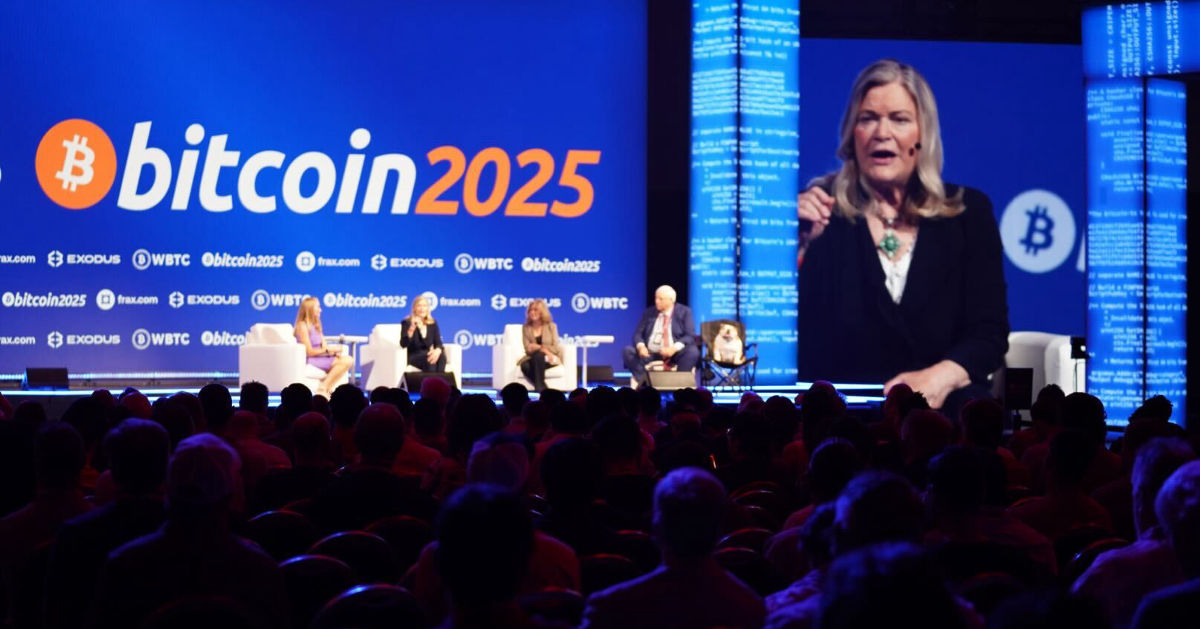
President Trump Supports Strategic Bitcoin Reserve Bill, Senator Lummis SaysToday at the Bitcoin 2025 Conference in Las Vegas, Nevada, US Senator Cynthia Lummis of Wyoming, Senator Marsha Blackburn of Tennessee, and Senator Jim Justice of West Virginia, took the stage to give updates on federal and state level Bitcoin adoption in the United States.
JUST IN:
 Senator Cynthia Lummis said US military generals are "big supporters" of a Strategic Bitcoin Reserve for economic power. pic.twitter.com/2RPMV3tbdA
Senator Cynthia Lummis said US military generals are "big supporters" of a Strategic Bitcoin Reserve for economic power. pic.twitter.com/2RPMV3tbdA— Bitcoin Magazine (@BitcoinMagazine) May 27, 2025
Cynthia Lummis announced that President Donald Trump is supportive of her Strategic Bitcoin Reserve Act, which would see the United States purchase 1,000,000 BTC, among other pro-Bitcoin and stablecoin legislation.
“President Trump supports the bill,” she stated. “And he has a team in the White House working on digital assets — everything from stablecoins to market structure to Bitcoin Strategic Reserve. And they will probably roll out in that order.”
“States have always been the incubators of innovation,” Lummis said. “Senator Justice was the Governor of West Virginia, Senator Blackburn will be the next Governor of Tennessee. The states are where the innovation is occurring.”
“So you have Arizona, Texas and New Hampshire that passed Strategic Bitcoin Reserve bills this year,” she continued. “30 states consider Strategic Bitcoin Reserves. We have the United Arab Emirates purchasing Bitcoin through American exchange traded funds — that’s good for America.”

Senator Blackburn echoed Lummis’ statements, sharing her thoughts on how other countries will follow the United States in their adoption of Bitcoin.
“Many of our allies follow what we do,” Blackburn said. “Everybody wants to be a part of of our market, they want to be a part of our trade. And they will follow what we do. And as Senator Lummis said, we already see countries that are establishing these reserves. So it is vitally important that we hold this as a portion of our reserves.”
Justice emphasized that to be successful, “we have got to get the economics right. Many people ask me many times as Governor, ‘what’s the most important thing you do?’ And I’ll promise you this, it’s all about the economics.”
Justice then went on to explain that when the average, everyday person is using Bitcoin to purchase their necessities, that legislation will start “happening at light speed”, because politicians want to get re-elected and therefore must follow the will of the people.

You can watch the full panel discussion and the rest of the Bitcoin 2025 Conference Industry Day below:
This post President Trump Supports Strategic Bitcoin Reserve Bill, Senator Lummis Says first appeared on Bitcoin Magazine and is written by Nik.
-
 @ 9ca447d2:fbf5a36d
2025-05-28 11:01:17
@ 9ca447d2:fbf5a36d
2025-05-28 11:01:17Steak ‘n Shake recently made headlines by officially accepting bitcoin payments via the Lightning Network across all its U.S. locations. The integration of Bitcoin payments at over 500 locations is a monumental moment for both the fast food industry and the broader retail sector.
This is not just something that Steak ‘n Shake is testing in a handful of locations, they are doing a full-scale rollout, fully embracing Bitcoin.
With more than 100 million customers a year, Steak ‘n Shake’s integration of Lightning—Bitcoin’s fast, low-fee payment layer—makes it easier than ever to use Bitcoin in day-to-day life. Buying a burger and a shake with sats? That’s now a real option.
The process is straightforward. Customers simply scan a Lightning QR code at the register, completing their payment in seconds, while Steak ‘n Shake receives instant USD conversion, ensuring price stability and ease of use.
So what does this mean for Bitcoin and E-commerce?
For starters, Steak ‘n Shake becomes the first of eventually many to fully embrace a digital world. As Bitcoin continues to grow, consumers will continue to realize the benefits of saving in a currency that is truly scarce and decentralized.
This is a huge step forward for Bitcoin as it shows it is not just for holding, it’s for spending, too. And by using the Lightning Network, Steak n’ Shake is helping prove that Bitcoin can scale for everyday transactions.
This now creates a seamless checkout experience, making bitcoin a viable alternative to credit cards and cash.
More importantly, it signals a significant shift in mainstream attitudes towards Bitcoin. As a well-known brand across America, this move serves as a powerful endorsement, likely to influence other chains and retailers to consider similar integrations.
Related: Spar Supermarket in Switzerland Now Accepts Bitcoin Via Lightning
What can this mean for your business?
Accepting bitcoin as payment can open the door to a new demographic of tech-savvy, financially engaged consumers who prefer digital assets.
As we know, companies that adopt Bitcoin receive a fascinating amount of love from the Bitcoin community and I would assume Steak n’ Shake will be receiving the same amount of attention.
From a business perspective, accepting bitcoin has become more than just a payment method—it’s a marketing tool. It sets your business apart and gets people talking. And in a crowded market, that kind of edge matters.
Steak ‘n Shake’s embrace of Bitcoin is likely to accelerate the adoption of digital assets in both physical retail and e-commerce.
As more businesses witness the operational and marketing benefits, industry experts anticipate a ripple effect that will increase interaction between consumers and digital currencies, further regulatory clarity, and bring continued innovation in payment technology.
Steak ‘n Shake’s nationwide Bitcoin payments rollout is more than a novelty. It’s a pivotal development for digital payments, setting a precedent for other retailers and signaling the growing integration of digital assets into everyday commerce.
-
 @ 39cc53c9:27168656
2025-05-27 09:21:53
@ 39cc53c9:27168656
2025-05-27 09:21:53The new website is finally live! I put in a lot of hard work over the past months on it. I'm proud to say that it's out now and it looks pretty cool, at least to me!
Why rewrite it all?
The old kycnot.me site was built using Python with Flask about two years ago. Since then, I've gained a lot more experience with Golang and coding in general. Trying to update that old codebase, which had a lot of design flaws, would have been a bad idea. It would have been like building on an unstable foundation.
That's why I made the decision to rewrite the entire application. Initially, I chose to use SvelteKit with JavaScript. I did manage to create a stable site that looked similar to the new one, but it required Jav aScript to work. As I kept coding, I started feeling like I was repeating "the Python mistake". I was writing the app in a language I wasn't very familiar with (just like when I was learning Python at that mom ent), and I wasn't happy with the code. It felt like spaghetti code all the time.
So, I made a complete U-turn and started over, this time using Golang. While I'm not as proficient in Golang as I am in Python now, I find it to be a very enjoyable language to code with. Most aof my recent pr ojects have been written in Golang, and I'm getting the hang of it. I tried to make the best decisions I could and structure the code as well as possible. Of course, there's still room for improvement, which I'll address in future updates.
Now I have a more maintainable website that can scale much better. It uses a real database instead of a JSON file like the old site, and I can add many more features. Since I chose to go with Golang, I mad e the "tradeoff" of not using JavaScript at all, so all the rendering load falls on the server. But I believe it's a tradeoff that's worth it.
What's new
- UI/UX - I've designed a new logo and color palette for kycnot.me. I think it looks pretty cool and cypherpunk. I am not a graphic designer, but I think I did a decent work and I put a lot of thinking on it to make it pleasant!
- Point system - The new point system provides more detailed information about the listings, and can be expanded to cover additional features across all services. Anyone can request a new point!
- ToS Scrapper: I've implemented a powerful automated terms-of-service scrapper that collects all the ToS pages from the listings. It saves you from the hassle of reading the ToS by listing the lines that are suspiciously related to KYC/AML practices. This is still in development and it will improve for sure, but it works pretty fine right now!
- Search bar - The new search bar allows you to easily filter services. It performs a full-text search on the Title, Description, Category, and Tags of all the services. Looking for VPN services? Just search for "vpn"!
- Transparency - To be more transparent, all discussions about services now take place publicly on GitLab. I won't be answering any e-mails (an auto-reply will prompt to write to the corresponding Gitlab issue). This ensures that all service-related matters are publicly accessible and recorded. Additionally, there's a real-time audits page that displays database changes.
- Listing Requests - I have upgraded the request system. The new form allows you to directly request services or points without any extra steps. In the future, I plan to enable requests for specific changes to parts of the website.
- Lightweight and fast - The new site is lighter and faster than its predecessor!
- Tor and I2P - At last! kycnot.me is now officially on Tor and I2P!
How?
This rewrite has been a labor of love, in the end, I've been working on this for more than 3 months now. I don't have a team, so I work by myself on my free time, but I find great joy in helping people on their private journey with cryptocurrencies. Making it easier for individuals to use cryptocurrencies without KYC is a goal I am proud of!
If you appreciate my work, you can support me through the methods listed here. Alternatively, feel free to send me an email with a kind message!
Technical details
All the code is written in Golang, the website makes use of the chi router for the routing part. I also make use of BigCache for caching database requests. There is 0 JavaScript, so all the rendering load falls on the server, this means it needed to be efficient enough to not drawn with a few users since the old site was reporting about 2M requests per month on average (note that this are not unique users).
The database is running with mariadb, using gorm as the ORM. This is more than enough for this project. I started working with an
sqlitedatabase, but I ended up migrating to mariadb since it works better with JSON.The scraper is using chromedp combined with a series of keywords, regex and other logic. It runs every 24h and scraps all the services. You can find the scraper code here.
The frontend is written using Golang Templates for the HTML, and TailwindCSS plus DaisyUI for the CSS classes framework. I also use some plain CSS, but it's minimal.
The requests forms is the only part of the project that requires JavaScript to be enabled. It is needed for parsing some from fields that are a bit complex and for the "captcha", which is a simple Proof of Work that runs on your browser, destinated to avoid spam. For this, I use mCaptcha.
-
 @ 33baa074:3bb3a297
2025-05-28 07:50:06
@ 33baa074:3bb3a297
2025-05-28 07:50:06Soil moisture is a key factor that affects the structure and function of soil microbial communities. Here are some of the main aspects of how soil moisture affects microorganisms:
Affecting the Growth and Metabolism of Microorganisms Changes in soil moisture content directly affect the growth and metabolic activities of microorganisms. Under suitable moisture conditions, microorganisms are better able to carry out metabolic activities, thereby promoting the decomposition of soil organic matter and the transformation of nutrients. However, under extremely dry or overly wet conditions, the activity of microorganisms will be inhibited, resulting in a decline in soil functions.

Changing the Structure of Microbial Communities Changes in soil moisture conditions can lead to significant changes in the structure of microbial communities. For example, under drought conditions, the number of drought-tolerant microorganisms may increase to adapt to the water shortage environment. While under wet conditions, aerobic microorganisms may dominate. This change in community structure not only affects the soil's water retention capacity, but also other ecological functions of the soil.
Affecting the Stability of Soil Aggregates Soil aggregates are clumps formed by soil particles through physical, chemical and biological actions, and they have an important impact on the soil's water retention capacity. Soil microorganisms participate in the formation and stability of soil aggregates by secreting substances such as extracellular polymers. Appropriate soil moisture helps maintain the stability of soil aggregates, thereby improving the soil's water retention capacity. However, excessive moisture or drought may lead to the destruction of soil aggregates and reduce the soil's water retention capacity.
Regulating soil moisture dynamics Soil microorganisms can regulate the dynamic balance of soil moisture through their metabolic activities, such as decomposing organic matter and synthesizing exopolysaccharides. For example, some microorganisms can increase the water holding capacity of the soil by secreting exopolysaccharides, while others can release water by decomposing organic matter. These activities help maintain the stability of soil moisture and support plant growth.
Influencing the physical properties of soil Soil moisture can also indirectly affect the living environment of microorganisms by affecting the physical properties of the soil, such as pore structure and texture. Good soil pore structure is conducive to the penetration and storage of water, and also provides a suitable living space for microorganisms. Soil texture is closely related to the stability of aggregates. Sandy soils have poor aggregate stability and weak water retention capacity; while clay soils have good aggregate stability and strong water retention capacity.
In summary, soil moisture has many effects on microorganisms, including affecting the growth and metabolism of microorganisms, changing the structure of microbial communities, affecting the stability of soil aggregates, regulating soil moisture dynamics, and affecting the physical properties of soil. Therefore, maintaining suitable soil moisture conditions is of great significance for protecting the diversity and function of soil microbial communities and improving the water retention capacity of soil.
-
 @ 21810ca8:f2e8341e
2025-05-28 08:10:53
@ 21810ca8:f2e8341e
2025-05-28 08:10:53Ich bin neu bei Nostr und versuche mich hier rein zu fuchsen. Kann das einer sehen? Und dann habe ich noch viele Fragen
Gibt es gute Marktplätze wie ebay oder ebay kleinanzeigen wo man stink normale dinge und kram von zuhause gegen sat verkaufen kann.
-
 @ 39cc53c9:27168656
2025-05-27 09:21:51
@ 39cc53c9:27168656
2025-05-27 09:21:51Know Your Customer is a regulation that requires companies of all sizes to verify the identity, suitability, and risks involved with maintaining a business relationship with a customer. Such procedures fit within the broader scope of anti-money laundering (AML) and counterterrorism financing (CTF) regulations.
Banks, exchanges, online business, mail providers, domain registrars... Everyone wants to know who you are before you can even opt for their service. Your personal information is flowing around the internet in the hands of "god-knows-who" and secured by "trust-me-bro military-grade encryption". Once your account is linked to your personal (and verified) identity, tracking you is just as easy as keeping logs on all these platforms.
Rights for Illusions
KYC processes aim to combat terrorist financing, money laundering, and other illicit activities. On the surface, KYC seems like a commendable initiative. I mean, who wouldn't want to halt terrorists and criminals in their tracks?
The logic behind KYC is: "If we mandate every financial service provider to identify their users, it becomes easier to pinpoint and apprehend the malicious actors."
However, terrorists and criminals are not precisely lining up to be identified. They're crafty. They may adopt false identities or find alternative strategies to continue their operations. Far from being outwitted, many times they're several steps ahead of regulations. Realistically, KYC might deter a small fraction – let's say about 1% ^1 – of these malefactors. Yet, the cost? All of us are saddled with the inconvenient process of identification just to use a service.
Under the rhetoric of "ensuring our safety", governments and institutions enact regulations that seem more out of a dystopian novel, gradually taking away our right to privacy.
To illustrate, consider a city where the mayor has rolled out facial recognition cameras in every nook and cranny. A band of criminals, intent on robbing a local store, rolls in with a stolen car, their faces obscured by masks and their bodies cloaked in all-black clothes. Once they've committed the crime and exited the city's boundaries, they switch vehicles and clothes out of the cameras' watchful eyes. The high-tech surveillance? It didn’t manage to identify or trace them. Yet, for every law-abiding citizen who merely wants to drive through the city or do some shopping, their movements and identities are constantly logged. The irony? This invasive tracking impacts all of us, just to catch the 1% ^1 of less-than-careful criminals.
KYC? Not you.
KYC creates barriers to participation in normal economic activity, to supposedly stop criminals. ^2
KYC puts barriers between many users and businesses. One of these comes from the fact that the process often requires multiple forms of identification, proof of address, and sometimes even financial records. For individuals in areas with poor record-keeping, non-recognized legal documents, or those who are unbanked, homeless or transient, obtaining these documents can be challenging, if not impossible.
For people who are not skilled with technology or just don't have access to it, there's also a barrier since KYC procedures are mostly online, leaving them inadvertently excluded.
Another barrier goes for the casual or one-time user, where they might not see the value in undergoing a rigorous KYC process, and these requirements can deter them from using the service altogether.
It also wipes some businesses out of the equation, since for smaller businesses, the costs associated with complying with KYC norms—from the actual process of gathering and submitting documents to potential delays in operations—can be prohibitive in economical and/or technical terms.
You're not welcome
Imagine a swanky new club in town with a strict "members only" sign. You hear the music, you see the lights, and you want in. You step up, ready to join, but suddenly there's a long list of criteria you must meet. After some time, you are finally checking all the boxes. But then the club rejects your membership with no clear reason why. You just weren't accepted. Frustrating, right?
This club scenario isn't too different from the fact that KYC is being used by many businesses as a convenient gatekeeping tool. A perfect excuse based on a "legal" procedure they are obliged to.
Even some exchanges may randomly use this to freeze and block funds from users, claiming these were "flagged" by a cryptic system that inspects the transactions. You are left hostage to their arbitrary decision to let you successfully pass the KYC procedure. If you choose to sidestep their invasive process, they might just hold onto your funds indefinitely.
Your identity has been stolen
KYC data has been found to be for sale on many dark net markets^3. Exchanges may have leaks or hacks, and such leaks contain very sensitive data. We're talking about the full monty: passport or ID scans, proof of address, and even those awkward selfies where you're holding up your ID next to your face. All this data is being left to the mercy of the (mostly) "trust-me-bro" security systems of such companies. Quite scary, isn't it?
As cheap as $10 for 100 documents, with discounts applying for those who buy in bulk, the personal identities of innocent users who passed KYC procedures are for sale. ^3
In short, if you have ever passed the KYC/AML process of a crypto exchange, your privacy is at risk of being compromised, or it might even have already been compromised.
(they) Know Your Coins
You may already know that Bitcoin and most cryptocurrencies have a transparent public blockchain, meaning that all data is shown unencrypted for everyone to see and recorded forever. If you link an address you own to your identity through KYC, for example, by sending an amount from a KYC exchange to it, your Bitcoin is no longer pseudonymous and can then be traced.
If, for instance, you send Bitcoin from such an identified address to another KYC'ed address (say, from a friend), everyone having access to that address-identity link information (exchanges, governments, hackers, etc.) will be able to associate that transaction and know who you are transacting with.
Conclusions
To sum up, KYC does not protect individuals; rather, it's a threat to our privacy, freedom, security and integrity. Sensible information flowing through the internet is thrown into chaos by dubious security measures. It puts borders between many potential customers and businesses, and it helps governments and companies track innocent users. That's the chaos KYC has stirred.
The criminals are using stolen identities from companies that gathered them thanks to these very same regulations that were supposed to combat them. Criminals always know how to circumvent such regulations. In the end, normal people are the most affected by these policies.
The threat that KYC poses to individuals in terms of privacy, security and freedom is not to be neglected. And if we don’t start challenging these systems and questioning their efficacy, we are just one step closer to the dystopian future that is now foreseeable.
Edited 20/03/2024 * Add reference to the 1% statement on Rights for Illusions section to an article where Chainalysis found that only 0.34% of the transaction volume with cryptocurrencies in 2023 was attributable to criminal activity ^1
-
 @ 33baa074:3bb3a297
2025-05-28 07:27:02
@ 33baa074:3bb3a297
2025-05-28 07:27:02Distilled water has a wide range of applications in the medical field, mainly including the following aspects: Preparation of injection water Distilled water is an indispensable agent in medical institutions, used for the preparation of drugs, injection and washing of instruments, etc. In the medical process, sterile injection water is needed to flush wounds, prepare drugs, etc. The distilled water machine can ensure the purity of water and prevent microorganisms and harmful substances in the water from causing harm to patients.
Surgical wound flushing In breast cancer surgery, warm distilled water is used to flush surgical wounds. This practice helps to clean the wound, remove possible residual tumor cells, and use hypnotic effect to make tumor cells absorb water, swell, rupture, and necrotic, thereby preventing tumors from growing in the wound.
Cleaning and disinfection Distilled water has a certain disinfection and sterilization effect. It can be used to clean the skin, help eliminate bacteria on the skin surface, and is beneficial to the health of the skin. In addition, distilled water can also be used to clean and disinfect medical equipment to ensure the hygiene and safety of the medical environment.
Laboratory use In medical-related laboratories, distilled water is used to prepare experimental solutions, wash utensils and experimental instruments. These applications ensure the accuracy of experimental results while maintaining the sterile environment of the laboratory.
Moisturizing and Beauty Although not directly used in medical applications, distilled water is also used in skin care. It can be used as a basic moisturizer to help improve the symptoms of dry skin. In the field of medical beauty, distilled water is sometimes used for facial compresses to achieve calming, cooling, and swelling effects.
In summary, the application of distilled water in the medical field is multifaceted, from basic injection water preparation to complex surgical assistance to daily skin care, it has played an important role.
-
 @ 3770c235:16042bcc
2025-05-28 05:54:01
@ 3770c235:16042bcc
2025-05-28 05:54:01** Introduction: The Neon Pulse of Las Vegas
**It’s 2:30 AM on a Tuesday. The Strip hums with laughter, clinking glasses, and the occasional Elvis impersonator. A group of friends stumbles out of a nightclub, squinting under the glow of a Las Vegas billboard that screams, “Hungry? $5 Pancakes → 1 Block Right!” Ten minutes later, they’re drowning their late-night cravings in syrup.This isn’t luck—it’s Las Vegas billboards doing what they do best: working while the rest of the world sleeps. In a city where the party never stops, these glowing giants are the ultimate salespeople. Let’s dive into why Las Vegas billboards outshine traditional ads and how your business can ride their 24/7 energy wave.
** Why Las Vegas Billboards Never Take a Coffee Break
** 1. Tourists Don’t Have Bedtimes (and Neither Do Billboards)
- 42 million visitors flock to Vegas yearly. They’re sipping margaritas at noon, gambling at midnight, and shopping at 3 AM.
- Las Vegas billboards near hotspots like the Bellagio Fountains or Fremont Street catch eyes round the clock.Real Story:
A donut shop owner named Luis rented a billboard near the “Welcome to Vegas” sign. His message? “Jet Lagged? Sugar Fix Open 24/7!” Sales tripled—especially between 1 AM and 4 AM.** 2. You Can’t “Skip” a Billboard
** - Imagine this: You’re stuck in traffic on the Strip. Your phone’s dead. That Las Vegas billboard for air-conditioned massages? It’s your lifeline.
- Compare that to online ads: 47% of people skip them, and TikTok ads vanish in a scroll.- Vegas Thrives on Impulse
- Billboards tap into spontaneous decisions:
- “Let’s try that rooftop bar!”
- “Wait, free slot play? Let’s U-turn!”
- Traditional ads (like radio spots) fade fast. Billboards linger, nudging tourists to act now.
** 5 Reasons Your Business Needs a Vegas Billboard
** 1. Size Matters (And So Does Flash)
- Strip billboards can be taller than a 5-story building.
- Digital screens use LEDs so bright, they’re visible from space.Pro Tip:
A casino added fake “smoke” effects to their billboard for a Halloween promo. Traffic backed up for selfies—and bookings spiked.- No Language Barrier
- Vegas draws visitors from Tokyo, Berlin, São Paulo...
- A Las Vegas billboard with a giant cocktail emoji? Universal for “Drinks here!”
Case Study:
A Korean BBQ spot used a billboard of sizzling meat. No words. Just smoke visuals. Tourists followed the “aroma” straight to their door.- They’re Always in the Right Place, Right Time
- 6 AM: Joggers see smoothie ads.
- 3 PM: Pool partiers spot “Free Margarita” promos.
-
Midnight: Hangover clinics whisper, “We’ve got IVs.”
-
Instant Trust Boost
- A tiny online ad says “startup.” A glowing billboard says, “We’re Vegas royalty.”
Jake’s Win:
Jake’s tiny magic shop rented a billboard reading, “Real Tricks—Cheaper Than the Casino!” Tourists treated him like David Blaine.- QR Codes = Instant Customers
- “Scan for free parking!” → 1,000 scans in a weekend.
- “Tap to call a limo” → Rides booked before the light turns green.
** How to Make Your Vegas Billboard Irresistible
** Step 1: Claim Your Territory
- The Strip: Pricey but prime ($15k–$60k/month).
- Fremont Street: Quirky, cheaper ($5k–$20k), packed with partiers.
- Highway 15: Target road-trippers with “Almost There! Cold Beer Ahead!”Step 2: Keep It Stupid Simple
- Bad: “Experience Culinary Excellence at Our Artisanal Bistro!”
- Good: “24/7 Bacon Pancakes → Exit Here.”Maria’s Hack:
Maria’s tattoo parlor used a billboard with a flaming skull and three words: “Walk-Ins Welcome.” No phone number. “People just… show up,” she laughs.Step 3: Track Your Wins (Like a Vegas High Roller)
- QR Codes: “Scan for Free Slot Play!” → Track scans.
- Unique URLs: “Visit VegasPizza24.com” → Monitor traffic.
- Old-School: Count foot traffic. (“Did that bachelor party just roll in from our billboard? Yes.”)**FAQs ** 1. “How do I even measure if my billboard’s working? It’s not like online ads!”
Answer:
You’re right—it’s not just clicks and likes. But here’s how real businesses track success:
- QR Codes: Add a unique code like “Scan for Free Appetizer!” Track scans.
- Promo Codes: “Mention this billboard for 20% off!” (Works great for Uber drivers: “My passengers blurt it out mid-ride,” says driver Luis M.)
- Foot Traffic Spikes: Note sales surges after your ad goes live. A dispensary saw a 60% bump in visits after their “We’re Closer Than the Casino!” billboard.
- Social Media Tags: Encourage selfies with your billboard. A retro motel offered a free pool pass for tagged photos. Their Instagram exploded.- “Aren’t billboards old-school? My Gen Z customers live on TikTok!”
Answer:
Billboards in Vegas are anything but old-school. Here’s why: - Hybrid Campaigns: Pair billboards with geofenced mobile ads. Example: A billboard for a pool party says, “Scan to Pre-Order Drinks.” Users nearby get a TikTok-style ad on their phone.
- Instagrammable Designs: Quirky billboards go viral. The “Welcome to Vegas” sign is the most Instagrammed spot in the city. Mimic that vibe!
- Influencer Collabs: Pay a Vegas influencer to pose with your billboard. Their followers will hunt it down like a scavenger hunt.
Real Story:
A vintage clothing store’s billboard (“Find Your Retro Vibe → 2 Blocks East”) became a TikTok trend after a local influencer did a “thrift haul” video there.** 3. “What’s the biggest mistake businesses make with Vegas billboards?”
** Answer:
Trying to cram in too much info! Drivers have 5–7 seconds to read your ad. Avoid:
- Text Overload: “Grand Opening! 50% Off! Open 24/7! Call Now!” → Too much!
- Bland Designs: Gray text on a gray background? Yawn.
- Ignoring Locals: Tourists are 70% of viewers, but locals matter too. A gym’s billboard said, “Tired of Tourists? Work Out in Peace.” Memberships spiked.Fix It:
- Use 7 words max.
- Bold colors (red, yellow, neon pink).
- Add a clear call to action: “Turn Right Now!” or “Scan for Free Parking.”- “Do I need a permit? What if my ad gets rejected?”
Answer:
Yep, permits are a thing. The city bans: - Flashing Lights Near Residences: No strobes in suburban areas.
- Certain Content: No swear words, adult themes, or political fights.
How to Avoid Rejection:
- Work with local Outdoor Advertising companies—they know the rules.
- Submit designs early. One pizza joint’s ad was flagged for a pepperoni slice deemed “too suggestive.” They swapped it to a cheese pull… and it got approved.Conclusion: Let Your Business Shine All Night Long
At 5 AM, as the sun peeks over the desert, the Las Vegas billboards keep glowing. They’ve sold midnight pancakes, inspired shotgun weddings, and even talked someone out of a questionable tattoo (“Wait! Our Parlor’s Better → Next Exit”).These aren’t just ads—they’re part of Vegas’ heartbeat. So whether you’re slinging sushi, massages, or monster truck rides, remember: In a city that never sleeps, your billboard shouldn’t either.
Ready to Light Up the Night?
Find Las Vegas billboards near you today. And if you spot one that says, “Free High-Fives for Readers of This Article,” honk twice. It’s probably yours. -
 @ 39cc53c9:27168656
2025-05-27 09:21:50
@ 39cc53c9:27168656
2025-05-27 09:21:50Over the past few months, I've dedicated my time to a complete rewrite of the kycnot.me website. The technology stack remains unchanged; Golang paired with TailwindCSS. However, I've made some design choices in this iteration that I believe significantly enhance the site. Particularly to backend code.
UI Improvements
You'll notice a refreshed UI that retains the original concept but has some notable enhancements. The service list view is now more visually engaging, it displays additional information in a more aesthetically pleasing manner. Both filtering and searching functionalities have been optimized for speed and user experience.
Service pages have been also redesigned to highlight key information at the top, with the KYC Level box always accessible. The display of service attributes is now more visually intuitive.
The request form, especially the Captcha, has undergone substantial improvements. The new self-made Captcha is robust, addressing the reliability issues encountered with the previous version.
Terms of Service Summarizer
A significant upgrade is the Terms of Service summarizer/reviewer, now powered by AI (GPT-4-turbo). It efficiently condenses each service's ToS, extracting and presenting critical points, including any warnings. Summaries are updated monthly, processing over 40 ToS pages via the OpenAI API using a self-crafted and thoroughly tested prompt.
Nostr Comments
I've integrated a comment section for each service using Nostr. For guidance on using this feature, visit the dedicated how-to page.
Database
The backend database has transitioned to pocketbase, an open-source Golang backend that has been a pleasure to work with. I maintain an updated fork of the Golang SDK for pocketbase at pluja/pocketbase.
Scoring
The scoring algorithm has also been refined to be more fair. Despite I had considered its removal due to the complexity it adds (it is very difficult to design a fair scoring system), some users highlighted its value, so I kept it. The updated algorithm is available open source.
Listings
Each listing has been re-evaluated, and the ones that were no longer operational were removed. New additions are included, and the backlog of pending services will be addressed progressively, since I still have access to the old database.
API
The API now offers more comprehensive data. For more details, check here.
About Page
The About page has been restructured for brevity and clarity.
Other Changes
Extensive changes have been implemented in the server-side logic, since the whole code base was re-written from the ground up. I may discuss these in a future post, but for now, I consider the current version to be just a bit beyond beta, and additional updates are planned in the coming weeks.
-
 @ eb0157af:77ab6c55
2025-05-28 10:01:29
@ eb0157af:77ab6c55
2025-05-28 10:01:29Michigan lawmakers are unveiling a comprehensive strategy to regulate Bitcoin and cryptocurrencies.
On May 21, Republican Representative Bill Schuette introduced House Bill 4510, a proposal to amend the Michigan Public Employee Retirement System Investment Act. The legislation would allow the state treasurer, currently Rachael Eubanks, to diversify the state’s investments by including cryptocurrencies with an average market capitalization of over $250 million in the past calendar year.
Under current criteria, Bitcoin (BTC) and Ether (ETH) are the only cryptocurrencies that meet these selection standards. The proposal specifies that any investment in digital assets must be made through exchange-traded products (spot ETFs) issued by registered investment companies.
Anti-CBDC legislation
Republican Representative Bryan Posthumus is leading the bipartisan initiative behind the second bill, HB 4511, which establishes protections for cryptocurrency holders. The proposal prohibits Michigan from implementing crypto bans or imposing licensing requirements on digital asset holders.
Another key aspect of the legislation is a ban on state officials from supporting or promoting a potential federal central bank digital currency (CBDC). The definition includes the issuance of memorandums or official statements endorsing CBDC proposals related to testing, adoption, or implementation.
Mining and redevelopment of abandoned sites
The third bill, HB 4512, is a proposal led by Democratic Representative Mike McFall for a bipartisan group. This initiative would establish a Bitcoin mining program allowing operators to use abandoned oil and natural gas sites.
The program calls for the appointment of a supervisor tasked with assessing the site’s remaining productive potential, identifying the last operator, and determining the length of abandonment. Prospective participants would need to submit detailed legal documentation of their organizational structure, demonstrate operational expertise in mining, and provide profitability breakeven estimates for their ventures.
The fourth and final bill, HB 4513, also introduced by the bipartisan group led by McFall, focuses on the fiscal aspect of the HB 4512 initiative. The proposal would amend Michigan’s income tax laws to include proceeds generated from the proposed Bitcoin mining program.
The post Michigan: four bills on pension funds, CBDCs, and mining appeared first on Atlas21.
-
 @ 39cc53c9:27168656
2025-05-27 09:21:48
@ 39cc53c9:27168656
2025-05-27 09:21:48I'm launching a new service review section on this blog in collaboration with OrangeFren. These reviews are sponsored, yet the sponsorship does not influence the outcome of the evaluations. Reviews are done in advance, then, the service provider has the discretion to approve publication without modifications.
Sponsored reviews are independent from the kycnot.me list, being only part of the blog. The reviews have no impact on the scores of the listings or their continued presence on the list. Should any issues arise, I will not hesitate to remove any listing.
The review
WizardSwap is an instant exchange centred around privacy coins. It was launched in 2020 making it old enough to have weathered the 2021 bull run and the subsequent bearish year.
| Pros | Cons | |------|------| | Tor-friendly | Limited liquidity | | Guarantee of no KYC | Overly simplistic design | | Earn by providing liquidity | |
Rating: ★★★★★ Service Website: wizardswap.io
Liquidity
Right off the bat, we'll start off by pointing out that WizardSwap relies on its own liquidity reserves, meaning they aren't just a reseller of Binance or another exchange. They're also committed to a no-KYC policy, when asking them, they even promised they would rather refund a user their original coins, than force them to undergo any sort of verification.
On the one hand, full control over all their infrastructure gives users the most privacy and conviction about the KYC policies remaining in place.
On the other hand, this means the liquidity available for swapping isn't huge. At the time of testing we could only purchase at most about 0.73 BTC with XMR.
It's clear the team behind WizardSwap is aware of this shortfall and so they've come up with a solution unique among instant exchanges. They let you, the user, deposit any of the currencies they support into your account and earn a profit on the trades made using your liquidity.
Trading
Fees on WizardSwap are middle-of-the-pack. The normal fee is 2.2%. That's more than some exchanges that reserve the right to suddenly demand you undergo verification, yet less than half the fees on some other privacy-first exchanges. However as we mentioned in the section above you can earn almost all of that fee (2%) if you provide liquidity to WizardSwap.
It's good that with the current Bitcoin fee market their fees are constant regardless of how much, or how little, you send. This is in stark contrast with some of the alternative swap providers that will charge you a massive premium when attempting to swap small amounts of BTC away.
Test trades
Test trades are always performed without previous notice to the service provider.
During our testing we performed a few test trades and found that every single time WizardSwap immediately detected the incoming transaction and the amount we received was exactly what was quoted before depositing. The fees were inline with what WizardSwap advertises.

- Monero payment proof
- Bitcoin received
- Wizardswap TX link - it's possible that this link may cease to be valid at some point in the future.
ToS and KYC
WizardSwap does not have a Terms of Service or a Privacy Policy page, at least none that can be found by users. Instead, they offer a FAQ section where they addresses some basic questions.
The site does not mention any KYC or AML practices. It also does not specify how refunds are handled in case of failure. However, based on the FAQ section "What if I send funds after the offer expires?" it can be inferred that contacting support is necessary and network fees will be deducted from any refund.
UI & Tor
WizardSwap can be visited both via your usual browser and Tor Browser. Should you decide on the latter you'll find that the website works even with the most strict settings available in the Tor Browser (meaning no JavaScript).
However, when disabling Javascript you'll miss the live support chat, as well as automatic refreshing of the trade page. The lack of the first means that you will have no way to contact support from the trade page if anything goes wrong during your swap, although you can do so by mail.
One important thing to have in mind is that if you were to accidentally close the browser during the swap, and you did not save the swap ID or your browser history is disabled, you'll have no easy way to return to the trade. For this reason we suggest when you begin a trade to copy the url or ID to someplace safe, before sending any coins to WizardSwap.
The UI you'll be greeted by is simple, minimalist, and easy to navigate. It works well not just across browsers, but also across devices. You won't have any issues using this exchange on your phone.
Getting in touch
The team behind WizardSwap appears to be most active on X (formerly Twitter): https://twitter.com/WizardSwap_io
If you have any comments or suggestions about the exchange make sure to reach out to them. In the past they've been very receptive to user feedback, for instance a few months back WizardSwap was planning on removing DeepOnion, but the community behind that project got together ^1 and after reaching out WizardSwap reversed their decision ^2.
You can also contact them via email at:
support @ wizardswap . ioDisclaimer
None of the above should be understood as investment or financial advice. The views are our own only and constitute a faithful representation of our experience in using and investigating this exchange. This review is not a guarantee of any kind on the services rendered by the exchange. Do your own research before using any service.
-
 @ 9ca447d2:fbf5a36d
2025-05-28 07:01:16
@ 9ca447d2:fbf5a36d
2025-05-28 07:01:16Steak ‘n Shake recently made headlines by officially accepting bitcoin payments via the Lightning Network across all its U.S. locations. The integration of Bitcoin payments at over 500 locations is a monumental moment for both the fast food industry and the broader retail sector.
This is not just something that Steak ‘n Shake is testing in a handful of locations, they are doing a full-scale rollout, fully embracing Bitcoin.
With more than 100 million customers a year, Steak ‘n Shake’s integration of Lightning—Bitcoin’s fast, low-fee payment layer—makes it easier than ever to use Bitcoin in day-to-day life. Buying a burger and a shake with sats? That’s now a real option.
The process is straightforward. Customers simply scan a Lightning QR code at the register, completing their payment in seconds, while Steak ‘n Shake receives instant USD conversion, ensuring price stability and ease of use.
So what does this mean for Bitcoin and E-commerce?
For starters, Steak ‘n Shake becomes the first of eventually many to fully embrace a digital world. As Bitcoin continues to grow, consumers will continue to realize the benefits of saving in a currency that is truly scarce and decentralized.
This is a huge step forward for Bitcoin as it shows it is not just for holding, it’s for spending, too. And by using the Lightning Network, Steak n’ Shake is helping prove that Bitcoin can scale for everyday transactions.
This now creates a seamless checkout experience, making bitcoin a viable alternative to credit cards and cash.
More importantly, it signals a significant shift in mainstream attitudes towards Bitcoin. As a well-known brand across America, this move serves as a powerful endorsement, likely to influence other chains and retailers to consider similar integrations.
Related: Spar Supermarket in Switzerland Now Accepts Bitcoin Via Lightning
What can this mean for your business?
Accepting bitcoin as payment can open the door to a new demographic of tech-savvy, financially engaged consumers who prefer digital assets.
As we know, companies that adopt Bitcoin receive a fascinating amount of love from the Bitcoin community and I would assume Steak n’ Shake will be receiving the same amount of attention.
From a business perspective, accepting bitcoin has become more than just a payment method—it’s a marketing tool. It sets your business apart and gets people talking. And in a crowded market, that kind of edge matters.
Steak ‘n Shake’s embrace of Bitcoin is likely to accelerate the adoption of digital assets in both physical retail and e-commerce.
As more businesses witness the operational and marketing benefits, industry experts anticipate a ripple effect that will increase interaction between consumers and digital currencies, further regulatory clarity, and bring continued innovation in payment technology.
Steak ‘n Shake’s nationwide Bitcoin payments rollout is more than a novelty. It’s a pivotal development for digital payments, setting a precedent for other retailers and signaling the growing integration of digital assets into everyday commerce.
-
 @ eb0157af:77ab6c55
2025-05-28 06:01:29
@ eb0157af:77ab6c55
2025-05-28 06:01:29Bitcoin surpasses gold in the United States: 50 million holders and a dominant role in the global market.
According to a new report by River, for the first time in history, the number of Americans owning bitcoin has surpassed that of gold holders. The analysis reveals that approximately 50 million U.S. citizens currently own the cryptocurrency, while gold owners number 37 million. In fact, 14.3% of Americans own bitcoin, the highest percentage of holders worldwide.

Source: River
The report highlights that 40% of all Bitcoin-focused companies are based in the United States, consolidating America’s dominant position in the sector. Additionally, 40.5% of Bitcoin holders are men aged 31 to 35, followed by 35.9% of men aged 41 to 45. In contrast, only 13.4% of holders are women.

Source: River
Notably, U.S. companies hold 94.8% of all bitcoins owned by publicly traded companies worldwide. According to the report, recent regulatory changes in the U.S. have made the asset more accessible through financial products such as spot ETFs.
The document also shows that American investors increasingly view the cryptocurrency as protection against fiscal instability and inflation, appreciating its limited supply and decentralized governance model.
For River, Bitcoin offers significant practical advantages over gold in the modern digital era. Its ease of custody, cross-border transfer, and liquidity make the cryptocurrency an attractive option for both individual and institutional investors, the report suggests.
The post USA: 50 million Americans own bitcoin appeared first on Atlas21.
-
 @ 6e0ea5d6:0327f353
2025-05-28 04:34:08
@ 6e0ea5d6:0327f353
2025-05-28 04:34:08Ascolta bene! It is more dignified to thirst alone in the desert than to share wine with someone who has no thirst for conquest.
On the silent path to success, it’s not the declared enemies who slow the march, but rather the friends. Not the noble or loyal ones, but the failures—those who carry a dull glint in their eyes, chronic laziness in their spirit, and the eternal excuse of bad luck in their pockets. Friendship, when poorly chosen, becomes a polished anchor, tied to your ankle with ropes named camaraderie.
Nothing weighs heavier on the journey than having to endure the failed and envious around you. It is a kind of emotional parasitism that begins with empathy and ends in stagnation. Those who live among the weak will crawl. Those who keep company with miserable friends, instead of striving to prosper, learn to curse wealth—not out of ethics, but out of envy. Mediocrity, my friend, is contagious. And it does not take root suddenly, but like a silent epidemic.
Ambition—that fire that burns in the bones of great men—will always seem like arrogance to the ears of the failed. Those who have never built anything, except arguments to justify their paralysis, will never understand the fury of someone born to conquer. And so, with smiles, they spit venom: “Calm down,” they say, “be content,” they advise. Hypocrites. What they call humility is nothing more than resignation to their own defeat.
To walk alone, with hunger and honor, is worth more than feasting at lavish tables at the cost of your own sweat, surrounded by parasites who toast your downfall with glasses full of praise. No one prospers where the conversation is filled with complaints, criticism, and envy. What does not build up, corrodes.
The rust of the weak is invisible at first—a bitter joke here, a veiled critique there. And before you know it, the structure is already rotten. Of the friendship, only the weight remains. Of the relationship, only exhaustion. The true enemy of success is the company of those who have failed and wish for you the same fate. These tragic figures—always tired, always victims—are masters of collective self-sabotage.
Feel no remorse in abandoning those who build nothing and consume everything. And in that abandonment, you become freer, stronger, and unbreakable.
Thank you for reading, my friend!
If this message resonated with you, consider leaving your "🥃" as a token of appreciation.
A toast to our family!
-
 @ 1d7ff02a:d042b5be
2025-05-28 04:02:47
@ 1d7ff02a:d042b5be
2025-05-28 04:02:47For those who still don't truly understand Bitcoin, it means you still don't understand what money is, who creates it, and why humans need money.
It's a scam that the education system doesn't teach this important subject, while we spend almost our entire lives trying to earn money. Therefore, I recommend following the money and studying Bitcoin seriously.
Why Bitcoin Matters
Saving is the greatest discovery in human history
Before humans learned to save, we were just animals living day to day. Saving is what makes humans different from other animals — the ability to think about the future and store for later.
Saving created civilization itself
Without saving, there would be no cities, no science, no art. Everything we call "progress" comes from the ability to save.
Money is the greatest creation in human history
It is the tool that has allowed human civilization to advance to this day. Money is the best tool humans use for saving.
Bitcoin is the best money ever created
It is the most perfect money humans have ever created. No one can control, manipulate, destroy it, and it is truly limited like time in life.
Bitcoin is like a black hole
That will absorb all value from the damaged financial system. It will draw stability and value to itself. Everything of value will flow into Bitcoin eventually.
Bitcoin is like Buddhism discovering truth
It helps understand the root problems of the current financial system and the emergence of many problems in society, just like Buddha who understood all suffering and the causes of suffering.
Bitcoin is freedom
Money is power, money controls human behavior. When we have money that preserves value and cannot be controlled, we will have intellectual freedom, freedom of expression, and the power to choose.
The debt that humanity has created today would take another thousand years to pay off completely
There is no way out and it's heading toward serious collapse. Bitcoin is the light that will help prevent humanity from entering another dark age.
Bitcoin cannot steal your time
It cannot be created from nothing. Every Bitcoin requires real energy and time to create.
Bitcoin is insurance that protects against mismanagement
It helps protect against currency debasement, economic depression, and failed policies. Bitcoin will protect your value.
Bitcoin is going to absorb the world's value
Eventually, Bitcoin will become the store of value for the entire world. It will absorb wealth from all assets, all prices, and all investments.
Exit The Matrix
We live in a financial Matrix. Every day we wake up and go to work, thinking we're building a future for ourselves. But in reality, we're just giving energy to a system that extracts value from us every second. Bitcoin is the red pill — it will open your eyes to see the truth of the financial world. Central banks are the architects of this Matrix — they create money from nothing, and we have to work hard to get it.
The education system has deceived us greatly. They teach us to work for money, but never teach us what money is. We spend 12-16 years in school, then spend our entire lives earning money, but never know what it is, who creates it, and why it has value. This is the biggest scam in human history.
We are taught to be slaves of the system, but not taught to understand the system.
The Bitcoin standard will end war
When you can't print money for war anymore, war becomes too expensive.
We are entering the Bitcoin Renaissance era
An era of financial and intellectual revival. Bitcoin is creating a new class of humans. People who understand and hold Bitcoin will become a new class with true freedom.
The Path to Financial Truth
Follow the money trail and you will see the truth: - Who controls money printing? - Why do prices keep getting higher? - Why are the poor getting poorer and the rich getting richer?
All the answers lie in understanding money and Bitcoin.
Studying Bitcoin is not just about investment — it's about understanding the future of currency and human society.
Don't just work for money. Understand money. Study Bitcoin.
If you don't understand money, you will be a slave to the system forever. If you understand Bitcoin, you will gain freedom.
-
 @ 39cc53c9:27168656
2025-05-27 09:21:46
@ 39cc53c9:27168656
2025-05-27 09:21:46Bitcoin enthusiasts frequently and correctly remark how much value it adds to Bitcoin not to have a face, a leader, or a central authority behind it. This particularity means there isn't a single person to exert control over, or a single human point of failure who could become corrupt or harmful to the project.
Because of this, it is said that no other coin can be equally valuable as Bitcoin in terms of decentralization and trustworthiness. Bitcoin is unique not just for being first, but also because of how the events behind its inception developed. This implies that, from Bitcoin onwards, any coin created would have been created by someone, consequently having an authority behind it. For this and some other reasons, some people refer to Bitcoin as "The Immaculate Conception".
While other coins may have their own unique features and advantages, they may not be able to replicate Bitcoin's community-driven nature. However, one other cryptocurrency shares a similar story of mystery behind its creation: Monero.
History of Monero
Bytecoin and CryptoNote
In March 2014, a Bitcointalk thread titled "Bytecoin. Secure, private, untraceable since 2012" was initiated by a user under the nickname "DStrange"^1^. DStrange presented Bytecoin (BCN) as a unique cryptocurrency, in operation since July 2012. Unlike Bitcoin, it employed a new algorithm known as CryptoNote.
DStrange apparently stumbled upon the Bytecoin website by chance while mining a dying bitcoin fork, and decided to create a thread on Bitcointalk^1^. This sparked curiosity among some users, who wondered how could Bytecoin remain unnoticed since its alleged launch in 2012 until then^2^.
Some time after, a user brought up the "CryptoNote v2.0" whitepaper for the first time, underlining its innovative features^4^. Authored by the pseudonymous Nicolas van Saberhagen in October 2013, the CryptoNote v2 whitepaper^5^ highlighted the traceability and privacy problems in Bitcoin. Saberhagen argued that these flaws could not be quickly fixed, suggesting it would be more efficient to start a new project rather than trying to patch the original^5^, an statement simmilar to the one from Satoshi Nakamoto^6^.
Checking with Saberhagen's digital signature, the release date of the whitepaper seemed correct, which would mean that Cryptonote (v1) was created in 2012^7^, although there's an important detail: "Signing time is from the clock on the signer's computer" ^9^.
Moreover, the whitepaper v1 contains a footnote link to a Bitcointalk post dated May 5, 2013^10^, making it impossible for the whitepaper to have been signed and released on December 12, 2012.
As the narrative developed, users discovered that a significant 80% portion of Bytecoin had been pre-mined^11^ and blockchain dates seemed to be faked to make it look like it had been operating since 2012, leading to controversy surrounding the project.
The origins of CryptoNote and Bytecoin remain mysterious, leaving suspicions of a possible scam attempt, although the whitepaper had a good amount of work and thought on it.
The fork
In April 2014, the Bitcointalk user
thankful_for_today, who had also participated in the Bytecoin thread^12^, announced plans to launch a Bytecoin fork named Bitmonero^13^.The primary motivation behind this fork was "Because there is a number of technical and marketing issues I wanted to do differently. And also because I like ideas and technology and I want it to succeed"^14^. This time Bitmonero did things different from Bytecoin: there was no premine or instamine, and no portion of the block reward went to development.
However, thankful_for_today proposed controversial changes that the community disagreed with. Johnny Mnemonic relates the events surrounding Bitmonero and thankful_for_today in a Bitcointalk comment^15^:
When thankful_for_today launched BitMonero [...] he ignored everything that was discussed and just did what he wanted. The block reward was considerably steeper than what everyone was expecting. He also moved forward with 1-minute block times despite everyone's concerns about the increase of orphan blocks. He also didn't address the tail emission concern that should've (in my opinion) been in the code at launch time. Basically, he messed everything up. Then, he disappeared.
After disappearing for a while, thankful_for_today returned to find that the community had taken over the project. Johnny Mnemonic continues:
I, and others, started working on new forks that were closer to what everyone else was hoping for. [...] it was decided that the BitMonero project should just be taken over. There were like 9 or 10 interested parties at the time if my memory is correct. We voted on IRC to drop the "bit" from BitMonero and move forward with the project. Thankful_for_today suddenly resurfaced, and wasn't happy to learn the community had assumed control of the coin. He attempted to maintain his own fork (still calling it "BitMonero") for a while, but that quickly fell into obscurity.
The unfolding of these events show us the roots of Monero. Much like Satoshi Nakamoto, the creators behind CryptoNote/Bytecoin and thankful_for_today remain a mystery^17^, having disappeared without a trace. This enigma only adds to Monero's value.
Since community took over development, believing in the project's potential and its ability to be guided in a better direction, Monero was given one of Bitcoin's most important qualities: a leaderless nature. With no single face or entity directing its path, Monero is safe from potential corruption or harm from a "central authority".
The community continued developing Monero until today. Since then, Monero has undergone a lot of technological improvements, migrations and achievements such as RingCT and RandomX. It also has developed its own Community Crowdfundinc System, conferences such as MoneroKon and Monerotopia are taking place every year, and has a very active community around it.
Monero continues to develop with goals of privacy and security first, ease of use and efficiency second. ^16^
This stands as a testament to the power of a dedicated community operating without a central figure of authority. This decentralized approach aligns with the original ethos of cryptocurrency, making Monero a prime example of community-driven innovation. For this, I thank all the people involved in Monero, that lead it to where it is today.
If you find any information that seems incorrect, unclear or any missing important events, please contact me and I will make the necessary changes.
Sources of interest
- https://forum.getmonero.org/20/general-discussion/211/history-of-monero
- https://monero.stackexchange.com/questions/852/what-is-the-origin-of-monero-and-its-relationship-to-bytecoin
- https://en.wikipedia.org/wiki/Monero
- https://bitcointalk.org/index.php?topic=583449.0
- https://bitcointalk.org/index.php?topic=563821.0
- https://bitcointalk.org/index.php?action=profile;u=233561
- https://bitcointalk.org/index.php?topic=512747.0
- https://bitcointalk.org/index.php?topic=740112.0
- https://monero.stackexchange.com/a/1024
- https://inspec2t-project.eu/cryptocurrency-with-a-focus-on-anonymity-these-facts-are-known-about-monero/
- https://medium.com/coin-story/coin-perspective-13-riccardo-spagni-69ef82907bd1
- https://www.getmonero.org/resources/about/
- https://www.wired.com/2017/01/monero-drug-dealers-cryptocurrency-choice-fire/
- https://www.monero.how/why-monero-vs-bitcoin
- https://old.reddit.com/r/Monero/comments/u8e5yr/satoshi_nakamoto_talked_about_privacy_features/
-
 @ cae03c48:2a7d6671
2025-05-28 06:00:48
@ cae03c48:2a7d6671
2025-05-28 06:00:48Bitcoin Magazine

President Trump Supports Strategic Bitcoin Reserve Bill, Senator Lummis SaysToday at the Bitcoin 2025 Conference in Las Vegas, Nevada, US Senator Cynthia Lummis of Wyoming, Senator Marsha Blackburn of Tennessee, and Senator Jim Justice of West Virginia, took the stage to give updates on federal and state level Bitcoin adoption in the United States.
JUST IN:
 Senator Cynthia Lummis said US military generals are "big supporters" of a Strategic Bitcoin Reserve for economic power. pic.twitter.com/2RPMV3tbdA
Senator Cynthia Lummis said US military generals are "big supporters" of a Strategic Bitcoin Reserve for economic power. pic.twitter.com/2RPMV3tbdA— Bitcoin Magazine (@BitcoinMagazine) May 27, 2025
Cynthia Lummis announced that President Donald Trump is supportive of her Strategic Bitcoin Reserve Act, which would see the United States purchase 1,000,000 BTC, among other pro-Bitcoin and stablecoin legislation.
“President Trump supports the bill,” she stated. “And he has a team in the White House working on digital assets — everything from stablecoins to market structure to Bitcoin Strategic Reserve. And they will probably roll out in that order.”
“States have always been the incubators of innovation,” Lummis said. “Senator Justice was the Governor of West Virginia, Senator Blackburn will be the next Governor of Tennessee. The states are where the innovation is occurring.”
“So you have Arizona, Texas and New Hampshire that passed Strategic Bitcoin Reserve bills this year,” she continued. “30 states consider Strategic Bitcoin Reserves. We have the United Arab Emirates purchasing Bitcoin through American exchange traded funds — that’s good for America.”

Senator Blackburn echoed Lummis’ statements, sharing her thoughts on how other countries will follow the United States in their adoption of Bitcoin.
“Many of our allies follow what we do,” Blackburn said. “Everybody wants to be a part of of our market, they want to be a part of our trade. And they will follow what we do. And as Senator Lummis said, we already see countries that are establishing these reserves. So it is vitally important that we hold this as a portion of our reserves.”
Justice emphasized that to be successful, “we have got to get the economics right. Many people ask me many times as Governor, ‘what’s the most important thing you do?’ And I’ll promise you this, it’s all about the economics.”
Justice then went on to explain that when the average, everyday person is using Bitcoin to purchase their necessities, that legislation will start “happening at light speed”, because politicians want to get re-elected and therefore must follow the will of the people.

You can watch the full panel discussion and the rest of the Bitcoin 2025 Conference Industry Day below:
This post President Trump Supports Strategic Bitcoin Reserve Bill, Senator Lummis Says first appeared on Bitcoin Magazine and is written by Nik.
-
 @ eb0157af:77ab6c55
2025-05-28 06:01:31
@ eb0157af:77ab6c55
2025-05-28 06:01:31Governor Abbott will have to decide whether to sign the bill establishing a bitcoin reserve for the state.
Texas could become the third U.S. state to set up a strategic bitcoin reserve, following the approval of Senate Bill 21 by the state House, with 101 votes in favor and 42 against.
Lee Bratcher, founder and president of the Texas Blockchain Council, expressed confidence that Governor Greg Abbott will sign the legislative measure. In an interview with The Block, Bratcher said:
“I’ve talked to the governor about this personally, and I think he wants to see Texas lead in this way.”
The bill is expected to reach the governor’s desk within a week or two, according to Bratcher’s projections. If signed, Texas would follow in the footsteps of New Hampshire and Arizona in creating a state-held bitcoin reserve.
Despite Texas ranking as the world’s eighth-largest economy — ahead of many nations — the initial approach to the reserve will be cautious. Bratcher estimates the starting investment will be in the “tens of millions of dollars,” an amount he describes as “modest” for an economy the size of Texas. The responsibility for operational decisions would fall to the state comptroller, who acts as an executive accountant in charge of managing and investing public funds.
“My sense is that it will be in the tens of millions of dollars, which, while it sounds significant, is a very modest amount, for a state the size of Texas.” explained the president of the Texas Blockchain Council.
The road to approval
According to Bratcher, the idea of creating a state bitcoin reserve dates back to 2022 and represents the culmination of years of work by the Texas Blockchain Council. The organization has worked closely with lawmakers who shared the vision of seeing the state accumulate the world’s leading cryptocurrency. Additionally, Texas has long been home to numerous bitcoin mining companies.
The post Texas one step away from a bitcoin reserve: only the governor’s signature is missing appeared first on Atlas21.
-
 @ 39cc53c9:27168656
2025-05-27 09:21:45
@ 39cc53c9:27168656
2025-05-27 09:21:45I've been thinking about how to improve my seed backup in a cheap and cool way, mostly for fun. Until now, I had the seed written on a piece of paper in a desk drawer, and I wanted something more durable and fire-proof.
After searching online, I found two options I liked the most: the Cryptosteel Capsule and the Trezor Keep. These products are nice but quite expensive, and I didn't want to spend that much on my seed backup. Privacy is also important, and sharing details like a shipping address makes me uncomfortable. This concern has grown since the Ledger incident^1. A $5 wrench attack^2 seems too cheap, even if you only hold a few sats.
Upon seeing the design of Cryptosteel, I considered creating something similar at home. Although it may not be as cool as their device, it could offer almost the same in terms of robustness and durability.
Step 1: Get the materials and tools
When choosing the materials, you will want to go with stainless steel. It is durable, resistant to fire, water, and corrosion, very robust, and does not rust. Also, its price point is just right; it's not the cheapest, but it's cheap for the value you get.

I went to a material store and bought:
- Two bolts
- Two hex nuts and head nuts for the bolts
- A bag of 30 washers
All items were made of stainless steel. The total price was around €6. This is enough for making two seed backups.
You will also need:
- A set of metal letter stamps (I bought a 2mm-size letter kit since my washers were small, 6mm in diameter)
- You can find these in local stores or online marketplaces. The set I bought cost me €13.
- A good hammer
- A solid surface to stamp on
Total spent: 19€ for two backups
Step 2: Stamp and store
Once you have all the materials, you can start stamping your words. There are many videos on the internet that use fancy 3D-printed tools to get the letters nicely aligned, but I went with the free-hand option. The results were pretty decent.

I only stamped the first 4 letters for each word since the BIP-39 wordlist allows for this. Because my stamping kit did not include numbers, I used alphabet letters to define the order. This way, if all the washers were to fall off, I could still reassemble the seed correctly.
The final result
So this is the final result. I added two smaller washers as protection and also put the top washer reversed so the letters are not visible:

Compared to the Cryptosteel or the Trezor Keep, its size is much more compact. This makes for an easier-to-hide backup, in case you ever need to hide it inside your human body.
Some ideas
Tamper-evident seal
To enhance the security this backup, you can consider using a tamper-evident seal. This can be easily achieved by printing a unique image or using a specific day's newspaper page (just note somewhere what day it was).
Apply a thin layer of glue to the washer's surface and place the seal over it. If someone attempts to access the seed, they will be forced to destroy the seal, which will serve as an evident sign of tampering.
This simple measure will provide an additional layer of protection and allow you to quickly identify any unauthorized access attempts.
Note that this method is not resistant to outright theft. The tamper-evident seal won't stop a determined thief but it will prevent them from accessing your seed without leaving any trace.
Redundancy
Make sure to add redundancy. Make several copies of this cheap backup, and store them in separate locations.
Unique wordset
Another layer of security could be to implement your own custom mnemonic dictionary. However, this approach has the risk of permanently losing access to your funds if not implemented correctly.
If done properly, you could potentially end up with a highly secure backup, as no one else would be able to derive the seed phrase from it. To create your custom dictionary, assign a unique number from 1 to 2048 to a word of your choice. Maybe you could use a book, and index the first 2048 unique words that appear. Make sure to store this book and even get a couple copies of it (digitally and phisically).
This self-curated set of words will serve as your personal BIP-39 dictionary. When you need to translate between your custom dictionary and the official BIP-39 wordlist, simply use the index number to find the corresponding word in either list.
Never write the idex or words on your computer (Do not use
Ctr+F) -
 @ 502ab02a:a2860397
2025-05-28 02:03:01
@ 502ab02a:a2860397
2025-05-28 02:03:01ยังมีอีกสิ่งหนึ่งที่มักซ่อนอยู่ในเมล็ดธัญพืช ถั่วเปลือกแข็ง และพืชตระกูลถั่วทั้งหลาย เป็นเหมือน “กล่องเก็บขุมทรัพย์” สำหรับชีวิตน้อยๆ ของพืชในวันที่จะเติบโต แต่พอสิ่งนี้หลุดเข้ามาในร่างกายมนุษย์ มันกลับถูกมองว่าเป็น “ขโมย” ขโมยแร่ธาตุไปจากร่างกายเรา เจ้าสิ่งนั้นคือ “กรดไฟติก” หรือ phytic acid นั่นเองครับ
กรดไฟติกเป็นสารอินทรีย์ที่พืชสร้างขึ้นเพื่อเก็บสะสมฟอสฟอรัสไว้ใช้ตอนงอกงามในอนาคต มันเปรียบเหมือนกระปุกออมสินของเมล็ดพืช พวกเมล็ดถั่วดำ ข้าวโพด ข้าวกล้อง ข้าวโอ๊ต เมล็ดทานตะวัน อัลมอนด์ ไปจนถึงเต้าหู้ ถั่วเหลือง และธัญพืชต่างๆ ล้วนมีกรดไฟติกอยู่ไม่น้อย โดยเฉพาะถ้าเป็น “ธัญพืชเต็มเมล็ด” ที่ไม่ผ่านการขัดสีแบบที่หลายๆคนชอบ นั่นเพราะเยื่อหุ้มเมล็ดคือที่เก็บเจ้าตัวนี้ไว้
หลายคนคงคิดว่า อ้าวแล้วเจ้ากรดไฟติกทำไมถึงมีชื่อเสียงไม่ค่อยดีนัก? คำตอบอยู่ที่ “ความสามารถในการจับแร่ธาตุ” ของมันนี่แหละครับ
กรดไฟติกเป็นเหมือนแม่เหล็กเล็กๆ ที่สามารถจับตัวกับแร่ธาตุต่างๆ ได้ดี โดยเฉพาะ “แร่ธาตุบวกสอง” ทั้งหลาย แร่ธาตุบวกสอง คือ แร่ธาตุที่เวลาอยู่ในร่างกายจะอยู่ในรูปของไอออนที่มีประจุไฟฟ้า บวก 2 (เขียนว่า ²⁺) หรือพูดอีกแบบคือ มันเสียอิเล็กตรอนออกไป 2 ตัว เลยกลายเป็นไอออนที่มีพลังบวก 2 หน่วย กรดไฟติก หรือ แทนนิน จะทำตัวเป็น "แม่เหล็ก" ดูดแร่ธาตุออกไป มันมักจะจับกับแร่ธาตุที่มีประจุบวก โดยเฉพาะพวกที่ประจุบวกแรงๆ แบบ บวกสอง (²⁺) นี่แหละ เพราะจับแน่น จับเหนียว ยิ่งบวกเยอะยิ่งจับดี เหมือนแช่แม่เหล็กลงไปในกล่องโลหะ เช่น ธาตุเหล็ก สังกะสี แมกนีเซียม แคลเซียม และทองแดง พอมันจับเสร็จแล้ว ร่างกายเราก็ไม่สามารถดูดซึมแร่ธาตุพวกนี้เข้าไปได้ เพราะมันเปลี่ยนสภาพกลายเป็นของจับคู่ที่ลำไส้ไม่รู้จัก ไม่รู้จะพาเข้าร่างกายยังไง สุดท้ายก็ต้องโบกมือลาไปพร้อมของเสีย
พวกที่เป็น บวกสาม (³⁺) อย่างเช่น อลูมิเนียม (Al³⁺) หรือ เหล็กเฟอริก (Fe³⁺) จะจับแน่นมาก ถึงขั้นอาจเกิด “ตกตะกอน” แบบไม่ละลายน้ำเลยทีเดียว พวกนี้ลำไส้ไม่สามารถดูดซึมได้เลย ในขณะที่แร่ธาตุบวกหนึ่ง โซเดียม (Na⁺) โพแทสเซียม (K⁺) ประจุบวกแค่ +1 จับกับกรดไฟติกได้น้อยกว่า
ในแง่นี้กรดไฟติกเลยถูกเรียกว่า “สารต้านสารอาหาร” หรือ anti-nutrient เพราะมันต้านไม่ให้ร่างกายได้แร่ธาตุที่ควรจะได้ แต่อย่าเพิ่งตัดสินมันเหมือนผู้ร้าย เพราะในขณะที่กรดไฟติกอาจขโมยแร่ธาตุบางตัวจากร่างกาย มันก็มีคุณสมบัติน่าสนใจที่ดูจะเป็นคุณงามความดีของมันเหมือนกัน เช่น มันสามารถจับกับโลหะหนักบางชนิด เช่น ตะกั่ว หรือแคดเมียม ที่อาจปนเปื้อนในอาหาร แล้วพาออกไปจากร่างกายก่อนที่สิ่งเหล่านั้นจะทำร้ายเรา
และอีกด้านหนึ่งที่กำลังเป็นที่สนใจคือ ฤทธิ์ต้านอนุมูลอิสระของกรดไฟติก มันอาจช่วยลดการอักเสบ หรือยับยั้งการเติบโตของเซลล์มะเร็งบางชนิดในระดับเซลล์ได้ มีงานวิจัยที่พบว่ามันอาจไปจับกับธาตุเหล็กส่วนเกินที่ว่ายอยู่ในเลือด ซึ่งเป็นตัวเร่งปฏิกิริยาอนุมูลอิสระ คล้ายช่วย “เก็บเศษเหล็กที่ลอยไปมาบนทางด่วนหลอดเลือด” ให้ปลอดภัยขึ้นอีกนิด
แต่ทั้งนี้ทั้งนั้น อยากให้คิดแบบนี้ครับว่า กรดไฟติกคือคนแปลกหน้าที่ “บางมื้อก็มีประโยชน์ บางมื้อก็ทำให้เราขาดของดี” สิ่งสำคัญอยู่ที่ “สภาวะแวดล้อมของมื้ออาหาร” ถ้าอาหารในมื้อมีแร่ธาตุไม่มากนัก แล้วกรดไฟติกเข้ามาเยอะ มันก็ยิ่งลดโอกาสดูดซึมแร่ธาตุเหล่านั้น แต่ถ้ามื้ออาหารมีความหลากหลาย โปรตีนเพียงพอ วิตามิน C อยู่ครบ ก็ช่วยเพิ่มการดูดซึมธาตุเหล็กได้ดีขึ้น เพราะมันเปลี่ยนเหล็กให้อยู่ในรูปแบบที่ร่างกายดูดซึมง่ายขึ้น
แล้วเราจะจัดการยังไงกับกรดไฟติกในครัวแบบบ้านเรา?
วิธีพื้นบ้านมีมาแต่โบราณแล้วนั่นคือ -แช่น้ำ ก่อนหุงข้าวกล้อง หรือแช่ถั่วก่อนนำไปต้ม จะช่วยลดกรดไฟติกได้ระดับหนึ่ง เพราะมีเอนไซม์ที่ชื่อว่า phytase ซึ่งจะเริ่มทำงานเมื่อพืชได้รับน้ำและอุณหภูมิพอเหมาะ -การหมัก เช่น หมักแป้งข้าวเปลือกทำขนม หรือการหมักเต้าหู้ ก็เป็นวิธีดั้งเดิมที่ช่วยลดกรดไฟติกลงได้มาก เพราะเอนไซม์ของจุลินทรีย์ในกระบวนการหมักจะช่วยย่อยกรดไฟติกให้ลดลง -การงอก หรือ sprouting คือการทำให้เมล็ดพืชเริ่มต้นชีวิตใหม่ เช่น ถั่วงอก ข้าวกล้องงอก วิธีนี้ลดกรดไฟติกได้ดีมาก เพราะ phytase ที่อยู่ในพืชจะถูกกระตุ้นให้ทำงานสูงสุดตอนพืชเริ่มงอก
ข้อมูลคร่าวๆ บอกว่า วิธีเหล่านี้อาจลดกรดไฟติกลงได้ 30-90% ขึ้นกับชนิดของพืช และระยะเวลาที่ใช้
แต่ต้องรู้ไว้ด้วยว่า… การลดกรดไฟติกก็อาจทำให้พลังงานสำรองหรือสารอาหารบางตัวในพืชหายไปด้วยเช่นกัน เช่น วิตามิน B และสารต้านอนุมูลอิสระบางชนิด จึงควรใช้วิธีที่พอเหมาะ ไม่ถึงกับฆ่าความดีของพืชหมด
ดังนั้นเช่นกันครับว่า กรดไฟติกไม่ใช่ศัตรู ไม่ใช่เทพเจ้า แต่คือ “สมการ” ที่ต้องรู้จักแก้ไขให้เหมาะกับมื้ออาหารของเรา ถ้าเฮียเลือกกินแบบ animal-based อยู่แล้ว แร่ธาตุสำคัญส่วนใหญ่ก็ได้จากเนื้อสัตว์แบบที่ดูดซึมได้ดีอยู่แล้ว กรดไฟติกจากพืชที่กินพอประมาณก็อาจไม่ได้ร้ายแรงอะไรนัก เพียงแต่ต้องรู้ทันและจัดการให้พอดี ไม่ให้มันกลายเป็นตัวฉุดไม่ให้ร่างกายดูดซึมของดี
สุดท้าย เหมือนชีวิตเรานี่แหละ… “ทุกอย่างมีมุมมืดและมุมสว่าง อยู่ที่ว่าเราจัดแสงยังไงให้แม้แต่เงาก็กลายเป็นพลังของชีวิตเรา” #โรงบ่มสุขภาพ #HealthyHut #pirateketo #ตำรับเอ๋ #siripun #siamstr
/เฮียเอง
-
 @ 39cc53c9:27168656
2025-05-27 09:21:43
@ 39cc53c9:27168656
2025-05-27 09:21:43kycnot.me features a somewhat hidden tool that some users may not be aware of. Every month, an automated job crawls every listed service's Terms of Service (ToS) and FAQ pages and conducts an AI-driven analysis, generating a comprehensive overview that highlights key points related to KYC and user privacy.
Here's an example: Changenow's Tos Review

Why?
ToS pages typically contain a lot of complicated text. Since the first versions of kycnot.me, I have tried to provide users a comprehensive overview of what can be found in such documents. This automated method keeps the information up-to-date every month, which was one of the main challenges with manual updates.
A significant part of the time I invest in investigating a service for kycnot.me involves reading the ToS and looking for any clauses that might indicate aggressive KYC practices or privacy concerns. For the past four years, I performed this task manually. However, with advancements in language models, this process can now be somewhat automated. I still manually review the ToS for a quick check and regularly verify the AI’s findings. However, over the past three months, this automated method has proven to be quite reliable.
Having a quick ToS overview section allows users to avoid reading the entire ToS page. Instead, you can quickly read the important points that are grouped, summarized, and referenced, making it easier and faster to understand the key information.
Limitations
This method has a key limitation: JS-generated pages. For this reason, I was using Playwright in my crawler implementation. I plan to make a release addressing this issue in the future. There are also sites that don't have ToS/FAQ pages, but these sites already include a warning in that section.
Another issue is false positives. Although not very common, sometimes the AI might incorrectly interpret something harmless as harmful. Such errors become apparent upon reading; it's clear when something marked as bad should not be categorized as such. I manually review these cases regularly, checking for anything that seems off and then removing any inaccuracies.
Overall, the automation provides great results.
How?
There have been several iterations of this tool. Initially, I started with GPT-3.5, but the results were not good in any way. It made up many things, and important thigs were lost on large ToS pages. I then switched to GPT-4 Turbo, but it was expensive. Eventually, I settled on Claude 3 Sonnet, which provides a quality compromise between GPT-3.5 and GPT-4 Turbo at a more reasonable price, while allowing a generous 200K token context window.
I designed a prompt, which is open source^1, that has been tweaked many times and will surely be adjusted further in the future.
For the ToS scraping part, I initially wrote a scraper API using Playwright^2, but I replaced it with Jina AI Reader^3, which works quite well and is designed for this task.
Non-conflictive ToS
All services have a dropdown in the ToS section called "Non-conflictive ToS Reviews." These are the reviews that the AI flagged as not needing a user warning. I still provide these because I think they may be interesting to read.
Feedback and contributing
You can give me feedback on this tool, or share any inaccuraties by either opening an issue on Codeberg^4 or by contacting me ^5.
You can contribute with pull requests, which are always welcome, or you can support this project with any of the listed ways.
-
 @ 9c9d2765:16f8c2c2
2025-05-28 05:42:53
@ 9c9d2765:16f8c2c2
2025-05-28 05:42:53CHAPTER THIRTY ONE
One quiet evening, as the golden hues of sunset spilled across the office, James found himself standing by the door of Rita’s private workspace. He knocked gently.
She looked up, startled but composed. “James,” she said softly, setting her pen down.
“May I?” he asked, motioning to the chair across from her desk.
She nodded, her expression unreadable. “Of course.”
There was a brief silence, heavy but not uncomfortable. Then James leaned forward, his voice low and sincere.
“Rita… I never hated you,” he began. “Not even for a moment.”
Her eyes flickered, and she looked away, blinking fast. “You should have,” she replied. “I believed lies, I stood by while they treated you like nothing. I was” her voice cracked, “I was a coward.”
“No,” James shook his head. “You were misled. Just like I was, at one point, about the people I trusted.”
He paused, choosing his words carefully. “But everything I did building JP back from ruins, exposing the ones who tried to destroy us, it was never about revenge. It was about finding the truth, and… hoping that maybe, there was still something worth saving between us.”
Tears welled in her eyes, and for the first time in a long time, she didn’t hide them. “Do you really believe we can go back to what we had?”
James offered a small, tender smile. “No. But maybe we can build something new. Something stronger this time with no secrets, no walls.”
That night marked a shift. Rita and James didn’t rush back into love, but they started anew with honesty. Slowly, they began to reconnect over coffee breaks, shared boardroom victories, and late-night reflections.
Meanwhile, the city’s perception of James continued to evolve. He became a keynote speaker at leadership summits, not for his wealth, but for his story. His life, once the subject of cruel gossip, became a testament to resilience, clarity, and vision.
Even the youngest interns in JP Enterprises admired him, not just as a CEO, but as a symbol of what it meant to stand upright in a world eager to bring you down.
Back in the shadows, Mark and Helen's trial proceeded. Witnesses testified, evidence was overwhelming, and public opinion had fully turned against them. Their fall from grace was not swift but it was absolute.
One morning, as James read the headlines declaring Mark and Helen guilty on multiple charges, he simply folded the paper and sipped his tea. There was no celebration. No smirk of triumph.
Only peace.
“Do you still think about the past?” Rita’s voice was soft, almost swallowed by the crackling of the fireplace in the private lounge of JP Towers.
James, seated across from her with a warm mug in his hand, raised his eyes to meet hers. The flicker of flames cast shadows on the polished walls, painting a solemn reflection of everything they'd endured.
“I do,” he admitted, his tone neither bitter nor nostalgic. “Not because I want to relive it but because it reminds me how far we’ve come. How far I’ve come.”
Rita nodded slowly, her eyes glistening beneath the soft glow. “I think about it too,” she confessed. “Every time I walk past the corridors, or sit at my desk… I remember the days I watched you walk these halls like a ghost. Silenced. Humiliated. And I did nothing.”
James leaned back slightly, inhaling deeply. “You did what you thought was right then,” he said with a hint of melancholy. “We were both just trying to survive the storm.”
There was a long pause. Outside, the city pulsed with its usual life, unaware of the quiet reconciliation happening several floors above.
“But survival isn’t living,” she said at last, her voice steadier now. “And I want to live, James. I want to find joy again… with you, if you'll let me.”
Her words hung in the air like fragile glass. James was silent, studying her. This wasn’t the composed, dutiful woman who once echoed the will of her family. This was someone stripped of expectations, speaking from a place of sincerity.
“I won’t promise perfection,” James said after a beat. “But I’ll promise honesty. Loyalty. Peace. No masks. No power games. Just us healing, rebuilding, slowly.”
She exhaled in relief, the corners of her lips lifting slightly. “Then let’s take the first step.”
They stood, a little uncertain, but walked side by side to the balcony overlooking the city that once spat on him, that now bowed to his vision. Rita slipped her hand into his, and this time, James didn’t pull away.
Meanwhile…
The consequences of Mark and Helen’s conspiracy deepened. Investigative journalists began digging further into their past activities, frauds, embezzlements, manipulations. Their names were now synonymous with disgrace in the business world.
The court trials were intense. Mark, once smug and untouchable, appeared gaunt, stripped of the charisma that used to command a room. Helen, on the other hand, wore arrogance like a decaying crown still trying to act superior even when the evidence against her mounted beyond redemption.
And in every newspaper, every media report, James's name was cleared. He had not only reclaimed his honor but redefined what it meant to rise from ruin.
JP Enterprises, now entering its new era of innovation and social impact, had become more than just a corporation it had become a beacon. Business leaders from around the world sought James’s insight. Young entrepreneurs quoted him in lectures and motivational events. And amidst all this, James remained centered because his heart no longer ached with resentment.
The courtroom was saturated with an electrifying silence. The once-glorious reputations of Mark and Helen now hung like withered banners in the wind tattered by deceit, dishonor, and damning evidence. As the judge stepped into the chamber, all eyes turned, yet Mark’s once-confident gaze had diminished into a hollow stare. Helen, dressed in muted tones as if mourning her own prestige, sat rigidly beside him, still refusing to acknowledge the gravity of their downfall.
“For crimes including corporate fraud, defamation, bribery, and obstruction of justice,” the judge’s voice echoed through the courtroom, “this court finds the defendants, Mark Harrison and Helen Ray, guilty on all counts.”
-
 @ 502ab02a:a2860397
2025-05-28 01:57:42
@ 502ab02a:a2860397
2025-05-28 01:57:42ในปี 2013 ณ กรุงลอนดอน แฮมเบอร์เกอร์หน้าตาดูธรรมดาแต่ไม่ธรรมดาชิ้นหนึ่งได้ถูกจัดวางอย่างสง่างามบนจานสีขาวในงานแถลงข่าวระดับโลก ไม่ใช่เพราะมันแพงเกินเหตุที่ตั้งราคาที่ 330,000 ดอลลาร์ต่อชิ้น แต่เพราะมันไม่เคยเกิดขึ้นมาก่อนในประวัติศาสตร์นี่คือ “เนื้อเพาะเลี้ยง” (cultured meat) ชิ้นแรกของโลกที่เติบโตมาจากเซลล์ ไม่ใช่จากสัตว์ทั้งตัว
เบื้องหลังอาหารชิ้นนี้คือชายชาวดัตช์คนหนึ่ง ชื่อว่า มาร์ค โพสต์ (Mark Post) นักวิทยาศาสตร์ด้านสรีรวิทยาหลอดเลือด ซึ่งไม่ได้มีดีกรีจากแค่มหาวิทยาลัย แต่มีความฝันที่อยากจะสร้างอาหารจากเทคโนโลยีเพื่ออนาคต เขาเริ่มต้นจากห้องทดลองเล็กๆ ที่มหาวิทยาลัย Maastricht ในประเทศเนเธอร์แลนด์ โดยเชื่อว่าการเพาะเลี้ยงเนื้อจากเซลล์ต้นกำเนิดของวัวจะสามารถลดผลกระทบด้านสิ่งแวดล้อมจากอุตสาหกรรมเนื้อสัตว์ได้
แต่กว่าจะมีแฮมเบอร์เกอร์เพาะเลี้ยงได้หนึ่งชิ้น เขาต้องเพาะเลี้ยงเส้นใยกล้ามเนื้อเล็กๆ มากกว่า 20,000 เส้น นำมารวมกัน ประกอบโครง สร้างรูปร่าง คล้ายกับงานศิลปะทางวิทยาศาสตร์ ใช้เวลาเป็นเดือน แถมกระบวนการทั้งหมดต้องอยู่ในสภาพปลอดเชื้อราวกับโรงพยาบาลของนาโนเทคโนโลยี ส่วนต้นทุนมหาศาลที่ใช้ในวันนั้น มาจากมหาเศรษฐีผู้ร่วมก่อตั้ง Google อย่าง Sergey Brin ที่เห็นว่ามันอาจเป็นคำตอบของปัญหาอาหารโลกในอนาคต
แต่เรื่องนี้มีอะไรมากกว่าที่สื่อกระแสหลักอยากให้คุณรู้
หลังจากเปิดตัวเนื้อในห้องแล็บ โลกก็เหมือนถูกปลุกให้ตื่นขึ้นในอีกมิติหนึ่ง บริษัทสตาร์ทอัพที่เคยเน้นเขียนโค้ด เริ่มหันมาเขียนสูตรเนื้อ บริษัทรายใหญ่อย่าง Cargill, Tyson Foods และแม้แต่ Richard Branson ก็เทเงินสนับสนุนบริษัทรุ่นใหม่อย่าง Mosa Meat ซึ่งก่อตั้งโดย Dr. Post เองในปี 2016 พร้อมแผนทะเยอทะยานที่จะส่ง “เนื้อจากแล็บ” เข้าซูเปอร์มาร์เก็ตภายในทศวรรษเดียว
Mosa Meat พยายามลดต้นทุนจากหลักแสน ให้เหลือหลักร้อย และวันนี้บริษัทเหล่านี้กำลังสร้างโรงงานที่ผลิตเนื้อในถังหมักขนาดยักษ์ ไม่ต่างจากโรงเบียร์ พวกเขาเลี้ยงเซลล์วัวในน้ำเลี้ยงที่เดิมทีเคยใช้เซรุ่มจากลูกวัว (Fetal Bovine Serum) ซึ่งเป็นสิ่งที่ย้อนแย้ง ที่สวนทางกับภาพ “ปลอดภัยไร้เลือด” มาก เพราะในขณะที่โฆษณาว่า “ปลอดการฆ่า” แต่กลับใช้ส่วนผสมที่ได้มาจากเลือดลูกวัวที่ยังไม่เกิด จนต้องหาทางเปลี่ยนสูตรเป็น “น้ำเลี้ยงเทียม” ที่มาจากสารเคมีและอาหารสังเคราะห์แทน
ด้วยโครงสร้าง scaffold ที่ช่วยให้เซลล์ก่อตัวเป็นเนื้อเยื่อ และ กระบวนการเพาะเลี้ยงใน bioreactor ขนาดยักษ์ ที่เปลี่ยนเซลล์เล็ก ๆ ให้เป็นเนื้อก้อนใหญ่ในเวลาไม่กี่สัปดาห์
แต่ขณะที่ภาพความล้ำซึ่งดูจะเติบโตอย่างสดใส กลับมีเงามืดที่เติบโตพร้อมกันไปเงียบๆไม่ต่างกับอนาคินและดาร์ธเวเดอร์
แม้จะเป็นนวัตกรรมล้ำหน้า แต่ทุกขั้นตอนถูกห่อหุ้มไว้ด้วย “สิทธิบัตร” สิ่งที่ทำให้เนื้อชนิดนี้ไม่ได้เป็นของทุกคน แต่เป็นสมบัติทางปัญญาของบริษัทเท่านั้น เนื้อจากเซลล์เหล่านี้ ไม่เหมือนเนื้อจากฟาร์มที่ใครก็เลี้ยงเองได้ ไม่สามารถเก็บเมล็ดพันธุ์ไว้เพาะรุ่นหน้าแบบชาวนาในอดีต ทุกอย่างต้องเริ่มต้นในห้องแล็บ ต้องใช้เทคโนโลยีเฉพาะ ต้องมีสูตรลับเฉพาะ ต้องพึ่งบริษัทที่มีสิทธิบัตรครอบครองชีวิตเซลล์เพียงไม่กี่เจ้า
Mosa Meat ไม่ได้หยุดแค่การผลิต พวกเขายื่นจด สิทธิบัตรกว่า 10 กลุ่ม ครอบคลุมตั้งแต่สูตรน้ำเลี้ยง วิธีเพาะเลี้ยงเซลล์ ไปจนถึงวิธีห่อบรรจุสินค้าขั้นสุดท้าย กล่าวอีกอย่างคือ ถ้าใครอยากทำเนื้อเพาะเลี้ยงแบบนี้บ้าง ก็ต้อง “จ่ายค่าลิขสิทธิ์” ให้เขาเสียก่อน เรากำลังก้าวสู่ยุคที่ อาหารไม่ใช่ผลผลิตจากดินและแรงคน แต่เป็นผลผลิตของทรัพย์สินทางปัญญา และเมื่อใดที่ “เนื้อ” กลายเป็นสิ่งที่คนผลิตเองไม่ได้ ต้องซื้อจากห้างเท่านั้น เกษตรกรกลายเป็นผู้บริโภค ผู้บริโภคกลายเป็นผู้ขึ้นอยู่กับระบบ ห่วงโซ่อาหารที่เคยเป็นของชุมชนถูกตัดขาดด้วยท่อส่งจากห้องทดลองสู่จานอาหาร เราไม่ได้ซื้อเนื้อ แต่ “เช่าเทคโนโลยี” ที่ผลิตเนื้อมาให้เรากิน
และที่น่าสนใจคือ รัฐบาลในหลายประเทศกลับเป็นผู้ให้ทุนสนับสนุน เช่น โครงการของสหภาพยุโรปที่มอบเงินกว่า 2 ล้านยูโรให้ Dr. Post และ Mosa Meat รวมถึงโครงการของสิงคโปร์ที่ให้ใบอนุญาตจำหน่ายเนื้อเพาะเลี้ยงรายแรกของโลกในปี 2020 ราวกับว่า “เนื้อจากแล็บ” กำลังจะกลายเป็นนโยบายด้านความมั่นคงอาหารแห่งอนาคต
มันไม่ใช่เรื่องของการวิจัยอีกต่อไป แต่มันคือการปูทางอำนาจใหม่ ที่เปลี่ยน “อาหาร” ให้กลายเป็น “ซอฟต์แวร์ชีวภาพ” ที่จดทะเบียนครอบครองสิทธิ์แบบเดียวกับแอปในมือถือ
แล้วการใช้สื่อก็จะมาในรุปแบบที่ประชาชนโห่ร้องดีใจ เฉลิมฉลองการเกิดขึ้นของมันโดยไม่รู้สึกว่า เสรีภาพในการจัดการด้านอาหารสิ้นสุดลงแล้ว ในทางหนึ่ง มันอาจดูสวยงามไร้ที่ติ ช่วยลดการฆ่าสัตว์ ลดการปล่อยก๊าซเรือนกระจก และให้โปรตีนสะอาดแก่คนจำนวนมาก
แต่อีกทางหนึ่ง มันคือการรวมศูนย์อำนาจด้านอาหารไว้ในมือบริษัทยักษ์ใหญ่ ที่สามารถตั้งราคาตามใจ และควบคุมทุกขั้นตอนตั้งแต่ฟาร์ม (ในหลอดทดลอง) ถึงโต๊ะอาหารของเรา
เกษตรกรจะหมดบทบาท เพราะไม่มีใครต้องเลี้ยงสัตว์อีก ผู้บริโภคจะหมดทางเลือก เพราะสูตรทุกอย่างถูกจดสิทธิบัตร สุดท้าย คนธรรมดาอย่างเราอาจ “มีเงินก็ยังไม่มีสิทธิ์ทำอาหารกินเอง”
ไม่มีใครในหมู่บ้านจะต้มแกงจากวัตถุดิบแล็บเหล่านี้ได้โดยไม่จ่ายค่าลิขสิทธิ์ ไม่มีใครปลูกหรือเพาะเนื้อได้เอง เพราะเขาถือสิทธิบัตร ไม่มีใครรู้ส่วนผสมที่แท้จริง เพราะมันคือ “ความลับทางการค้า”
หลายๆคนเริ่มคิดในใจว่า…นี่ไม่ใช่เรื่องเล็กอีกต่อไป เพราะนี่อาจไม่ใช่แค่เนื้อจากห้องแล็บ แต่ มันคือจุดเริ่มต้นของอนาคตของอาหารที่ไม่เป็นของประชาชนอีกต่อไป มันคือการเริ่มต้นของยุคที่มนุษย์จะไม่สามารถ “เข้าครัวของตัวเอง” ได้อีกต่อไป
ไหนๆเราตามมาถึงตอนนี้แล้ว เข้าหมวดที่ 2 ของอาหารอนาคตแล้ว เฮียไม่ได้บอกว่าเทคโนโลยีไม่ดีนะครับ เราตัดสินเดี๋ยวนี้ไม่ได้ แต่เรารู้เรื่องของมันได้
แต่โลกนี้เต็มไปด้วยคำว่า “ดีต่อโลก” ที่ซ่อนคำว่า “ดีต่อผู้ถือหุ้น” อยู่ข้างใน เราอาจจะกำลังก้าวสู่ยุคที่ “เนื้อไม่ได้ปลอดภัยขึ้น แต่ถูกควบคุมง่ายขึ้น” และประชาชนก็อาจกลายเป็นเพียง “ผู้ใช้บริการเนื้อ” ที่ไม่มีสิทธิ์แม้แต่จะรู้ว่าเนื้อในจานคืออะไรบ้างแน่
โลกอาหารในอนาคตไม่ได้ขึ้นกับว่าเราปลูกอะไร แต่ขึ้นกับว่า “ใครจดสิทธิบัตรก่อน” และเมื่อถึงวันนั้น เฮียแอบคิดว่า เราอาจไม่ได้เสียแค่ฟาร์มและครัว แต่เรากำลังเสีย “เสรีภาพในการกิน” ไปอย่างช้า ๆ ด้วยรอยยิ้มของนักลงทุนและเสียบปรบมือจาก "ใครบางคน"
ทุกวันนี้ใครนิยมไดเอทอะไร ภูมิใจในการดูแลสุขภาพยังไง ก็ทำไปเหอะครับ ขอเพียงว่า เส้นทางที่เดินอยู่นั้น สนับสนุนเกษตกร สนับสนุน local ให้แข็งแรง ทุกสังคมมีทั้งคนดีและคนไม่ดี เราค่อยๆ verify สนับสนุนคนดีๆ แต่ไม่ใช่ไปเดียจฉันท์ลงโทษคนไม่ดี เราเสริมความรู้ให้เขา พยายามโอบอุ้มพวกเขา ถ้าชีวิตดีขึ้น การออมเห็นผลขึ้น อาจทำให้ชีวิตทุกคนดีขึ้น
#pirateketo #กูต้องรู้มั๊ย #ม้วนหางสิลูก #siamstr
-
 @ 812cff5a:5c40aeeb
2025-05-28 01:13:02
@ 812cff5a:5c40aeeb
2025-05-28 01:13:02ميزة حسابات Nostr: حرية مطلقة دون تقديم معلومات شخصية
في عصرٍ تسيطر فيه شركات التكنولوجيا الكبرى على بيانات المستخدمين، تأتي شبكة Nostr كحل جذري يعيد للمستخدم السيطرة على هويته الرقمية. واحدة من أبرز ميزات Nostr هي القدرة على إنشاء عدد غير محدود من الحسابات، دون الحاجة لتقديم أي معلومات شخصية، مثل رقم الهاتف أو البريد الإلكتروني.
مفاتيح بدل الحسابات
في Nostr، لا يوجد مفهوم "الحساب" التقليدي. بدلاً من ذلك، يتم إنشاء هوية المستخدم عبر زوج من المفاتيح: مفتاح خاص (Private Key) ومفتاح عام (Public Key). المفتاح العام يُستخدم لتعريفك ونشر مشاركاتك، بينما المفتاح الخاص يُستخدم لتوقيع تلك المشاركات وإثبات ملكيتك لها.
قابلية التنقل بين التطبيقات
الميزة الكبرى في هذا النموذج هي أن هذه المفاتيح يمكن استخدامها في أي تطبيق Nostr. سواء كنت تستخدم تطبيق Damus، أو Amethyst، أو أي عميل آخر، يمكنك استخدام نفس المفتاح العام للوصول إلى هويتك، منشوراتك، وقائمة متابعيك، بدون الحاجة لإعادة تسجيل أو إعادة بناء ملفك الشخصي في كل تطبيق.
لا تسجيل دخول، لا مركزية
بخلاف الشبكات الاجتماعية التقليدية التي تعتمد على تسجيل الدخول المركزي وكلمة مرور، فإن Nostr مبني على بروتوكول لا مركزي لا يحتاج إلى خوادم مركزية أو عمليات تسجيل دخول. هذا يعني أنك تتحكم بالكامل في بياناتك، ولا يمكن لأي جهة منعك أو حذف حسابك.
المرونة والخصوصية
- يمكنك إنشاء عدة مفاتيح لهويات مختلفة، كل منها تمثل شخصية مختلفة أو اهتمامًا معينًا.
- لا أحد يستطيع ربط هذه الحسابات ببعض أو تتبعها إلا إذا قمت أنت بذلك.
- يمكنك التخلي عن مفتاح واستبداله بآخر متى شئت، بدون طلب إذن من أي منصة.
خاتمة
ما يميز Nostr حقًا ليس فقط حريته التقنية، بل فلسفته المبنية على الخصوصية والتمكين. هو ليس مجرد بديل لتويتر أو فيسبوك، بل هو إطار جديد للتواصل الاجتماعي حيث الهوية تنبع من المستخدم، لا من المنصة.
-
 @ 39cc53c9:27168656
2025-05-27 09:21:41
@ 39cc53c9:27168656
2025-05-27 09:21:41These reviews are sponsored, yet the sponsorship does not influence the outcome of the evaluations. Sponsored reviews are independent from the kycnot.me list, being only part of the blog. The reviews have no impact on the scores of the listings or their continued presence on the list. Should any issues arise, I will not hesitate to remove any listing. Reviews are in collaboration with Orangefren.
The review
Swapter.io is an all-purpose instant exchange. They entered the scene in the depths of the bear market about 2 years ago in June of 2022.
| Pros | Cons | | --------------- | ---------------------------------- | | Low fees | Shotgun KYC with opaque triggers | | Large liquidity | Relies on 3rd party liquidity | | Works over Tor | Front-end not synced with back-end | | Pretty UI | |
Rating: ★★★☆☆ Service Website: swapter.io
⚠️ There is an ongoing issue with this service: read more on Reddit.
Test Trades
During our testing we performed a trade from XMR to LTC, and then back to XMR.
Our first trade had the ID of:
mpUitpGemhN8jjNAjQuo6EvQ. We were promised 0.8 LTC for sending 0.5 XMR, before we sent the Monero. When the Monero arrived we were sent 0.799 LTC.On the return journey we performed trade with ID:
yaCRb5pYcRKAZcBqg0AzEGYg. This time we were promised 0.4815 XMR for sending 0.799 LTC. After Litecoin arrived we were sent 0.4765 XMR.As such we saw a discrepancy of
~0.1%in the first trade and~1%in the second trade. Considering those trades were floating we determine the estimates presented in the UI to be highly accurate and honest.Of course Swapter could've been imposing a large fee on their estimates, but we checked their estimates against CoinGecko and found the difference to be equivalent to a fee of just over
0.5%. Perfectly in line with other swapping services.Trading
Swapter supports BTC, LTC, XMR and well over a thousand other coins. Sadly they don't support the Lightning Network. For the myriad of currencies they deal with they provide massive upper limits. You could exchange tens, or even hundreds, of thousands of dollars worth of cryptocurrency in a single trade (although we wouldn't recommend it).
The flip side to this is that Swapter relies on 3rd party liquidity. Aside from the large liqudity this also benefits the user insofar as it allows for very low fees. However, it also comes with a negative - the 3rd party gets to see all your trades. Unfortunately Swapter opted not to share where they source their liquidity in their Privacy Policy or Terms of Service.
KYC & AML policies
Swapter reserves the right to require its users to provide their full name, their date of birth, their address and government-issued ID. A practice known as "shotgun KYC". This should not happen often - in our testing it never did - however it's not clear when exactly it could happen. The AML & KYC policy provided on Swapter's website simply states they will put your trade on hold if their "risk scoring system [deems it] as suspicious".
Worse yet, if they determine that "any of the information [the] customer provided is incorrect, false, outdated, or incomplete" then Swapter may decide to terminate all of the services they provide to the user. What exactly would happen to their funds in such a case remains unclear.
The only clarity we get is that the Swapter policy outlines a designated 3rd party that will verify the information provided by the user. The third party's name is Sum & Substance Ltd, also simply known as samsub and available at sumsub.com
It's understandable that some exchanges will decide on a policy of this sort, especially when they rely on external liquidity, but we would prefer more clarity be given. When exactly is a trade suspicious?
Tor
We were pleased to discover Swapter works over Tor. However, they do not provide a Tor mirror, nor do they work without JavaScript. Additionally, we found that some small features, such as the live chat, did not work over Tor. Fortunately, other means of contacting their support are still available.
UI
We have found the Swapter UI to be very modern, straightforward and simple to use. It's available in 4 languages (English, French, Dutch and Russian), although we're unable to vouch for the quality of some of those, the ones that we used seemed perfectly serviceable.
Our only issue with the UI was that it claims the funds have been sent following the trade, when in reality it seems to take the backend a minute or so to actually broadcast the transaction.
Getting in touch
Swapter's team has a chat on their website, a support email address and a support Telegram. Their social media presence in most active on Telegram and X (formerly Twitter).
Disclaimer
None of the above should be understood as investment or financial advice. The views are our own only and constitute a faithful representation of our experience in using and investigating this exchange. This review is not a guarantee of any kind on the services rendered by the exchange. Do your own research before using any service.
-
 @ cae03c48:2a7d6671
2025-05-28 04:00:33
@ cae03c48:2a7d6671
2025-05-28 04:00:33Bitcoin Magazine

Steak ‘n Shake Reveals Bitcoin Payment Success at Bitcoin 2025 ConferenceSpeaking at the Bitcoin 2025 Conference this morning, Steak ‘n Shake executive Dan Edwards shared new data and insights from the company’s recent move to accept Bitcoin payments globally via the Lightning Network.
JUST IN: Fast food giant Steak 'n Shake announced they're saving 50% in processing fees accepting Bitcoin payments

'#Bitcoin is faster than credit cards'
 pic.twitter.com/bxApgBL6El
pic.twitter.com/bxApgBL6El— Bitcoin Magazine (@BitcoinMagazine) May 27, 2025
“On May 16, we began accepting Bitcoin as payment in all of our locations where permitted to do so by law,” Edwards began. “This is a global implementation.”
According to Edwards, Bitcoin transactions are already outperforming expectations. “The day we launched Bitcoin, 1 out of every 500 bitcoin transactions in the world happened at Steak ‘n Shake,” he said.
Steak ‘n Shake is also saving significantly on processing fees. “Bitcoin is faster than credit cards, and when customers choose to pay in Bitcoin, we’re saving 50% in processing fees,” said Edwards. “That makes Bitcoin a win for the customer, a win for us, and a win for the Bitcoin community.”
He emphasized that the decision was not a publicity stunt, but a serious payment upgrade. “We didn’t see this as a marketing gimmick. We saw it as a viable option to pay—on par with other globally accepted methods.”
The company reports that customer behavior has already shifted. “We’ve seen a sustained spike since adding Bitcoin,” Edwards noted.
Edwards also teased the company’s future plans, calling for more technical talent. “We’re not done. We’re investing in cyber chefs, autonomous drives, AI tech—and we need engineers to help us build it.”
To celebrate Bitcoin integration, limited-edition Bitcoin-themed menu items are launching this week in Las Vegas, including the Bitcoin Burger, Super-Sized Bitcoin Meal, and Bitcoin Milkshake. A “blockchain menu” is also in the works.
“Celebrate the use of Bitcoin,” Edwards concluded. “Because this is just the beginning.”
This post Steak ‘n Shake Reveals Bitcoin Payment Success at Bitcoin 2025 Conference first appeared on Bitcoin Magazine and is written by Jenna Montgomery.
-
 @ 9c9d2765:16f8c2c2
2025-05-28 05:22:33
@ 9c9d2765:16f8c2c2
2025-05-28 05:22:33In a quiet village nestled between forest and field, lived a boy named Ezekiel. From birth, he was surrounded by a warm family, playful siblings, and neighbors who always had a story to share. Ezekiel never knew silence, and because of that, he never valued voices. To him, connection was like air everywhere, constant, and unnoticed.
One summer, Ezekiel decided to explore the woods beyond the hills, chasing the thrill of adventure. He wandered farther than he ever had, until the trees thickened and the path thinned into nothing. A sudden storm rolled in. Rain blurred the forest, and Ezekiel lost his way. He sought shelter in a small, abandoned stone hut beside a dried-up well.
The storm passed, but no path appeared. Days turned to weeks. His voice echoed off the stone, unanswered. The silence was no longer peaceful; it was heavy, like a weight pressing on his soul. He learned to survive on roots and rainwater. But loneliness is true, aching loneliness clung to him. He spoke to the walls, to the trees, to the echo in the well, but nothing replied.
One day, while resting against the well, Ezekiel whispered, “I miss them.”
And for the first time, he meant it.
Not just missed their presence but their interruptions, their noise, even their complaints. He missed being seen, and seeing. He understood now: connection wasn’t just comfort. It was color, depth, meaning.
Weeks later, a group of searchers found him thin, dirty, but alive. When he returned, everything was the same, but Ezekiel was not.
He listened differently. Hugged longer. Remembered people’s names, stories, and silences. He no longer saw connection as a given, but a gift.
And every year, he visited the well not to mourn the solitude, but to thank it. For in its quiet, he learned the true value of every voice he once ignored.
Moral: To cherish connection, you must understand solitude not as punishment, but as teacher.
-
 @ 39cc53c9:27168656
2025-05-27 09:21:40
@ 39cc53c9:27168656
2025-05-27 09:21:40“The future is there... staring back at us. Trying to make sense of the fiction we will have become.” — William Gibson.
This month is the 4th anniversary of kycnot.me. Thank you for being here.
Fifteen years ago, Satoshi Nakamoto introduced Bitcoin, a peer-to-peer electronic cash system: a decentralized currency free from government and institutional control. Nakamoto's whitepaper showed a vision for a financial system based on trustless transactions, secured by cryptography. Some time forward and KYC (Know Your Customer), AML (Anti-Money Laundering), and CTF (Counter-Terrorism Financing) regulations started to come into play.
What a paradox: to engage with a system designed for decentralization, privacy, and independence, we are forced to give away our personal details. Using Bitcoin in the economy requires revealing your identity, not just to the party you interact with, but also to third parties who must track and report the interaction. You are forced to give sensitive data to entities you don't, can't, and shouldn't trust. Information can never be kept 100% safe; there's always a risk. Information is power, who knows about you has control over you.
Information asymmetry creates imbalances of power. When entities have detailed knowledge about individuals, they can manipulate, influence, or exploit this information to their advantage. The accumulation of personal data by corporations and governments enables extensive surveillances.
Such practices, moreover, exclude individuals from traditional economic systems if their documentation doesn't meet arbitrary standards, reinforcing a dystopian divide. Small businesses are similarly burdened by the costs of implementing these regulations, hindering free market competition^1:

How will they keep this information safe? Why do they need my identity? Why do they force businesses to enforce such regulations? It's always for your safety, to protect you from the "bad". Your life is perpetually in danger: terrorists, money launderers, villains... so the government steps in to save us.
‟Hush now, baby, baby, don't you cry Mamma's gonna make all of your nightmares come true Mamma's gonna put all of her fears into you Mamma's gonna keep you right here, under her wing She won't let you fly, but she might let you sing Mamma's gonna keep baby cosy and warm” — Mother, Pink Floyd
We must resist any attack on our privacy and freedom. To do this, we must collaborate.
If you have a service, refuse to ask for KYC; find a way. Accept cryptocurrencies like Bitcoin and Monero. Commit to circular economies. Remove the need to go through the FIAT system. People need fiat money to use most services, but we can change that.
If you're a user, donate to and prefer using services that accept such currencies. Encourage your friends to accept cryptocurrencies as well. Boycott FIAT system to the greatest extent you possibly can.
This may sound utopian, but it can be achieved. This movement can't be stopped. Go kick the hornet's nest.
“We must defend our own privacy if we expect to have any. We must come together and create systems which allow anonymous transactions to take place. People have been defending their own privacy for centuries with whispers, darkness, envelopes, closed doors, secret handshakes, and couriers. The technologies of the past did not allow for strong privacy, but electronic technologies do.” — Eric Hughes, A Cypherpunk's Manifesto
The anniversary
Four years ago, I began exploring ways to use crypto without KYC. I bookmarked a few favorite services and thought sharing them to the world might be useful. That was the first version of kycnot.me — a simple list of about 15 services. Since then, I've added services, rewritten it three times, and improved it to what it is now.
kycnot.me has remained 100% independent and 100% open source^2 all these years. I've received offers to buy the site, all of which I have declined and will continue to decline. It has been DDoS attacked many times, but we made it through. I have also rewritten the whole site almost once per year (three times in four years).
The code and scoring algorithm are open source (contributions are welcome) and I can't arbitrarly change a service's score without adding or removing attributes, making any arbitrary alterations obvious if they were fake. You can even see the score summary for any service's score.
I'm a one-person team, dedicating my free time to this project. I hope to keep doing so for many more years. Again, thank you for being part of this.

